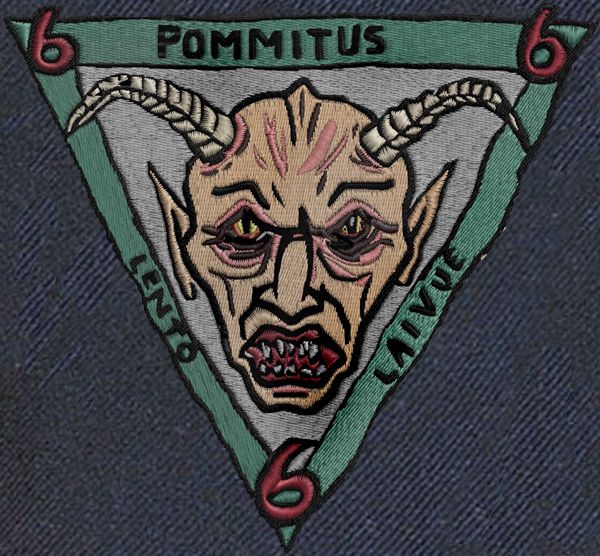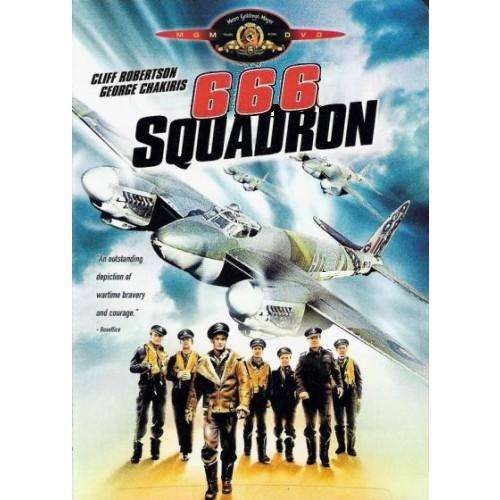You are using an out of date browser. It may not display this or other websites correctly.
You should upgrade or use an alternative browser.
You should upgrade or use an alternative browser.
What If - Finland had been prepared for the Winter War?
- Thread starter CanKiwi
- Start date
You just made my unit crest invalid, thank you so much
Edited: I corrected the crest.
My mistake originally!
However, "Originally sketched free-hand in a rare moment of quiet shortly after the commencement of hostilities between the SU and (as it then seemed) little defenceless Finland by then-Yliluutnantti Erkki Tempponen, the B/N of the squadron CO's plane (who was unfortunately dyslexic and to the amusement of the rest of the squadron personnel, always had problems with his spelling - and as a result was the butt of many jokes - the original drawing reflected this, but while the spelling was correct on almost every aircraft in the Squadron, Tempponen's was painted with his original spelling to the amusement of everyone, including Tempponen, who had long learned to live with the problem).
The corrected unit crest is shown previously, Temponnen (who over the course of the war became known by the nickname of Temppunen, "the Tricky!"). Temponnen's original, complete with dyslexix spelling, is shown below. Below is a scan of the original paper sketch on display at the Finnish Winter War museum in Tampere"
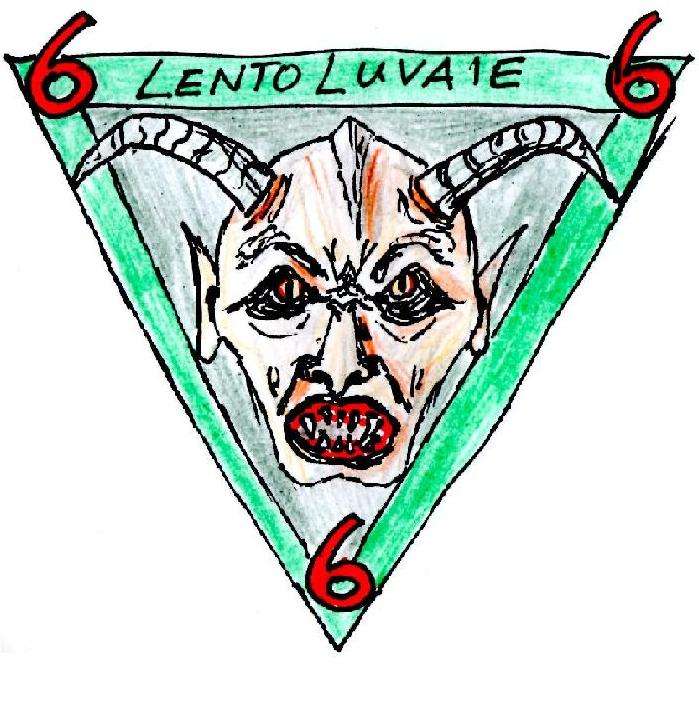
BTW, thx again for these Jotun, this is a classic unit crest - and I was planning a bit of Finnish heavy metal later on in the actual war!
Why shouldn't they. I imagine this could well be a tradition copied from the Brits or Americans pre-war...
Is that an actual patch you made or a computer-generated approximation?Awesome!
I believe there were some unit patches worn in uniforms, but checking to see. In any case, this is an ATL and if not, they can sure wear them in this timeline
Thanks to you both for the outstanding artwork......
and from axishistory where I also post this thread...
by John Hilly on Today, 19:04
An ugly looking bastard indeed!
Must be "Vanha Vihtahousu" - "The Old Devil Himself"!
Again a Finnish expression almost impossible to translate.
Terveisin...............Juha-Pekka
“Die Blechtrommel trommelt noch !!“
Redrawn clearly, vectorized and computer generated with a special prog that turns vector graphics into stitchings, and a bit of photoshop. The fabric background is a bit of the M27 finnish air force uniform. ( http://www.rathbonemuseum.com/FINN/FINM27Lt/FINM27LT.html )
Feel free to use it.
Feel free to use it.
Radios / Signals in the Suomen Maavoimat - Part I
The early origins of Radio
It’s hard to imagine what military communications were like before the radio, which in turn was derived from the electric telegraph – which in turn had its origins in the earlier optical semaphore systems. Such optical signal systems have been in existence in one form or another for centuries and were faster than the physical transfer of messages by horse-rider or runner. The distance thry could bridge was however limited by geography and weather; thus, in practical use, most optical semaphore systems used lines of relay stations to bridge longer distances. The first comprehensive non-electric optical semaphore telegraph system was invented by Claude Chappe for the French military in 1794. This system was visual and used semaphore, a flag-based alphabet, depended on a line of sight for communication and was widely adopted across Europe for both commercial and military use. They succeeded in covering France with a network of 556 stations stretching a total distance of 4,800 kilometres which was used for military and national communications until the 1850s.
Sweden was the second country in the world, after France, to introduce an optical sempahore network. The Swedish network was restricted to the archipelagoes of Stockholm, Gothenburg and Karlskrona. Like its French counterpart, it was mainly used for military purposes. In the UK, Lord George Murray, stimulated by reports of the Chappe semaphore, proposed a system of visual telegraphy to the British Admiralty in 1795. A Rev. Mr Gamble also proposed two alternative systems in the same year. The British Admiralty accepted Murray's system in September 1795, and the first system was the 15 site chain from London to Deal. Messages passed from London to Deal in about sixty seconds (a distance of 68 miles), and sixty-five sites were in use by 1808. Once it had proved its success, the optical semaphore system was imitated in many other countries, especially after it was used by Napoleon to coordinate his empire and army. In most of these countries, the postal authorities operated the semaphore lines.
In Canada, the first semaphore line in North America was in operation by 1800, running between the city of Halifax and the town of Annapolis in Nova Scotia, and across the Bay of Fundy to Saint John and Fredericton in New Brunswick. In 1801, the Danish post office installed a semaphore line across the Great Belt strait, Storebæltstelegrafen, between the islands Funen and Zealand with stations at Nyborg on Funen, on the small island Sprogø in the middle of the strait, and at Korsør on Zealand. It was in use until 1865. The Kingdom of Prussia began with a line 750 kilometres long between Berlin and Coblenz in 1833, and in Russia, Tsar Nicolas I inaugurated the line between Moscow and Warsaw (1200 km) in 1833; this needed 220 stations manned by 1320 operators. In the United States the first semaphore system was a 104-kilometre line connecting Martha's Vineyard with Boston, and its purpose was to transmit news about shipping. One of the principal hills in San Francisco, California is also named "Telegraph Hill", after the semaphore telegraph which was established there in 1849 to signal the arrival of ships into San Francisco Bay.
The semaphores were successful enough that Samuel Morse failed to sell the electrical telegraph to the French government. However, France finally committed to replace semaphores with electric telegraphs in 1846. The last stationary semaphore link in regular service was in Sweden, connecting an island to a mainland telegraph line. It finally went out of service in 1880. In general terms, the old sempahore systems were quickly superceded by electric telegraph systems after these became commercially viable. While today the electric telegraph is a virtually forgotten and outdated communication system that transmitted electric signals over wires from location to location that translated into a message, 130 years ago it was as revolutionary as the Internet is today and was the direct ancestor of both the telephone and the radio – two devices that revolutionsed military communications.
While the electric telegraph itself had its origins some 250 years ago (in 1746 the French scientist, Abbé Jean-Antoine Nollet, gathered about two hundred monks into a circle about a mile (1.6 km) in circumference, with pieces of iron wire connecting them. He then discharged a battery of Leyden jars through the human chain and observed that each man reacted at substantially the same time to the electric shock, showing that the speed of electricity's propagation was very high) and there were many intermediate steps along the way, it only became a commercially practical means of communication in the 1840’s. Knowledge and commercial application of the telegraph percolated quickly throughout North America and Europe, and development of the technology was rapid. In the UK, the electric telegraph entered commercial use on the Great Western Railway over the 13 miles (21 km) from Paddington station to West Drayton on 9 April 1839 while in the USA, the first commercial telegraph line in the United States ran along a railroad right-of-way between Lancaster and Harrisburg, Pennsylvania in 1845. Dispatching trains by telegraph started in the USA in 1851, the same year Western Union began business. On 24 October 1861, the first transcontinental telegraph system was established. Spanning North America, an existing network in the eastern United States was connected to the small network in California by a link between Omaha and Carson City via Salt Lake City.
Experiments with a transatlantic telegraph cable began in 1857 and 1858, but these failed after only a few days or weeks – but by 1866 a working transatlantic telegraph cable was successfully in operation. Within 29 years of its first commercial introduction, the telegraph network connected every continent in the world except Antarctica, making instant global communication possible for the first time. The telegraph thus liberated information transfer from transportation.
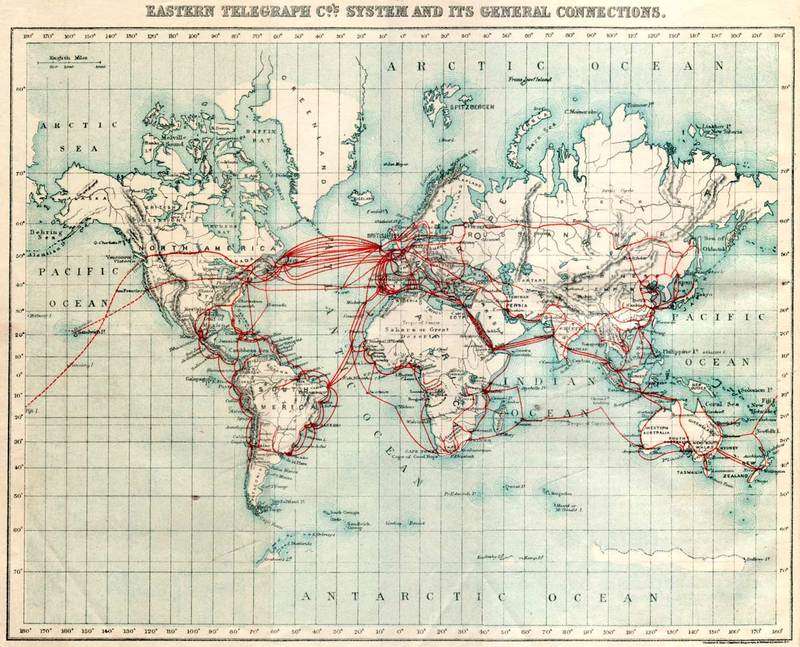
World Map of Undersea Cables from 1901
Early military utilization of the Electric Telegraph
Military organizations were quick to see the utility of the electric telegraph, with the first such recorded use in war being during the Crimean War between Russia, Britain and France. A combined British and French force landed in the Crimea and began a long-term siege of the city and naval base of Sebastopol. Britian, the home of the “Industrial Revolution” put its industrial skills to use in warfare through a series of different applications of engineering knowhow - the railway contractor Morton Peto and his partner Thomas Brassey created a Railway Construction Corps from their own army of labourers and built a full-scale railway from the base port at Balaklava to the front line. The mining industry in Leeds contributed two steam engines to work it. Joseph Paxton, architect of the Crystal Palace, organised an Army Works Corps to erect a township of wooden huts to protect the troops in the bitter winter. I K Brunel, the railway engineer, designed and had built a huge hospital from prefabricated components. William Fairbairn, the ironmaster and shipbuilder, constructed a pair of floating workshops to undertake all manner of repair and maintenance tasks for the besieging army.
The telegraph companies and their suppliers joined in with this war euphoria. In late 1854, the government in London created a military Telegraph Detachment for the Army commanded by an officer of the Royal Engineers. It was to comprise twenty-five men from the Royal Corps of Sappers & Miners, a cadre of which were trained by the Electric Telegraph Company to construct and work the first Field Electric Telegraph, as it was called.
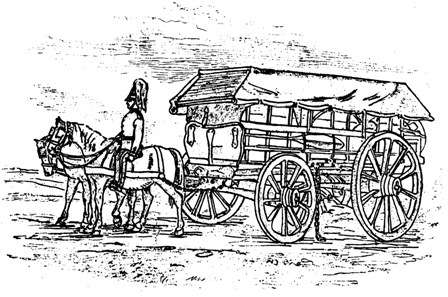
The Electric Telegraph Company’s War Wagon 1854: The outfit for the first war telegraph, usually hauled by three pair of horses, even had a gutta percha boat inverted on the top. The sketch shows a heavy cavalry trooper riding postillion rather than a sapper.
The Telegraph Detachment’s lines allowed Lord Raglan (the C-in-C) to communicate within a few minutes with his generals at any time and the Telegraph Detachment eventually possessed eight Field Electric Telegraph stations, 24 miles of line around Sebastopol, connecting the Headquarters, Kazach, the Monastery, the Engineer Park, the Right Attack, the Light Division, Kadikoi and Balaklava.. A temporary 310 mile long submarine cable also connected British headquarters in Balaklava to Varna in Turkish Bulgaria. This connected to the European circuits via a French Army-built land line to existing Austrian circuits at Bucharest, hence to London and Paris in autumn 1855. A cable for the British government was also run from Varna direct to Constantinople, the Turkish capital, where another land circuit existed to Vienna and the European capitals.
After the Crimea, the British Army rapidly adopted the electrical telegraph for internal communication in its fortresses at Malta and then at Gibraltar, then elsewhere in the late 1850s. Three years after the Crimean War, in the Indian Mutiny, the newly established telegraph, which was controlled by the British, was a deciding factor. The Royal Engineers also despatched telegraph detachments, similar to those assembled for the Crimea, with the expeditions to China in 1859 and Hazara in Afghanistan during 1868. The French Empire had learned from observing their allies in the British Army during the Crimea war and for their brief and bloody campaign in northern Italy against Austria in 1859 they organised a “service télégraphiques” which laid 400 kilometres of line and created thirty-five telegraph stations along the advance to keep the army in touch with metropolitan France. It was claimed that at the decisive battle of Solferino on June 24, 1859 “the movement of the whole army was known and regulated like clockwork” by telegraph.
Between October 1859 and April 1860 Spain was at war with Morocco, with an army under General Leopoldo O’Donnell based from the Spanish enclave of Ceuta. The Royal government in Madrid commissioned a war telegraph, the largest element of which was a 25 mile underwater cable linking the mainland at Tarifa, near Algeciras, across the Mediterranean to Ceuta on the Moroccan coast. Use was also made of Field Telegraph detachments.
(please note that most of the above military telegraph information was sourced from http://distantwriting.co.uk/default.aspx, “A History of the Telegraph Companies in Britain between 1838 and 1868 by Robert Stevens – the site has a vast amount of really interested information on the Electric Telegraph in Britain)
In the American Civil War (1861–65), wide use was made of the electric telegraph. In addition to its employment in spanning long distances under the civilian-manned military telegraph organization, a mobile field service was provided in the Union army by wagon trains equipped with insulated wire and lightweight poles for the rapid laying of telegraph lines. Immediately before and during the Civil War visual signaling also received added impetus through the development of a system applying the Morse code of dots and dashes that spelled out messages with flags by day and lights or torches by night. Another development for light signaling placed a movable shutter, controlled by a key, in front of a strong light. An operator, opening and closing the shutter, could produce short and long flashes to spell out messages in Morse code.
Simultaneously, the Prussian and French armies also organized mobile telegraph trains. During the short, decisive Prussian campaign against Austria in 1866, field telegraphs enabled Count Helmuth von Moltke, the Prussian commander, to exercise command over his distant armies. Soon afterward the British organized their first permanent field telegraph units in the Royal Engineers. Until 1877, all rapid long-distance communication depended upon the telegraph. That year, a rival technology developed that would again change the face of communication -- the telephone. The invention of the telephone in 1876 was not followed immediately by its adoption and adaptation for military use. This was probably due to the fact that the compelling stimulation of war was not present and to the fact that the development of reliable long-distance telephone communication was not achieved for many years. The telephone was used by the U.S. Army in the Spanish-American War, by the British in the South African (Boer) War, and by the Japanese in the Russo-Japanese War. This military use was not extensive, and it made little material contribution to the development of voice telephony. Before the outbreak of World War I, military adaptation of the telephone did take place, but its period of growth had not yet arrived.
Near the close of the 19th century, a new means of military signal communication made its appearance—the wireless telegraph, or radio. The major powers throughout the world were quick to see the wonderful possibilities for military and naval signaling. Development was rapid and continuous, and, by 1914, it was adopted and in extensive use by all the armies and navies of the world. It soon became apparent that wireless telegraphy was not an unmixed blessing to armies and navies, because it lacked secrecy and messages could be heard by the enemy as well as by friendly forces. This led to the development of extensive and complicated codes and ciphers as necessary adjuncts to military signaling. The struggle between the cryptographer and the cryptanalyst expanded greatly with the adoption of radio and continued to be a major factor affecting its military use.
Military usage and evolution of telephone and radios in WW1
The onset of World War I found the opposing armies equipped to a varying degree with modern means of signal communication but with little appreciation of the enormous load that signal systems must carry to maintain control of the huge forces that were set in motion. The organization and efficiency of the armies varied greatly. At one end of the scale was Great Britain, with a small but highly developed signal service; and at the other end stood Russia, with a signal service inferior to that of the Union Army at the close of the American Civil War. The fact that commanders could not control, coordinate, and direct huge modern armies without efficient signal communication quickly became apparent to both the Allies and the Central Powers. The Germans, despite years of concentration on the Schlieffen Plan, failed to provide adequately for communication between higher headquarters and the rapidly marching armies of the right wing driving through Belgium and northern France. This resulted in a lack of coordination between these armies, which caused a miscarriage of the plan, a forced halt in the German advance, and the subsequent withdrawal north of the Marne. On the Allied side, the debacle of the Russian forces in East Prussia — a crushing defeat of the Starist Russian Army at the hands of General Paul von Hindenburg in the Battle of Tannenberg — was in large part due to an almost total lack of effective signals communication by the Russian forces.
As the war progressed there was a growing appreciation of the need for improved electrical communications of much greater capacity for the larger units and of the need within regiments for electrical communications, which had heretofore been regarded as unessential and impractical. Field telephones and switchboards were soon developed, and those already in existence were improved. An intricate system of telephone lines involving thousands of miles of wire soon appeared on each side. Pole lines with many crossarms and circuits came into being in the rear of the opposing armies, and buried cables and wires were laid in the elaborate trench systems leading to the forwardmost outposts. The main arteries running from the rear to the forward trenches were crossed by lateral cable routes roughly parallel to the front. Thus, there grew an immense gridwork of deep buried cables, particularly on the German side and in the British sectors of the Allied side, with underground junction boxes and test points every few hundred yards. The French used deep buried cable to some extent but generally preferred to string their telephone lines on wooden supports set against the walls of deep open trenches. Thus electrical communication in the form of the telephone and telegraph gradually extended to the smaller units until front-line platoons were frequently kept in touch with their company headquarters through these mediums.

Radio Equipment in a WW1 Dugout
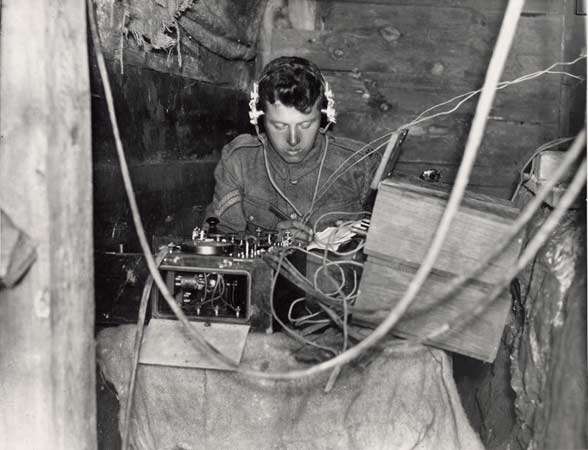
Marconi Trench Set

Marconi Motorcycle Set
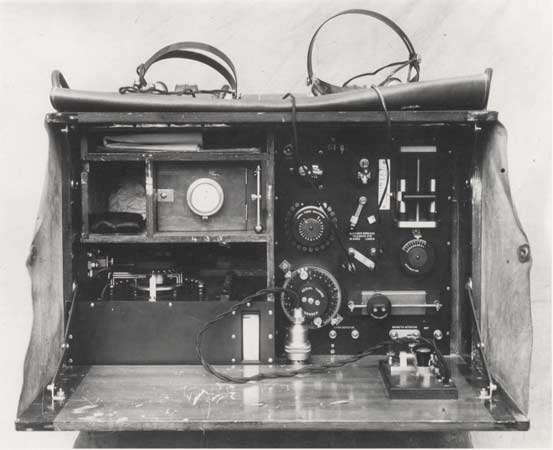
Marconi Pack Set
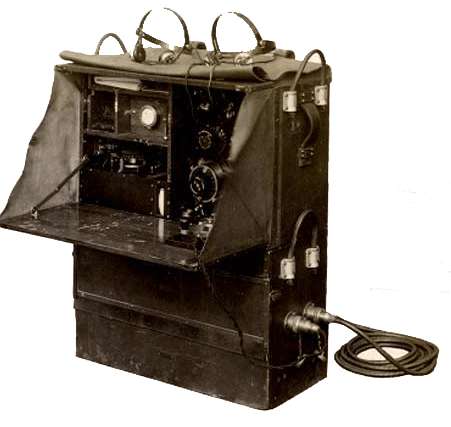
Marconi Wireless Pack Set
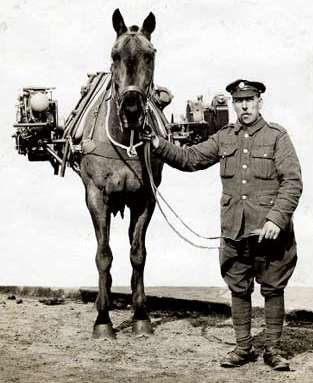
Marconi Horse Set
Despite efforts to protect the wire lines, they were frequently cut at critical times as the result of the intense artillery fire. This led all the belligerents to develop and use radio (wireless) as an alternate means of communication. Prewar radio sets were too heavy and bulky to be taken into the trenches, and they also required large and highly visible aerials. Radio engineers of the belligerent nations soon developed smaller and more portable sets powered by storage batteries and using low, inconspicuous aerials. Although radio equipment came to be issued to the headquarters of all units, including battalions, the ease of enemy interception, the requirements for cryptographing or encoding messages, and the inherent unreliability of these early systems caused them to be regarded as strictly auxiliary to the wire system and reserved for emergency use when the wire lines were cut. Visual signaling returned to the battlefield in World War I with the use of electric signal lamps. Pyrotechnics, rockets, Very pistols, and flares had a wide use for transmitting prearranged signals. Messenger service came to be highly developed, and motorcycle, bicycle, and automobile messenger service was employed. Homing pigeons were used extensively as one-way messengers from front to rear and acquitted themselves extremely well. Dogs were also used as messengers and, in the German army, reached a high degree of efficiency.
A new element in warfare, the airplane, introduced in World War I, immediately posed a problem in communication. During most of the war, communication between ground and air was difficult and elementary. To make his reports the pilot had to land or drop messages, and he received instructions while in the air from strips of white and black cloth called “panels” laid out in an open field according to prearranged designs. Extensive efforts were made to use radiotelegraph and radiotelephone between the airplanes and ground headquarters. The closing stages of the war saw many planes equipped with radio, but the service was never entirely satisfactory or reliable and had little influence on military operations. During World War I however, wireless telegraph (radio) communication was employed extensively by the navies of the world and had a major influence on the character of naval warfare. High-powered shore and ship stations made wireless communication over long distances possible. One of the war lessons learned by most of the major nations was the compelling need for scientific research and development of radio equipment and techniques for military purposes.
An over-view of Inter-war Developments.
Although the amount of funds devoted to military development during the period from World War I to World War II was relatively small, the modest expenditures served to establish a bond between industry, science, and the armed forces of the major nations. Of great importance in postwar radio communication was the pioneering by amateurs and by industry and science in the use of very high frequencies. These developments opened up to the armed services the possibilities of portable short-range equipment for mobile and portable tactical use by armies, navies, and air forces. Military work in these fields was carried out actively in Germany, Great Britain and the United States among others. Of the major powers, Germany as early as 1938 had completed the design and manufacture of a complete line of portable and mobile radio equipment for its army and air force.
Between World Wars I and II the printing telegraph, commonly known as the teleprinter or teletypewriter machine, came into civilian use and was incorporated in military wire-communication systems, but military networks were not extensive. Before World War II, military radioteleprinter circuits were nonexistent. Another major communication advance that had its origin and early growth during the period between World Wars I and II was frequency-modulated (FM) radio. Developed during the late 1920s and early 1930s by Edwin H. Armstrong, an inventor and a major in the U.S. Army Signal Corps during World War I, this new method of modulation offered heretofore unattainable reduction of the effect of ignition and other noises encountered in radios used in vehicles. It was first adapted for military use by the U.S. Army, which, prior to World War II, had under development tank, vehicular, and man-pack frequency-modulated radio transmitters and receivers. The British Army had also conducted a series of combined arms exercises with radios which, while largely ignored by the British Army, were assessed and analysed by others - such as the Germans (and the Finns, as we will see).
On the eve of World War II, all nations employed generally similar methods for military signaling. The messenger systems included foot, mounted, motorcycle, automobile, airplane, homing pigeon, and the messenger dog. Visual agencies included flags, lights, panels for signaling airplanes, and pyrotechnics. The electrical agencies embraced wire systems providing telephone and telegraph service, including the printing telegraph. Both radiotelephony and radiotelegraphy were in wide use, but radio-telephony had not as yet proved reliable and satisfactory for tactical military communication. The navies of the world entered World War II with highly developed radio communication systems, both telegraph and telephone, and with development under way of many electronic navigational aids. Blinker-light signaling was still used. The use of telephone systems and loud-speaking voice amplifiers on naval vessels had also come into common use. Air forces employed wire and radio communication to link up their bases and landing fields and had developed airborne long-range, medium-range, and short-range radio equipment for air-to-ground and air-to-air communication.
Suomen Maavoimat Signals and Radio
Please note that the content of this and subsequent Posts as far as OTL Finnish Army Radio and Signal’s equipment (and photos) is concerned is largely sourced from Antero Tanninen’s wonderfully detailed website, http://personal.inet.fi/koti/antero.tanninen/ - and more specifically, http://personal.inet.fi/koti/antero.tanninen/Radiotaulukko.htm - and is reused with Antero’s permission. If you’re interested in Finnish Radio equipment, Antero’s site goes into this subject in far greater detail than I’ve used – the content is primarily in Finnish but if you use Google Translate, you’ll get a pretty good idea of what it’s all about.
Suomen Maavoimat Signals units in the 1920’s
Within the Suomen Maavoimat, Signals units largely originated from the experience of the Finnish Jaeger movement within the German Army, as the Tsarist Russian Army allowed only infantry units for the military of the Grand Duchy of Finland, with no technical branches authorised. Consequently, there was no passing down of the Russian military expertise and experience with military communications, such as it was, into the Army of the nacent Finnish Republic on its formation. On independance from the Russian Empire, the ex-Tsarist Army Finnish officers largely came from the Infantry, Cavalry and Artillery branches only, while the Maavoimat’s technical branches were largely established by former Jaegers based on their German training and knowledge. Suomen Maavoimat Signals units were as a consequence primarily based on the experience and training of the Communications Section of the Finnish 27th Jaeger Battalion of the WWI German Army. The Jaegers returned to Finland in February 1918 and formed the Jaeger Kenttälennätinpataljoona (Field Telegraph Battalion) to meet Finnish Civil War needs. Initially, a significant part of their activities consisted of establish Field Telegraph stations (Kenttälennätinasemat) and running cables to connect field telephones.
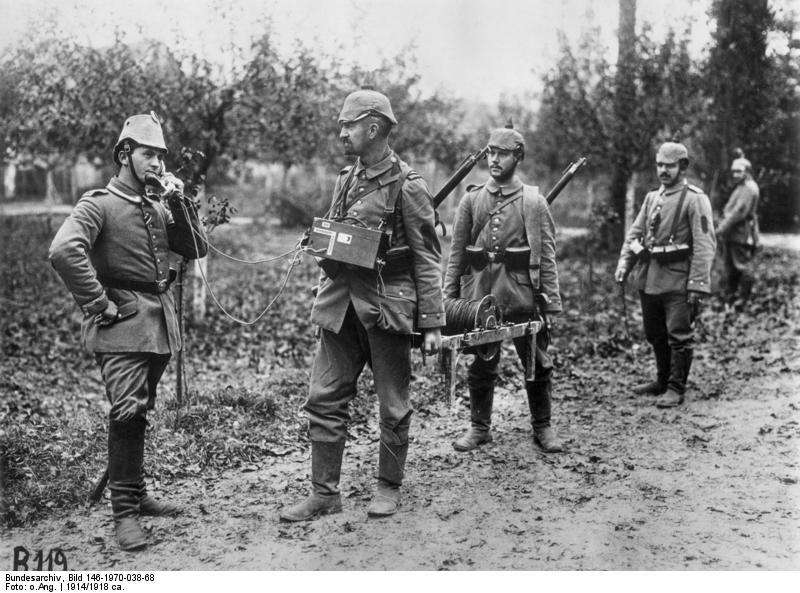
WWI Field Telephone Team
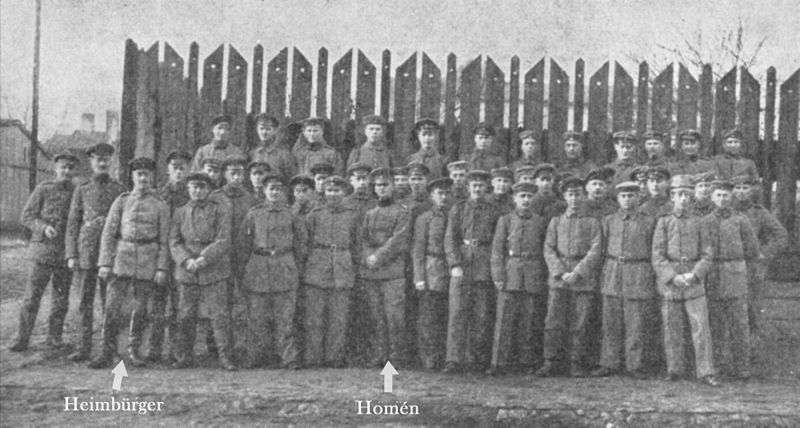
The Communication Section of the 27th Jaeger Battalion, commanded by Lars Homén and Eric Heimbürger (we will see more of Eric Heimbürger during the Winter War).
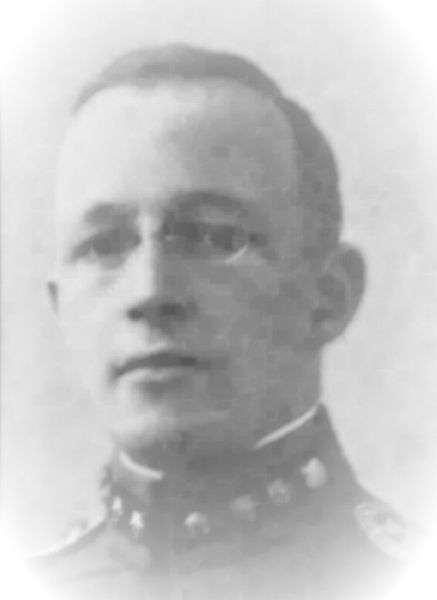
Eric Alexander Amandus Heimbürger (1888 - 1954):
Eric Alexander Amandus Heimbürger (Espoo, June 16, 1888 - February 1, 1954) was a Finnish Jaeger Colonel. His parents were the ownera of a manor, Nicolai Heimbürger and Therese von Jessen. Heimbürger completed matriculation at the Nya Svenska Läroverket in Helsinki in 1908 and then joined the Uusimaa Students' Association. He studied at the University Law Faculty in 1908-1909 and then at the University of Technology mechanical engineering department from 1909-1912, followed by a further year at the Karlsruhe Institute of Technology. Heimbürger joined one of the first groups of volunteers whose goal was to go to Germany for military training purposes and then fight for Finnish independance. He enrolled on 25 March 1915 and trained in northern Germany in the Lockstedter Lager training area. Initially he was placed in 1 Komppaniaan of the Prussian Jaeger Battalion 2. On 2 October 1917, he was transferred from the 1st Komppaniaan, together with 53 other men, to the battalion's Signals unit, where he served as the Finnish unit commander. He took part in a number of battles on the German Eastern Front, including Misse River, the Gulf of Riga and the Aa River. In the Spring of 1917, Heimbürger ran courses at Libau on Signals and was later moved to Commander of the Battalion’s Radio unit.
Heimbürger arrived in Finland (Vaasa), with the main group of Jaeger troops and was promoted to the rank of Senior Lieutenant on 25 February 1918. During the Civil War, ge was assigned commander of the 15th Jaeger Battalion 1st Company, after which he was transferred on 6 April 1918 to Headquarters as the Signals Commander. On 5 June 1918 he was moved to the General Staff and appointed Signals Force Commander. He worked as the supervisor of Signals courses, which in July 1918 were implemented in Helsinki. He taught Officer courses in 1920 and was a teacher on Signals at the Cadet School from 1919 to 1926. On 22 March 1920 he was ttransferred to military forces headquarters and placed in charge of Signals and on 8 December 1920 he was made Inspector of Technical Staff.
Heimbürger was the armed forces representative on the Telegraph Committee in 1919 and was a member of the Radio Committee in 1920 and also a member of the Committee responsible for planning the number and strength of bicycle troops in 1922. In 1923 he was a member of the Committee which drew up the proposals for the strength of the Telephone / Signals Troops and was Signals Troops honor court chairman in 1921. He was married in 1924, to Aune Emilia-Rekolan. Heimbürger was also posted to Lithuania in the 1924 period. In addition, he completed the General Staff course over 1927-1929. In April 1927 he was the Senior Staff teacher for Signals at the Military Academy. On 31 October 1927 he was appointed head of the Separate Signals Company (Kenttälennätin Komppanian, later the Independent Signals Battalion, where he was again Commanding Officer).
From 1 July 1933 he was appopinted to Army Corps headquarters, where he was Pioneer and Signals Commander. He also carryied out Chief of Staff duties in 1925. Over the Winter War, Heimbürger was Signals Commander for one of the Army Corps, then was appointed to Military Headquarters, during which time he made several trips abroad. He held this position until 1947, when he resigned from active service. He is buried in the Hietaniemi Cemetery, Helsinki.
The establishment of the Light Field Radio Department
In April 1918 a Field Radio Department was established and took over the radio stations in Helsinki and Suomenlinna from the Russian garrison troops. The unit also restored the former Santahamina fixed radio station which had been used by the Russian Baltic Fleet. The radio-type taken over from the Russians was a Telefunken with a 10W power level and a range which stretched from the Baltic Sea region to as far as Austria. Also during the Finnish Civil War, Suojeluskuntas Signals units were setup at Santahamina where radio stations were assembled. Their first commander was Jaeger Lieutenant Karl Edvard Nyström who in June 1918 formed the Field Radio Department (which later that year was changed to Field Radio Division).
Karl Edvard Nyström (born July 8 1894, Kokkola - March 1, 1964, Helsinki) was the child of copper smith Solomon Fredrik Nyström, and Edla Amanda Sandstrom. He received his early education at the Swedish School in Kokkola, then worked as a Telegrapher before travelling to Germany and joining the Finnish 27th Jaeger Battalion (2 Company). In December 1915 he was transferred to the Battalion’s Signals unit, going on to take part in battles on the Misse River , the Gulf of Riga and the Aa River over 1916, where he had his baptism of fire. In 1917 he organized special courses at Libau, before returning to Finland in December 1917 on the second trip of the S/S Equity, which carried many of the members of Jääkäripataljoona 27 from Germany back to Finland. On arrival in Finland, he traveled to Vaasa, where he trained Suojeluskuntas men from the the local and surrounding area in Signals work.
He participated in the civil war as Column Deputy Director for the seizing of Vaasa. After the takeover of Vaasa, he was assigned to the Vaasa Radio and Telegraph station on 7 February 1918. On 24 April 1918, he was transferred to Headquarters at Mikkeli. From Mikkeli, he was transferred to Viipuri as the station manager on 2 May 1918. In the post-Civil War period Nyström continued to serve as the Viipuri station manager, until 1 August 1918 when he was appointed Signals Company Commander, and then on 1 September 1921 temporary commander of the Signals Battalion. He was married in 1924 to Sigrid Maria Adelia Johanssonin and went on to complete further military educational courses in 1925. Nyström resigned from the army on 28 May 1926, having reached the rank of Major.
After leaving the Army, Nyström worked for Reko Ltd from 1927 to 1928. He later worked in a number of positions, including as a warehouse manager (from 1934 to 1935). During the Winter War, Nyström served in IV Corps Headquarters, later moving to Coastal Battalion 4 and then to a position as deputy CO of the Signals School. Following the Winter War, he served as an officer in the home office staff of the Army and was released from military service in 1942, after which he worked at a Machinery company and then as a businessman in Helsinki. He died in 1964 and was buried in Helsinki.
...To be continued......
The early origins of Radio
It’s hard to imagine what military communications were like before the radio, which in turn was derived from the electric telegraph – which in turn had its origins in the earlier optical semaphore systems. Such optical signal systems have been in existence in one form or another for centuries and were faster than the physical transfer of messages by horse-rider or runner. The distance thry could bridge was however limited by geography and weather; thus, in practical use, most optical semaphore systems used lines of relay stations to bridge longer distances. The first comprehensive non-electric optical semaphore telegraph system was invented by Claude Chappe for the French military in 1794. This system was visual and used semaphore, a flag-based alphabet, depended on a line of sight for communication and was widely adopted across Europe for both commercial and military use. They succeeded in covering France with a network of 556 stations stretching a total distance of 4,800 kilometres which was used for military and national communications until the 1850s.
Sweden was the second country in the world, after France, to introduce an optical sempahore network. The Swedish network was restricted to the archipelagoes of Stockholm, Gothenburg and Karlskrona. Like its French counterpart, it was mainly used for military purposes. In the UK, Lord George Murray, stimulated by reports of the Chappe semaphore, proposed a system of visual telegraphy to the British Admiralty in 1795. A Rev. Mr Gamble also proposed two alternative systems in the same year. The British Admiralty accepted Murray's system in September 1795, and the first system was the 15 site chain from London to Deal. Messages passed from London to Deal in about sixty seconds (a distance of 68 miles), and sixty-five sites were in use by 1808. Once it had proved its success, the optical semaphore system was imitated in many other countries, especially after it was used by Napoleon to coordinate his empire and army. In most of these countries, the postal authorities operated the semaphore lines.
In Canada, the first semaphore line in North America was in operation by 1800, running between the city of Halifax and the town of Annapolis in Nova Scotia, and across the Bay of Fundy to Saint John and Fredericton in New Brunswick. In 1801, the Danish post office installed a semaphore line across the Great Belt strait, Storebæltstelegrafen, between the islands Funen and Zealand with stations at Nyborg on Funen, on the small island Sprogø in the middle of the strait, and at Korsør on Zealand. It was in use until 1865. The Kingdom of Prussia began with a line 750 kilometres long between Berlin and Coblenz in 1833, and in Russia, Tsar Nicolas I inaugurated the line between Moscow and Warsaw (1200 km) in 1833; this needed 220 stations manned by 1320 operators. In the United States the first semaphore system was a 104-kilometre line connecting Martha's Vineyard with Boston, and its purpose was to transmit news about shipping. One of the principal hills in San Francisco, California is also named "Telegraph Hill", after the semaphore telegraph which was established there in 1849 to signal the arrival of ships into San Francisco Bay.
The semaphores were successful enough that Samuel Morse failed to sell the electrical telegraph to the French government. However, France finally committed to replace semaphores with electric telegraphs in 1846. The last stationary semaphore link in regular service was in Sweden, connecting an island to a mainland telegraph line. It finally went out of service in 1880. In general terms, the old sempahore systems were quickly superceded by electric telegraph systems after these became commercially viable. While today the electric telegraph is a virtually forgotten and outdated communication system that transmitted electric signals over wires from location to location that translated into a message, 130 years ago it was as revolutionary as the Internet is today and was the direct ancestor of both the telephone and the radio – two devices that revolutionsed military communications.
While the electric telegraph itself had its origins some 250 years ago (in 1746 the French scientist, Abbé Jean-Antoine Nollet, gathered about two hundred monks into a circle about a mile (1.6 km) in circumference, with pieces of iron wire connecting them. He then discharged a battery of Leyden jars through the human chain and observed that each man reacted at substantially the same time to the electric shock, showing that the speed of electricity's propagation was very high) and there were many intermediate steps along the way, it only became a commercially practical means of communication in the 1840’s. Knowledge and commercial application of the telegraph percolated quickly throughout North America and Europe, and development of the technology was rapid. In the UK, the electric telegraph entered commercial use on the Great Western Railway over the 13 miles (21 km) from Paddington station to West Drayton on 9 April 1839 while in the USA, the first commercial telegraph line in the United States ran along a railroad right-of-way between Lancaster and Harrisburg, Pennsylvania in 1845. Dispatching trains by telegraph started in the USA in 1851, the same year Western Union began business. On 24 October 1861, the first transcontinental telegraph system was established. Spanning North America, an existing network in the eastern United States was connected to the small network in California by a link between Omaha and Carson City via Salt Lake City.
Experiments with a transatlantic telegraph cable began in 1857 and 1858, but these failed after only a few days or weeks – but by 1866 a working transatlantic telegraph cable was successfully in operation. Within 29 years of its first commercial introduction, the telegraph network connected every continent in the world except Antarctica, making instant global communication possible for the first time. The telegraph thus liberated information transfer from transportation.

World Map of Undersea Cables from 1901
Early military utilization of the Electric Telegraph
Military organizations were quick to see the utility of the electric telegraph, with the first such recorded use in war being during the Crimean War between Russia, Britain and France. A combined British and French force landed in the Crimea and began a long-term siege of the city and naval base of Sebastopol. Britian, the home of the “Industrial Revolution” put its industrial skills to use in warfare through a series of different applications of engineering knowhow - the railway contractor Morton Peto and his partner Thomas Brassey created a Railway Construction Corps from their own army of labourers and built a full-scale railway from the base port at Balaklava to the front line. The mining industry in Leeds contributed two steam engines to work it. Joseph Paxton, architect of the Crystal Palace, organised an Army Works Corps to erect a township of wooden huts to protect the troops in the bitter winter. I K Brunel, the railway engineer, designed and had built a huge hospital from prefabricated components. William Fairbairn, the ironmaster and shipbuilder, constructed a pair of floating workshops to undertake all manner of repair and maintenance tasks for the besieging army.
The telegraph companies and their suppliers joined in with this war euphoria. In late 1854, the government in London created a military Telegraph Detachment for the Army commanded by an officer of the Royal Engineers. It was to comprise twenty-five men from the Royal Corps of Sappers & Miners, a cadre of which were trained by the Electric Telegraph Company to construct and work the first Field Electric Telegraph, as it was called.

The Electric Telegraph Company’s War Wagon 1854: The outfit for the first war telegraph, usually hauled by three pair of horses, even had a gutta percha boat inverted on the top. The sketch shows a heavy cavalry trooper riding postillion rather than a sapper.
The Telegraph Detachment’s lines allowed Lord Raglan (the C-in-C) to communicate within a few minutes with his generals at any time and the Telegraph Detachment eventually possessed eight Field Electric Telegraph stations, 24 miles of line around Sebastopol, connecting the Headquarters, Kazach, the Monastery, the Engineer Park, the Right Attack, the Light Division, Kadikoi and Balaklava.. A temporary 310 mile long submarine cable also connected British headquarters in Balaklava to Varna in Turkish Bulgaria. This connected to the European circuits via a French Army-built land line to existing Austrian circuits at Bucharest, hence to London and Paris in autumn 1855. A cable for the British government was also run from Varna direct to Constantinople, the Turkish capital, where another land circuit existed to Vienna and the European capitals.
After the Crimea, the British Army rapidly adopted the electrical telegraph for internal communication in its fortresses at Malta and then at Gibraltar, then elsewhere in the late 1850s. Three years after the Crimean War, in the Indian Mutiny, the newly established telegraph, which was controlled by the British, was a deciding factor. The Royal Engineers also despatched telegraph detachments, similar to those assembled for the Crimea, with the expeditions to China in 1859 and Hazara in Afghanistan during 1868. The French Empire had learned from observing their allies in the British Army during the Crimea war and for their brief and bloody campaign in northern Italy against Austria in 1859 they organised a “service télégraphiques” which laid 400 kilometres of line and created thirty-five telegraph stations along the advance to keep the army in touch with metropolitan France. It was claimed that at the decisive battle of Solferino on June 24, 1859 “the movement of the whole army was known and regulated like clockwork” by telegraph.
Between October 1859 and April 1860 Spain was at war with Morocco, with an army under General Leopoldo O’Donnell based from the Spanish enclave of Ceuta. The Royal government in Madrid commissioned a war telegraph, the largest element of which was a 25 mile underwater cable linking the mainland at Tarifa, near Algeciras, across the Mediterranean to Ceuta on the Moroccan coast. Use was also made of Field Telegraph detachments.
(please note that most of the above military telegraph information was sourced from http://distantwriting.co.uk/default.aspx, “A History of the Telegraph Companies in Britain between 1838 and 1868 by Robert Stevens – the site has a vast amount of really interested information on the Electric Telegraph in Britain)
In the American Civil War (1861–65), wide use was made of the electric telegraph. In addition to its employment in spanning long distances under the civilian-manned military telegraph organization, a mobile field service was provided in the Union army by wagon trains equipped with insulated wire and lightweight poles for the rapid laying of telegraph lines. Immediately before and during the Civil War visual signaling also received added impetus through the development of a system applying the Morse code of dots and dashes that spelled out messages with flags by day and lights or torches by night. Another development for light signaling placed a movable shutter, controlled by a key, in front of a strong light. An operator, opening and closing the shutter, could produce short and long flashes to spell out messages in Morse code.
Simultaneously, the Prussian and French armies also organized mobile telegraph trains. During the short, decisive Prussian campaign against Austria in 1866, field telegraphs enabled Count Helmuth von Moltke, the Prussian commander, to exercise command over his distant armies. Soon afterward the British organized their first permanent field telegraph units in the Royal Engineers. Until 1877, all rapid long-distance communication depended upon the telegraph. That year, a rival technology developed that would again change the face of communication -- the telephone. The invention of the telephone in 1876 was not followed immediately by its adoption and adaptation for military use. This was probably due to the fact that the compelling stimulation of war was not present and to the fact that the development of reliable long-distance telephone communication was not achieved for many years. The telephone was used by the U.S. Army in the Spanish-American War, by the British in the South African (Boer) War, and by the Japanese in the Russo-Japanese War. This military use was not extensive, and it made little material contribution to the development of voice telephony. Before the outbreak of World War I, military adaptation of the telephone did take place, but its period of growth had not yet arrived.
Near the close of the 19th century, a new means of military signal communication made its appearance—the wireless telegraph, or radio. The major powers throughout the world were quick to see the wonderful possibilities for military and naval signaling. Development was rapid and continuous, and, by 1914, it was adopted and in extensive use by all the armies and navies of the world. It soon became apparent that wireless telegraphy was not an unmixed blessing to armies and navies, because it lacked secrecy and messages could be heard by the enemy as well as by friendly forces. This led to the development of extensive and complicated codes and ciphers as necessary adjuncts to military signaling. The struggle between the cryptographer and the cryptanalyst expanded greatly with the adoption of radio and continued to be a major factor affecting its military use.
Military usage and evolution of telephone and radios in WW1
The onset of World War I found the opposing armies equipped to a varying degree with modern means of signal communication but with little appreciation of the enormous load that signal systems must carry to maintain control of the huge forces that were set in motion. The organization and efficiency of the armies varied greatly. At one end of the scale was Great Britain, with a small but highly developed signal service; and at the other end stood Russia, with a signal service inferior to that of the Union Army at the close of the American Civil War. The fact that commanders could not control, coordinate, and direct huge modern armies without efficient signal communication quickly became apparent to both the Allies and the Central Powers. The Germans, despite years of concentration on the Schlieffen Plan, failed to provide adequately for communication between higher headquarters and the rapidly marching armies of the right wing driving through Belgium and northern France. This resulted in a lack of coordination between these armies, which caused a miscarriage of the plan, a forced halt in the German advance, and the subsequent withdrawal north of the Marne. On the Allied side, the debacle of the Russian forces in East Prussia — a crushing defeat of the Starist Russian Army at the hands of General Paul von Hindenburg in the Battle of Tannenberg — was in large part due to an almost total lack of effective signals communication by the Russian forces.
As the war progressed there was a growing appreciation of the need for improved electrical communications of much greater capacity for the larger units and of the need within regiments for electrical communications, which had heretofore been regarded as unessential and impractical. Field telephones and switchboards were soon developed, and those already in existence were improved. An intricate system of telephone lines involving thousands of miles of wire soon appeared on each side. Pole lines with many crossarms and circuits came into being in the rear of the opposing armies, and buried cables and wires were laid in the elaborate trench systems leading to the forwardmost outposts. The main arteries running from the rear to the forward trenches were crossed by lateral cable routes roughly parallel to the front. Thus, there grew an immense gridwork of deep buried cables, particularly on the German side and in the British sectors of the Allied side, with underground junction boxes and test points every few hundred yards. The French used deep buried cable to some extent but generally preferred to string their telephone lines on wooden supports set against the walls of deep open trenches. Thus electrical communication in the form of the telephone and telegraph gradually extended to the smaller units until front-line platoons were frequently kept in touch with their company headquarters through these mediums.

Radio Equipment in a WW1 Dugout

Marconi Trench Set

Marconi Motorcycle Set

Marconi Pack Set

Marconi Wireless Pack Set

Marconi Horse Set
Despite efforts to protect the wire lines, they were frequently cut at critical times as the result of the intense artillery fire. This led all the belligerents to develop and use radio (wireless) as an alternate means of communication. Prewar radio sets were too heavy and bulky to be taken into the trenches, and they also required large and highly visible aerials. Radio engineers of the belligerent nations soon developed smaller and more portable sets powered by storage batteries and using low, inconspicuous aerials. Although radio equipment came to be issued to the headquarters of all units, including battalions, the ease of enemy interception, the requirements for cryptographing or encoding messages, and the inherent unreliability of these early systems caused them to be regarded as strictly auxiliary to the wire system and reserved for emergency use when the wire lines were cut. Visual signaling returned to the battlefield in World War I with the use of electric signal lamps. Pyrotechnics, rockets, Very pistols, and flares had a wide use for transmitting prearranged signals. Messenger service came to be highly developed, and motorcycle, bicycle, and automobile messenger service was employed. Homing pigeons were used extensively as one-way messengers from front to rear and acquitted themselves extremely well. Dogs were also used as messengers and, in the German army, reached a high degree of efficiency.
A new element in warfare, the airplane, introduced in World War I, immediately posed a problem in communication. During most of the war, communication between ground and air was difficult and elementary. To make his reports the pilot had to land or drop messages, and he received instructions while in the air from strips of white and black cloth called “panels” laid out in an open field according to prearranged designs. Extensive efforts were made to use radiotelegraph and radiotelephone between the airplanes and ground headquarters. The closing stages of the war saw many planes equipped with radio, but the service was never entirely satisfactory or reliable and had little influence on military operations. During World War I however, wireless telegraph (radio) communication was employed extensively by the navies of the world and had a major influence on the character of naval warfare. High-powered shore and ship stations made wireless communication over long distances possible. One of the war lessons learned by most of the major nations was the compelling need for scientific research and development of radio equipment and techniques for military purposes.
An over-view of Inter-war Developments.
Although the amount of funds devoted to military development during the period from World War I to World War II was relatively small, the modest expenditures served to establish a bond between industry, science, and the armed forces of the major nations. Of great importance in postwar radio communication was the pioneering by amateurs and by industry and science in the use of very high frequencies. These developments opened up to the armed services the possibilities of portable short-range equipment for mobile and portable tactical use by armies, navies, and air forces. Military work in these fields was carried out actively in Germany, Great Britain and the United States among others. Of the major powers, Germany as early as 1938 had completed the design and manufacture of a complete line of portable and mobile radio equipment for its army and air force.
Between World Wars I and II the printing telegraph, commonly known as the teleprinter or teletypewriter machine, came into civilian use and was incorporated in military wire-communication systems, but military networks were not extensive. Before World War II, military radioteleprinter circuits were nonexistent. Another major communication advance that had its origin and early growth during the period between World Wars I and II was frequency-modulated (FM) radio. Developed during the late 1920s and early 1930s by Edwin H. Armstrong, an inventor and a major in the U.S. Army Signal Corps during World War I, this new method of modulation offered heretofore unattainable reduction of the effect of ignition and other noises encountered in radios used in vehicles. It was first adapted for military use by the U.S. Army, which, prior to World War II, had under development tank, vehicular, and man-pack frequency-modulated radio transmitters and receivers. The British Army had also conducted a series of combined arms exercises with radios which, while largely ignored by the British Army, were assessed and analysed by others - such as the Germans (and the Finns, as we will see).
On the eve of World War II, all nations employed generally similar methods for military signaling. The messenger systems included foot, mounted, motorcycle, automobile, airplane, homing pigeon, and the messenger dog. Visual agencies included flags, lights, panels for signaling airplanes, and pyrotechnics. The electrical agencies embraced wire systems providing telephone and telegraph service, including the printing telegraph. Both radiotelephony and radiotelegraphy were in wide use, but radio-telephony had not as yet proved reliable and satisfactory for tactical military communication. The navies of the world entered World War II with highly developed radio communication systems, both telegraph and telephone, and with development under way of many electronic navigational aids. Blinker-light signaling was still used. The use of telephone systems and loud-speaking voice amplifiers on naval vessels had also come into common use. Air forces employed wire and radio communication to link up their bases and landing fields and had developed airborne long-range, medium-range, and short-range radio equipment for air-to-ground and air-to-air communication.
Suomen Maavoimat Signals and Radio
Please note that the content of this and subsequent Posts as far as OTL Finnish Army Radio and Signal’s equipment (and photos) is concerned is largely sourced from Antero Tanninen’s wonderfully detailed website, http://personal.inet.fi/koti/antero.tanninen/ - and more specifically, http://personal.inet.fi/koti/antero.tanninen/Radiotaulukko.htm - and is reused with Antero’s permission. If you’re interested in Finnish Radio equipment, Antero’s site goes into this subject in far greater detail than I’ve used – the content is primarily in Finnish but if you use Google Translate, you’ll get a pretty good idea of what it’s all about.
Suomen Maavoimat Signals units in the 1920’s
Within the Suomen Maavoimat, Signals units largely originated from the experience of the Finnish Jaeger movement within the German Army, as the Tsarist Russian Army allowed only infantry units for the military of the Grand Duchy of Finland, with no technical branches authorised. Consequently, there was no passing down of the Russian military expertise and experience with military communications, such as it was, into the Army of the nacent Finnish Republic on its formation. On independance from the Russian Empire, the ex-Tsarist Army Finnish officers largely came from the Infantry, Cavalry and Artillery branches only, while the Maavoimat’s technical branches were largely established by former Jaegers based on their German training and knowledge. Suomen Maavoimat Signals units were as a consequence primarily based on the experience and training of the Communications Section of the Finnish 27th Jaeger Battalion of the WWI German Army. The Jaegers returned to Finland in February 1918 and formed the Jaeger Kenttälennätinpataljoona (Field Telegraph Battalion) to meet Finnish Civil War needs. Initially, a significant part of their activities consisted of establish Field Telegraph stations (Kenttälennätinasemat) and running cables to connect field telephones.

WWI Field Telephone Team

The Communication Section of the 27th Jaeger Battalion, commanded by Lars Homén and Eric Heimbürger (we will see more of Eric Heimbürger during the Winter War).

Eric Alexander Amandus Heimbürger (1888 - 1954):
Eric Alexander Amandus Heimbürger (Espoo, June 16, 1888 - February 1, 1954) was a Finnish Jaeger Colonel. His parents were the ownera of a manor, Nicolai Heimbürger and Therese von Jessen. Heimbürger completed matriculation at the Nya Svenska Läroverket in Helsinki in 1908 and then joined the Uusimaa Students' Association. He studied at the University Law Faculty in 1908-1909 and then at the University of Technology mechanical engineering department from 1909-1912, followed by a further year at the Karlsruhe Institute of Technology. Heimbürger joined one of the first groups of volunteers whose goal was to go to Germany for military training purposes and then fight for Finnish independance. He enrolled on 25 March 1915 and trained in northern Germany in the Lockstedter Lager training area. Initially he was placed in 1 Komppaniaan of the Prussian Jaeger Battalion 2. On 2 October 1917, he was transferred from the 1st Komppaniaan, together with 53 other men, to the battalion's Signals unit, where he served as the Finnish unit commander. He took part in a number of battles on the German Eastern Front, including Misse River, the Gulf of Riga and the Aa River. In the Spring of 1917, Heimbürger ran courses at Libau on Signals and was later moved to Commander of the Battalion’s Radio unit.
Heimbürger arrived in Finland (Vaasa), with the main group of Jaeger troops and was promoted to the rank of Senior Lieutenant on 25 February 1918. During the Civil War, ge was assigned commander of the 15th Jaeger Battalion 1st Company, after which he was transferred on 6 April 1918 to Headquarters as the Signals Commander. On 5 June 1918 he was moved to the General Staff and appointed Signals Force Commander. He worked as the supervisor of Signals courses, which in July 1918 were implemented in Helsinki. He taught Officer courses in 1920 and was a teacher on Signals at the Cadet School from 1919 to 1926. On 22 March 1920 he was ttransferred to military forces headquarters and placed in charge of Signals and on 8 December 1920 he was made Inspector of Technical Staff.
Heimbürger was the armed forces representative on the Telegraph Committee in 1919 and was a member of the Radio Committee in 1920 and also a member of the Committee responsible for planning the number and strength of bicycle troops in 1922. In 1923 he was a member of the Committee which drew up the proposals for the strength of the Telephone / Signals Troops and was Signals Troops honor court chairman in 1921. He was married in 1924, to Aune Emilia-Rekolan. Heimbürger was also posted to Lithuania in the 1924 period. In addition, he completed the General Staff course over 1927-1929. In April 1927 he was the Senior Staff teacher for Signals at the Military Academy. On 31 October 1927 he was appointed head of the Separate Signals Company (Kenttälennätin Komppanian, later the Independent Signals Battalion, where he was again Commanding Officer).
From 1 July 1933 he was appopinted to Army Corps headquarters, where he was Pioneer and Signals Commander. He also carryied out Chief of Staff duties in 1925. Over the Winter War, Heimbürger was Signals Commander for one of the Army Corps, then was appointed to Military Headquarters, during which time he made several trips abroad. He held this position until 1947, when he resigned from active service. He is buried in the Hietaniemi Cemetery, Helsinki.
The establishment of the Light Field Radio Department
In April 1918 a Field Radio Department was established and took over the radio stations in Helsinki and Suomenlinna from the Russian garrison troops. The unit also restored the former Santahamina fixed radio station which had been used by the Russian Baltic Fleet. The radio-type taken over from the Russians was a Telefunken with a 10W power level and a range which stretched from the Baltic Sea region to as far as Austria. Also during the Finnish Civil War, Suojeluskuntas Signals units were setup at Santahamina where radio stations were assembled. Their first commander was Jaeger Lieutenant Karl Edvard Nyström who in June 1918 formed the Field Radio Department (which later that year was changed to Field Radio Division).
Karl Edvard Nyström (born July 8 1894, Kokkola - March 1, 1964, Helsinki) was the child of copper smith Solomon Fredrik Nyström, and Edla Amanda Sandstrom. He received his early education at the Swedish School in Kokkola, then worked as a Telegrapher before travelling to Germany and joining the Finnish 27th Jaeger Battalion (2 Company). In December 1915 he was transferred to the Battalion’s Signals unit, going on to take part in battles on the Misse River , the Gulf of Riga and the Aa River over 1916, where he had his baptism of fire. In 1917 he organized special courses at Libau, before returning to Finland in December 1917 on the second trip of the S/S Equity, which carried many of the members of Jääkäripataljoona 27 from Germany back to Finland. On arrival in Finland, he traveled to Vaasa, where he trained Suojeluskuntas men from the the local and surrounding area in Signals work.
He participated in the civil war as Column Deputy Director for the seizing of Vaasa. After the takeover of Vaasa, he was assigned to the Vaasa Radio and Telegraph station on 7 February 1918. On 24 April 1918, he was transferred to Headquarters at Mikkeli. From Mikkeli, he was transferred to Viipuri as the station manager on 2 May 1918. In the post-Civil War period Nyström continued to serve as the Viipuri station manager, until 1 August 1918 when he was appointed Signals Company Commander, and then on 1 September 1921 temporary commander of the Signals Battalion. He was married in 1924 to Sigrid Maria Adelia Johanssonin and went on to complete further military educational courses in 1925. Nyström resigned from the army on 28 May 1926, having reached the rank of Major.
After leaving the Army, Nyström worked for Reko Ltd from 1927 to 1928. He later worked in a number of positions, including as a warehouse manager (from 1934 to 1935). During the Winter War, Nyström served in IV Corps Headquarters, later moving to Coastal Battalion 4 and then to a position as deputy CO of the Signals School. Following the Winter War, he served as an officer in the home office staff of the Army and was released from military service in 1942, after which he worked at a Machinery company and then as a businessman in Helsinki. He died in 1964 and was buried in Helsinki.
...To be continued......
A quick look at the overall state of Maavoimat Signals in late 1939
Before we go on to look at Signals equipment and Signals units, primarily of the Maavoimat, we'll first take a quick look at the overall state of Maavoimat Signals in late 1939
The overall state of Maavoimat Signals in late 1939
To understand just how effective the Suomen Maavoimat’s communication systems were in 1939, and the advantage that they gave to the Finnish military in battle, it is necessary to have a basic understanding of the state of military communications at the time. Today, it is almost impossible to understand what it was like to operate without an effective means of rapid communication. But even today, the Fog of War can descend on a battlefield, rendering headquarters out of touch with subordinate units and unable to make timely decisions based on up to the minute information. The practical experience of the fog of war is most easily demonstrated in the tactical battlespace. It may include military commanders' incomplete or inaccurate intelligence about the enemy's numbers, disposition, capabilities, and intent, regarding features of the battlefield, and incomplete knowledge of the state of their own forces. Fog of war is caused by the limits of reconnaissance, by the enemy's feints and disinformation, by delays in receiving intelligence and difficulties passing orders, and by the difficult task of forming a cogent picture from a very large (or very small) amount of diverse data. The Maavoimat was very much aware of this, as was every military in theory. The difference however, was that the Maavoimat had studied and theorized the problem, then actively sought ways to lift the fog for their own forces, and thicken it for the enemy.
In late 1939, the primary combat formation of the Suoment Maavoimat was the Regimental Battle Group, an over-sized Brigade formation which incorporated infantry, artillery, support units, the use of close air support and, where available and necessary for specific operations, armoured formations and other supporting units. The development of the highly flexible combined arms Regimental Battle Group by the Suomen Maavoimat had been an evolutionary process through the 1930’s, initially based on experimentation in exercises and then at the last incorporating a large dose of practical experience from the involvement of the Finnish Volunteers in the Spanish Civil War. Both the exercises and the experiences in the crucible of Spain had graphically illustrated both the advantages and necessities of real-time communication within units at all levels. With a high degree of emphasis on mobility, the tactical offensive and rapid attacks and withdrawals, all of which required a high degree of coordination, the Suomen Maavoimat had from 1932 on placed a remarkable and ongoing emphasis on the development of effective communications systems.
Within the Suomen Maavoimat, portable radio sets were provided as far down in the military echelons as the infantry company – and in many cases down to the infantry platoon. In every tank there was at least one radio and in some command tanks as many as three – as there were with artillery batteries. High-powered mobile radio sets equipped Headquarters Units at Army Group, Divisional, Regimental Battle Group and Battalion level. With these sets radio communications could be conducted at distances of more than 100 miles (160 kilometres) with vehicles in normal motion on the road. Multiconductor cables were provided for wire communications; they could be reeled out rapidly and as many as four conversations could take place on them simultaneously through the use of carrier telephony. The Germans had been the first to use this type of military long-range cable, and their example was followed promptly by the Finns, who kept in close contact with German telephone and radio equipment developments. Major telephone switchboards of much greater capacity were needed and had been developed, manufactured and issued for use at all tactical headquarters to satisfy the need for the greatly increased number of telephone channels required to coordinate the movements of highly mobile field units.
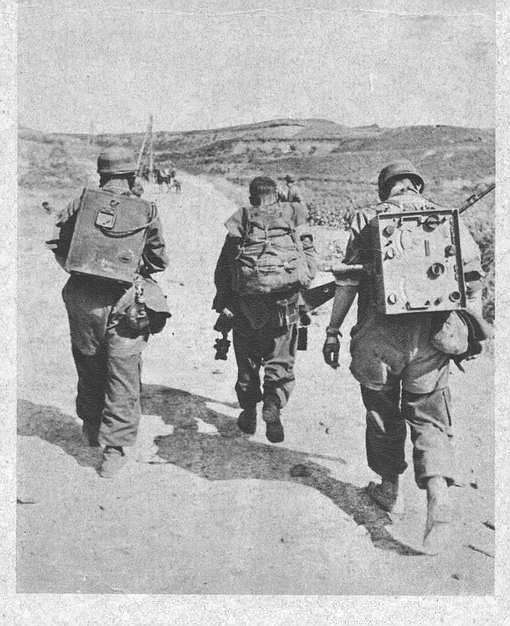
A Maavoimat ParaJaeger Signals Team on a route march, Lapland, Summer 1939. Similar 3-man Radio Teams were a part of every Infantry unit down to the Company and at times the Platoon level and would form the backbone of the Maavoimat’s front-line communications network through the Winter War, considerably enhancing the combat effectiveness of Finland’s soldiers.
On the outbreak of the Winter War, the Suomen Maavoimat also possessed a highly capable Signals Intelligence unit which we will cover in detail when we review the Maavoimat’s major units in a later Post. Seperately, we will also look at a further initiative of the Signals Intelligence which would have a major impact on the air war in the later stages of the Winter War. Likewise, the Ilmavoimat possessed a highly capable photographic reconnaissance unit, while the Artillery and Air Support Observer Aircraft provided a highly effective coverage of front-line areas and the immediate enemy rear. In addition, there were also the Maavoimat’s highly effective Deep Recconnaisance Teams who operated far behind the enemy’s front lines, providing strategic information to Military Headquarters to great effect and communicating using the outstanding (and top-secret) Finnish-designed and developed “Kynnel” Radio.
The Maavoimat to a large extent emphasized small-unit fighting – with the exception of the Karelian Isthmus, the forest, lake and swamp terrain of much of Finland lent itself to small-unit maneouvering and fighting with combined arms teams operating in small semi-autonomous groups but with the ability to quickly regroup and work together to fight major engagements. The tactics developed by the Maavoimat in the late 1930’s resembled what we would now call “swarming” – combat teams cooperating closely through simple decision rules, a shared situational awareness and the ability to communicate planned actions and call in artillery and with close air support virtually on demand. The essence of the strategy was to create psychological shock and resultant disorganization in enemy forces through the employment of surprise, speed, and localised superiority in firepower. Tested by the Finnish Volunteers during the Spanish Civil War over the period 1937-38, the tactic proved to be a formidable combination of land and air action. The essence of the tehcnique was the use of mobility, shock, and locally concentrated firepower in skillfully coordinated attacks to paralyze an adversary’s capacity to coordinate his own defenses, rather than attempting to physically overcome them, and then to exploit this paralysis.
During the Spanish Civil War, the Ilmavoimat’s leading theorist and commander of the Finnish Volunteer air force units, Richard “Zimbo” Lorentz, conceptualized the combat process and applied this to the logic of military operations, both tactical and strategic. As Lorentz stated, “In order to win, we should operate at a faster tempo or rhythm than our adversaries - or, better yet, get inside our adversary's “Havaita-Punnita-Ratkaisu-Taistelu (Perceive-Weigh in one’s mind-Solution-Combat Action) loop. ... Such activity will make us appear unpredictable and thereby generate confusion and disorder among our adversaries--since our adversaries will be unable to adapt to the faster rhythm of combat they are competing against. ….. The key is to obscure our intentions and make them unpredictable to our opponent while we simultaneously clarify his intentions. That is, we operate at a faster tempo to generate rapidly changing conditions that inhibit our opponent from adapting or reacting to those changes while suppressing or destroying his awareness. Thus, a hodgepodge of confusion and disorder occurs to cause him to over- or under-react to conditions or activities that appear to be uncertain, ambiguous, or incomprehensible. The proper mindset is to work with the chaos of the battlefield, allow this to become part of our thought system, and to use it to our advantage by simply creating more chaos and confusion for the opponent. We will funnel the inevitable chaos of the battlefield in the direction of the enemy and use this to our advantage.”
The primary observation made by Lorentz was that at both a strategic and tactical level it was important to think, decide and act faster than the enemy could think and act – i.e., “get inside our adversary's “Havaita-Punnita-Ratkaisu-Taistelu” loop and thereby producing opportunities for the enemy to react inappropriately. The approach favored agility over raw power and as such, was a further step in the development of the Maavoimat’s combat doctrine and again, emphasized excellent communications as a co-requisite of the tactics. The pervasiveness of portable radios at all levels together with an excellent field telephone network within the Maavoimat on the outbreak of the Winter War combined with superb air-based strategic and tactical reconnaissance (reconnaissance photos were generally available for analysis within an hour of the aircraft landing and the results available to front-line units shortly thereafter. The Ilmavoimat / Maavoimat aerial mapping service for example was so good that it usually took on average of only 48 hours from taking the picture to distributing printed maps to the troops) made this possible.
The same doctrine of creating psychological shock and resultant disorganization in the enemy forces that drove the improvement and pervasiveness of the Maavoimat’s communications network would go on to drive the formation of a range of what we now call “special forces” units within the Maavoimat, some focused on reconnaissance and some on attacks against the enemy rear – with one specific mission focus being the identification and annihilation of headquarters units, either through identification and elimination by close air support or artillery, or via direct action. The cutting of the enemy’s communications and logistical supply lines was another important mission of these units. Other (far smaller) units focused on misdirection and misinformation. “Mannerheims Wizards: The Finnish Genius for Deception 1939-1945” (Otava, 1975), describes Finnish military deception activities through WW2. The Finnish military enlisted the aid of an array of Finnish artists, film-makers, stage designers from theatres and as well as an array of scientists and oddballs to conceal, confuse and mislead. For example, to mislead Soviet bombers at night, an entire “false Helsinki” was created. Near the frontlines, dummy artillery positions were built using painted wooden mockups. Real defensive positions of all types were carefully concealed while “fake” defensive positions were created. “Fake” airfields complete with mockup aircraft were created to draw Soviet air force attacks and special attention was also paid to individual vehicle and team-manned weapons concealment as well as to individual camflauge (the well-known whiter smocks the Finnish soldiers wore during the Winter of 1939-40 were only one aspect of this concealment strategy).
Most films at this time were made under cover, but so good were the film crews that they could make sets look very realistic. With lighting and paint and mock ups of buildings and streets many an audience watching a film would have never guessed it had been made entirely under cover, the main reason of making films this way was the weather was not reliable enough to make them outside on location, and film equipment at that time was not so robust as now. The film men from the Finnish film industry became the backbone of this unit, where they mass produced dummy aircraft and equipment to be used on decoy airfield sites as well as items such as dummy tanks and artillery and even complete Infantry Divisions.
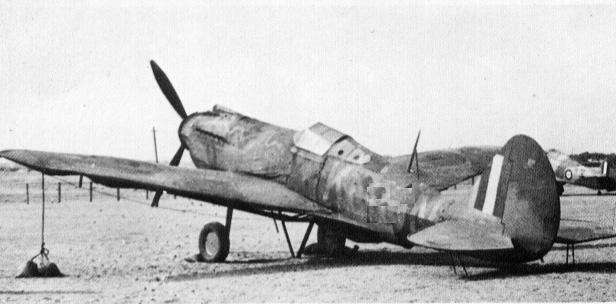
Dummy Ilmavoimat Hurricane built for a fake airfield: Summer 1940 (the dummy aircraft was constructed from wood, canvas and paint and was designed to look completely realistic from the air). The Soviet Air Force wasted some 80% of their attacks on Ilmavoimat airfields on such dummy targets.
On the front line, the Maavoimat placed a strong emphasis on the use of trained snipers to eliminate the enemy command structure – and as we will see when we review the Maavoimat’s structure, all infantry units down to the Platoon included specialist sniper teams. But that’s an aside to the main thrust of this Post, which has been to illustrate the Communications equipment used by the Maavoimat in the Winter War, and the pervasiveness of the Maavoimat’s radio and telephone communications network.
However, returning to Communications, over the course of the Winter War, the Maavoimat’s communications network would prove to be both reliable and robust, proving as effective as the Maavoimat had hoped it would based on the experience of the volunteers in Spain. Radio research and development would continue after the end of the Winter War, largely undertaken by Nokia, who by the end of WW2 would prove to be a world leader in such technology. But the end result in the Winter War was that the Maavoimat generally operated in an environment where real-time communication between all units down to at least the Company level was in effect, resulting in two-way traffic where information was fed up the line to Headquarters units, movement was by and large closely coordinated, and without communication time-lags coordinate movement of unitscould occur rapidly while requests for Artillery and Close Air Support were generally also responded to rapidly. On the Karelian Isthmus in particular, calls for artillery support were generally responded too within 30-60 seconds while close air support was often available on call and at worst (weather permitting) within 30 minutes.
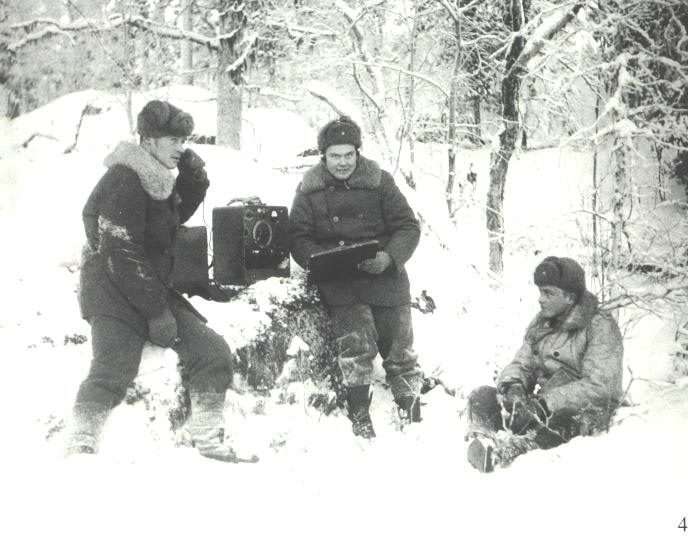 http://img11.imageshack.us/img11/6053/dradioartillery1.jpg
http://img11.imageshack.us/img11/6053/dradioartillery1.jpg
"The D-radio, range for telegraphic communication 20km and for voice 12km, was used for artillery fire control. The photograph is from an artillery observation post. Finnish Artillery units trained their own Signals personnel for Signals duties. There was a Forward Artillery Observer Team assigned to each Infantry Company, usually an NCO and 2 men, each of whom was trained in artillery fire control techniques as well as in taking care of the radio and connections. This team was in addition to the Company’s own Signals personnel (meaning that on the whole, their were 2 Radios per Company at a minimum – and where Platoons were equipped with Radios, there were at times up to 5 Radios per Company, although this was the exception and not the Rule, given that a Radio Team consisted of 3 men."
Conversely, the Maavoimat did their best to ensure that the Red Army operated in a fog of no, or misleading information. Communications were cut wherever possible, headquarters units were attacked, Red Army commanders were targeted, officers and NCO’s were primary targets on the front. All in all, this combination gave the Maavoimat a real tactical advantage, which was only achieved through a decade of analysis, exercises, planning, testing and the experience of the Finnish volunteers in the crucible of the Spanish Civil War. But it was an advantage that would prove to be critical in the days to come.
In the next Post, we’ll look at the Maavoimat’s signals equipment and units….
Before we go on to look at Signals equipment and Signals units, primarily of the Maavoimat, we'll first take a quick look at the overall state of Maavoimat Signals in late 1939
The overall state of Maavoimat Signals in late 1939
To understand just how effective the Suomen Maavoimat’s communication systems were in 1939, and the advantage that they gave to the Finnish military in battle, it is necessary to have a basic understanding of the state of military communications at the time. Today, it is almost impossible to understand what it was like to operate without an effective means of rapid communication. But even today, the Fog of War can descend on a battlefield, rendering headquarters out of touch with subordinate units and unable to make timely decisions based on up to the minute information. The practical experience of the fog of war is most easily demonstrated in the tactical battlespace. It may include military commanders' incomplete or inaccurate intelligence about the enemy's numbers, disposition, capabilities, and intent, regarding features of the battlefield, and incomplete knowledge of the state of their own forces. Fog of war is caused by the limits of reconnaissance, by the enemy's feints and disinformation, by delays in receiving intelligence and difficulties passing orders, and by the difficult task of forming a cogent picture from a very large (or very small) amount of diverse data. The Maavoimat was very much aware of this, as was every military in theory. The difference however, was that the Maavoimat had studied and theorized the problem, then actively sought ways to lift the fog for their own forces, and thicken it for the enemy.
In late 1939, the primary combat formation of the Suoment Maavoimat was the Regimental Battle Group, an over-sized Brigade formation which incorporated infantry, artillery, support units, the use of close air support and, where available and necessary for specific operations, armoured formations and other supporting units. The development of the highly flexible combined arms Regimental Battle Group by the Suomen Maavoimat had been an evolutionary process through the 1930’s, initially based on experimentation in exercises and then at the last incorporating a large dose of practical experience from the involvement of the Finnish Volunteers in the Spanish Civil War. Both the exercises and the experiences in the crucible of Spain had graphically illustrated both the advantages and necessities of real-time communication within units at all levels. With a high degree of emphasis on mobility, the tactical offensive and rapid attacks and withdrawals, all of which required a high degree of coordination, the Suomen Maavoimat had from 1932 on placed a remarkable and ongoing emphasis on the development of effective communications systems.
Within the Suomen Maavoimat, portable radio sets were provided as far down in the military echelons as the infantry company – and in many cases down to the infantry platoon. In every tank there was at least one radio and in some command tanks as many as three – as there were with artillery batteries. High-powered mobile radio sets equipped Headquarters Units at Army Group, Divisional, Regimental Battle Group and Battalion level. With these sets radio communications could be conducted at distances of more than 100 miles (160 kilometres) with vehicles in normal motion on the road. Multiconductor cables were provided for wire communications; they could be reeled out rapidly and as many as four conversations could take place on them simultaneously through the use of carrier telephony. The Germans had been the first to use this type of military long-range cable, and their example was followed promptly by the Finns, who kept in close contact with German telephone and radio equipment developments. Major telephone switchboards of much greater capacity were needed and had been developed, manufactured and issued for use at all tactical headquarters to satisfy the need for the greatly increased number of telephone channels required to coordinate the movements of highly mobile field units.

A Maavoimat ParaJaeger Signals Team on a route march, Lapland, Summer 1939. Similar 3-man Radio Teams were a part of every Infantry unit down to the Company and at times the Platoon level and would form the backbone of the Maavoimat’s front-line communications network through the Winter War, considerably enhancing the combat effectiveness of Finland’s soldiers.
On the outbreak of the Winter War, the Suomen Maavoimat also possessed a highly capable Signals Intelligence unit which we will cover in detail when we review the Maavoimat’s major units in a later Post. Seperately, we will also look at a further initiative of the Signals Intelligence which would have a major impact on the air war in the later stages of the Winter War. Likewise, the Ilmavoimat possessed a highly capable photographic reconnaissance unit, while the Artillery and Air Support Observer Aircraft provided a highly effective coverage of front-line areas and the immediate enemy rear. In addition, there were also the Maavoimat’s highly effective Deep Recconnaisance Teams who operated far behind the enemy’s front lines, providing strategic information to Military Headquarters to great effect and communicating using the outstanding (and top-secret) Finnish-designed and developed “Kynnel” Radio.
The Maavoimat to a large extent emphasized small-unit fighting – with the exception of the Karelian Isthmus, the forest, lake and swamp terrain of much of Finland lent itself to small-unit maneouvering and fighting with combined arms teams operating in small semi-autonomous groups but with the ability to quickly regroup and work together to fight major engagements. The tactics developed by the Maavoimat in the late 1930’s resembled what we would now call “swarming” – combat teams cooperating closely through simple decision rules, a shared situational awareness and the ability to communicate planned actions and call in artillery and with close air support virtually on demand. The essence of the strategy was to create psychological shock and resultant disorganization in enemy forces through the employment of surprise, speed, and localised superiority in firepower. Tested by the Finnish Volunteers during the Spanish Civil War over the period 1937-38, the tactic proved to be a formidable combination of land and air action. The essence of the tehcnique was the use of mobility, shock, and locally concentrated firepower in skillfully coordinated attacks to paralyze an adversary’s capacity to coordinate his own defenses, rather than attempting to physically overcome them, and then to exploit this paralysis.
During the Spanish Civil War, the Ilmavoimat’s leading theorist and commander of the Finnish Volunteer air force units, Richard “Zimbo” Lorentz, conceptualized the combat process and applied this to the logic of military operations, both tactical and strategic. As Lorentz stated, “In order to win, we should operate at a faster tempo or rhythm than our adversaries - or, better yet, get inside our adversary's “Havaita-Punnita-Ratkaisu-Taistelu (Perceive-Weigh in one’s mind-Solution-Combat Action) loop. ... Such activity will make us appear unpredictable and thereby generate confusion and disorder among our adversaries--since our adversaries will be unable to adapt to the faster rhythm of combat they are competing against. ….. The key is to obscure our intentions and make them unpredictable to our opponent while we simultaneously clarify his intentions. That is, we operate at a faster tempo to generate rapidly changing conditions that inhibit our opponent from adapting or reacting to those changes while suppressing or destroying his awareness. Thus, a hodgepodge of confusion and disorder occurs to cause him to over- or under-react to conditions or activities that appear to be uncertain, ambiguous, or incomprehensible. The proper mindset is to work with the chaos of the battlefield, allow this to become part of our thought system, and to use it to our advantage by simply creating more chaos and confusion for the opponent. We will funnel the inevitable chaos of the battlefield in the direction of the enemy and use this to our advantage.”
The primary observation made by Lorentz was that at both a strategic and tactical level it was important to think, decide and act faster than the enemy could think and act – i.e., “get inside our adversary's “Havaita-Punnita-Ratkaisu-Taistelu” loop and thereby producing opportunities for the enemy to react inappropriately. The approach favored agility over raw power and as such, was a further step in the development of the Maavoimat’s combat doctrine and again, emphasized excellent communications as a co-requisite of the tactics. The pervasiveness of portable radios at all levels together with an excellent field telephone network within the Maavoimat on the outbreak of the Winter War combined with superb air-based strategic and tactical reconnaissance (reconnaissance photos were generally available for analysis within an hour of the aircraft landing and the results available to front-line units shortly thereafter. The Ilmavoimat / Maavoimat aerial mapping service for example was so good that it usually took on average of only 48 hours from taking the picture to distributing printed maps to the troops) made this possible.
The same doctrine of creating psychological shock and resultant disorganization in the enemy forces that drove the improvement and pervasiveness of the Maavoimat’s communications network would go on to drive the formation of a range of what we now call “special forces” units within the Maavoimat, some focused on reconnaissance and some on attacks against the enemy rear – with one specific mission focus being the identification and annihilation of headquarters units, either through identification and elimination by close air support or artillery, or via direct action. The cutting of the enemy’s communications and logistical supply lines was another important mission of these units. Other (far smaller) units focused on misdirection and misinformation. “Mannerheims Wizards: The Finnish Genius for Deception 1939-1945” (Otava, 1975), describes Finnish military deception activities through WW2. The Finnish military enlisted the aid of an array of Finnish artists, film-makers, stage designers from theatres and as well as an array of scientists and oddballs to conceal, confuse and mislead. For example, to mislead Soviet bombers at night, an entire “false Helsinki” was created. Near the frontlines, dummy artillery positions were built using painted wooden mockups. Real defensive positions of all types were carefully concealed while “fake” defensive positions were created. “Fake” airfields complete with mockup aircraft were created to draw Soviet air force attacks and special attention was also paid to individual vehicle and team-manned weapons concealment as well as to individual camflauge (the well-known whiter smocks the Finnish soldiers wore during the Winter of 1939-40 were only one aspect of this concealment strategy).
Most films at this time were made under cover, but so good were the film crews that they could make sets look very realistic. With lighting and paint and mock ups of buildings and streets many an audience watching a film would have never guessed it had been made entirely under cover, the main reason of making films this way was the weather was not reliable enough to make them outside on location, and film equipment at that time was not so robust as now. The film men from the Finnish film industry became the backbone of this unit, where they mass produced dummy aircraft and equipment to be used on decoy airfield sites as well as items such as dummy tanks and artillery and even complete Infantry Divisions.

Dummy Ilmavoimat Hurricane built for a fake airfield: Summer 1940 (the dummy aircraft was constructed from wood, canvas and paint and was designed to look completely realistic from the air). The Soviet Air Force wasted some 80% of their attacks on Ilmavoimat airfields on such dummy targets.
On the front line, the Maavoimat placed a strong emphasis on the use of trained snipers to eliminate the enemy command structure – and as we will see when we review the Maavoimat’s structure, all infantry units down to the Platoon included specialist sniper teams. But that’s an aside to the main thrust of this Post, which has been to illustrate the Communications equipment used by the Maavoimat in the Winter War, and the pervasiveness of the Maavoimat’s radio and telephone communications network.
However, returning to Communications, over the course of the Winter War, the Maavoimat’s communications network would prove to be both reliable and robust, proving as effective as the Maavoimat had hoped it would based on the experience of the volunteers in Spain. Radio research and development would continue after the end of the Winter War, largely undertaken by Nokia, who by the end of WW2 would prove to be a world leader in such technology. But the end result in the Winter War was that the Maavoimat generally operated in an environment where real-time communication between all units down to at least the Company level was in effect, resulting in two-way traffic where information was fed up the line to Headquarters units, movement was by and large closely coordinated, and without communication time-lags coordinate movement of unitscould occur rapidly while requests for Artillery and Close Air Support were generally also responded to rapidly. On the Karelian Isthmus in particular, calls for artillery support were generally responded too within 30-60 seconds while close air support was often available on call and at worst (weather permitting) within 30 minutes.

"The D-radio, range for telegraphic communication 20km and for voice 12km, was used for artillery fire control. The photograph is from an artillery observation post. Finnish Artillery units trained their own Signals personnel for Signals duties. There was a Forward Artillery Observer Team assigned to each Infantry Company, usually an NCO and 2 men, each of whom was trained in artillery fire control techniques as well as in taking care of the radio and connections. This team was in addition to the Company’s own Signals personnel (meaning that on the whole, their were 2 Radios per Company at a minimum – and where Platoons were equipped with Radios, there were at times up to 5 Radios per Company, although this was the exception and not the Rule, given that a Radio Team consisted of 3 men."
Conversely, the Maavoimat did their best to ensure that the Red Army operated in a fog of no, or misleading information. Communications were cut wherever possible, headquarters units were attacked, Red Army commanders were targeted, officers and NCO’s were primary targets on the front. All in all, this combination gave the Maavoimat a real tactical advantage, which was only achieved through a decade of analysis, exercises, planning, testing and the experience of the Finnish volunteers in the crucible of the Spanish Civil War. But it was an advantage that would prove to be critical in the days to come.
In the next Post, we’ll look at the Maavoimat’s signals equipment and units….
Balladi punaisista bareteista
The Ballad Of The Green Berets - Balladi punaisista bareteista
OK, this is a bit off the main track but quite a few posts ago, I mentioned in a bit of a sidebar on the Maavoimat ParaJaegers that the Ballad of the Green Berets originated in Finland and was brought to Vietnam by some Finns fighting with the US Army Special Forces, where Barry Sadler plagiarised it for his hit version.
Anyhow, if I had but known of this track, I could have made it really plausible
DivShare File - Kivikasvot - Balladi punaisista bareteist.mp3
The track is from Kivikasvot - a group that was formed when the members met while serving in the army, so it's only natural that they should do this particular cover. They recorded "Balladi punaisista bareteista" (The ballad of the red berets) in 1966. It was releasd as a single but in popularity it came second to it's flipside, the cover of Beach Boys' "Barbara Ann". The lyrics were provided by Sauvo "Saukki" Puhtila. The color of the berets was changed from the original green into red, becouse at the time there were no green berets in military use in Finland. In the 60's, the berets were just introduced, the first ones being red (actually maroon), and they were handed out to Parachute Troopers after their first jump.
The Ballad Of The Green Berets - Balladi punaisista bareteista
OK, this is a bit off the main track but quite a few posts ago, I mentioned in a bit of a sidebar on the Maavoimat ParaJaegers that the Ballad of the Green Berets originated in Finland and was brought to Vietnam by some Finns fighting with the US Army Special Forces, where Barry Sadler plagiarised it for his hit version.
Anyhow, if I had but known of this track, I could have made it really plausible
DivShare File - Kivikasvot - Balladi punaisista bareteist.mp3
The track is from Kivikasvot - a group that was formed when the members met while serving in the army, so it's only natural that they should do this particular cover. They recorded "Balladi punaisista bareteista" (The ballad of the red berets) in 1966. It was releasd as a single but in popularity it came second to it's flipside, the cover of Beach Boys' "Barbara Ann". The lyrics were provided by Sauvo "Saukki" Puhtila. The color of the berets was changed from the original green into red, becouse at the time there were no green berets in military use in Finland. In the 60's, the berets were just introduced, the first ones being red (actually maroon), and they were handed out to Parachute Troopers after their first jump.
iddt3
Donor
Keep it up, I look forward to it. I've been reading your updates on the commute to work, without them I run out of reading material too quickly.For anyone following this, the next Post is coming along slowly. It will be on Signals equipment and its taking a bit of time to work up. Be sometime middle of next week before its ready to post.
While the militaries of many European countries were caught up in the turmoil of WW2 with inadequate preparation in the areas of Signals and Communications, the Suomen Maavoimat was one of the few countries that was both prepared, adequately equipped, and had incorporated the use of an extensive modern military communications network into its military doctrine. That this was the exception rather than the rule in 1939 is perhaps startling now, but was less so at the time in question. The mere possession of radios by the military does not guarantee their effective use, as the French example in 1940 in particular demonstrates. And as will see, the Suomen Maavoimat’s modern military communications network did not just happen. It took a great deal of work, effort and experimentation and a mindset that encouraged this, and institutionalized the evolution of doctrine and tactics on an ongoing basis without any blinkers – and in this, the Maavoimat was similar in some ways to the Reich’s Heer, the German Army, from which it’s early strategy, doctrine and training had indeed evolved.
Over the previous decade, the Maavoimat in particular, but also the Merivoimat and Ilmavoimat, had invested heavily in both the development and purchase of communications equipment and the setting up and field testing of both Radio and Field Telephone networks and their use in battle. The fact that official documents had not been updated to reflect this (these official prewar documents mention signaling flags, birds and dogs as suitable battlefield communication methods) led to Soviet Intelligence evaluating Finnish Signals capabilities completely incorrectly – yet another factor in the crushing defeat of the Soviet forces in the Winter War of 1939-1940.
Between 1931 and 1939, Finland had experienced a rapid growth in military strength, partly due to the increased financial budgets available to the Defence Forces, partly due to the rapid evolution of Finnish military doctrine and tactics and partly due to the commitment of the Finnish people to contribute their time and support to the Reserve units, in particular via the Suojeluskuntas and Lotta Svard organizations. One aspect of this growth was the ongoing commitment to the development of Finnish military-industrial capabilities – and one aspect of this was the development of Finnish communications technology capabilities. Again, this capability did not just emerge from nowhere. Finland already had, before WW2, one of the most advanced public telecommunication networks in the world. Perhaps due to the inherited characteristics of the individual citizens, in 1939 some 160,000 phones were in use for roughly 4 million people in 1939. The network was fairly dense, and many towns had automated exchanges, which is noteworthy, as Finland covers more than 300,000 square kilometers, and the vertical distances exceed 1,000 km. The Finnish broadcasting company had been operating for over a decade and a large number of radio amateurs were active.
Additionally, by the early 1930’s, there were half a dozen well-established telecommunications manufacturing companies in existence in Finland – among them Helvar, ASA, Salora, and Fenno Radio (a Philips’ subsidiary in Finland). Nokia would be a “late entry” in this field in the 1930’s but would rapidly catch up with its established competitors and become the second largest telecommunications company in Scandanavia (after Erikson) by 1939. Between them, these Finnish companies would make a substantial contribution to Finland’s military strength and military capabilities in the Winter War (and through the duration of WW2 for that matter). From post-war documents and the histories of Finnish companies in the telecommunications sector, a thread of connecting links can be found between key persons and organizations, which were once designing military electronics, but later adopted their know-how to the needs of public communications.
The Finnish military’s ongoing commitment to technical research and development through the decade of the 1930’s had kick-started expertise in specialized fields in a wide range of industries, not the least being the Finnish telecommunications industry. A long and close relationship existed between the Radio Workshop of the Armed Forces and the State Electrical Workshop (which was responsible for many Ilmavoimat radios) and the half dozen Finnish companies working in this sector. This led directly to a growth in the number of qualified communications engineers and technicians with practical skills (the growth in strength of the Signals Branch of the Maavoimat through the 1930’s in particular resulted in large numbers of Conscripts, Reservists and later, Lotta Svard members – who would in the Winter War make up the majority of rear-area Signals personnel, receiving technical training) and also, under the pressure of war-time circumstances, to radical development and innovation – which in turn led to the emergence of the present Nokia Telecommunications as an internationally known company, the well-known supplier of both microwave equipment, cellular radio systems and - not too astonishingly - modern military communications infrastructure. But in the mid to late 1930’s, this was all in the future.
Radio in Finland in the 1920’s
Funnily enough, Finland was one of the pioneering countries in the field of radio, with Russian scientist Alexander Popov carrying out broadcasting experiments with his equipment near the archipelago of Kotka in Finland, when it was a part of the Russian Empire, in 1900. Early in the 20th century, the development of radio technology saw the first radio broadcasts, with the first radio receivers (and radio broadcasting) becoming popular in the 1920s. In January 1922, the first Radio broadcast in Finland took place with the broadcasting of a public concert from Turku, a broadcast that was repeated in January 1923. Regular broadcasting began by the BBC and in the early 1920’s Radio Broadcasting came to Finland, as it did to other countries in the same period with the Finnish broadcasting corporation beginning transmissions in Finland after 1925. Taking advantage of this new technology, several small radio workshops of one or two workers sprang up in Salo at the same time.
Radio receivers in these early years were characterized by a separate speaker and adjustable wire antennae. Finland saw radios imported initially, but very quickly a number of Finnish companies began to manufacture Radio Receivers for sale to the public. Among these were a number of small local radio-manufacturing businesses such as Teknokemiallinen tehdas Vanamo, E & J Leino Oy, Järvinen & Valli, Salon Tukkukauppa, Polkupyöräliike Onni Hakala, Reilin and Kaarlo Paijola. And then there were also the companies previously listed that were destined to become larger - Helvar, ASA, Salora and Fenno Radio (a Philips’ subsidiary in Finland) and of course the late starter that was destined to become the biggest of all - Nokia. Some examples of the types of radio receivers these companies produced for sale to the public during the 1920’s are shown below, following which we will take a brief look at radio broadcasting in Finland and then at each of the larger radio manufacturing companies in turn before moving on to Military Radio and Telephone equipment and the Maavoimat’s Signals Branch history and structure.
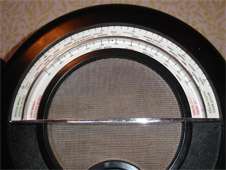
20-luvulla valmistettu englantilainen vastaanotin / A 1920’s Radio Receiver imported from the UK (Photo from Kouvolan Putkiradiomuseosäätiö)
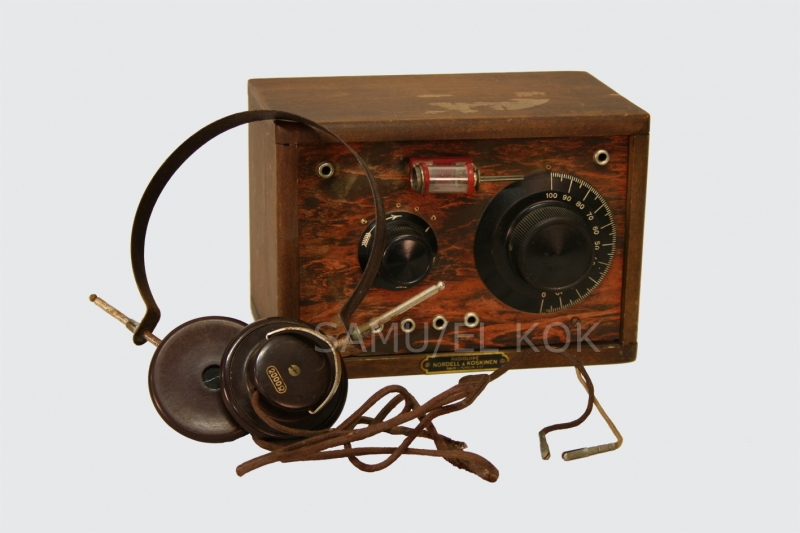
The very first radios manufactured in Finland were crystal receivers, such as this Nordell & Koskinen crystal receiver, manufactured in 1928. These were rapidly superceded by more advanced models.

1937 KVU Radio Receiver – Fenno Radio
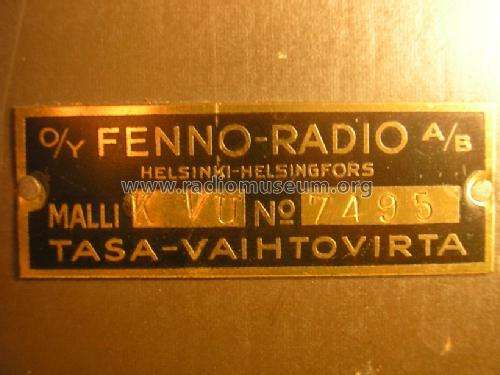
1937 KVU Radio Receiver manufacturers plate – Fenno Radio
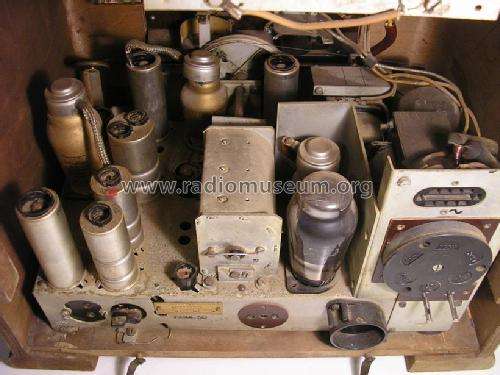
1937 KVU Radio Receiver – Fenno Radio – the inside view….
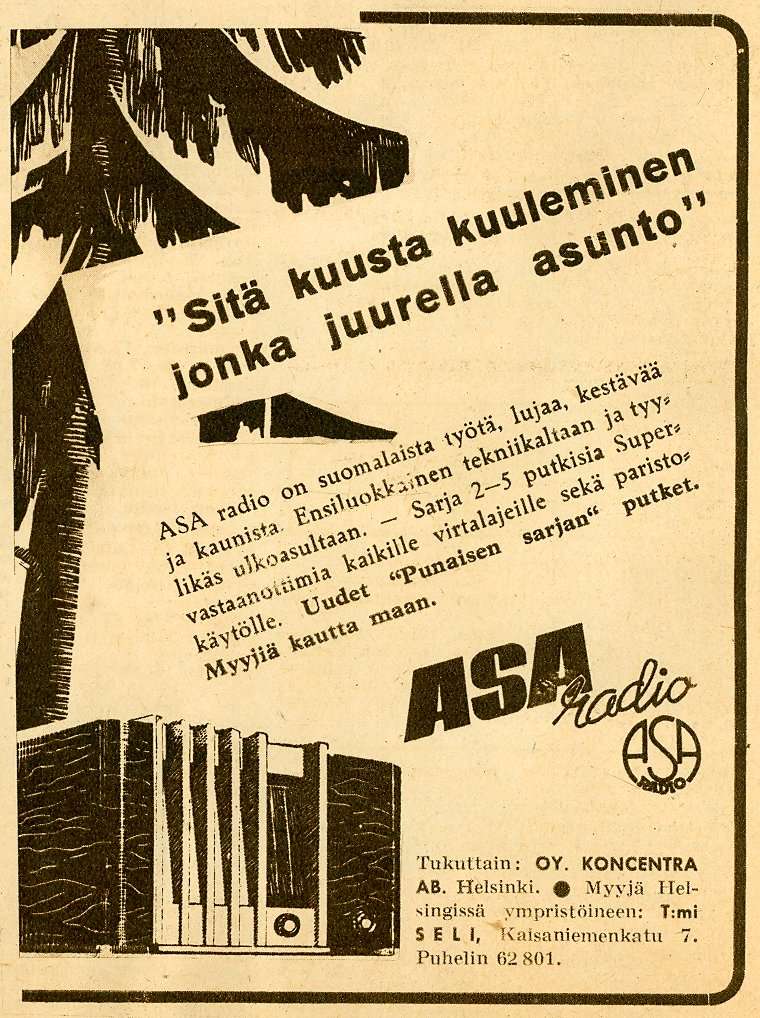

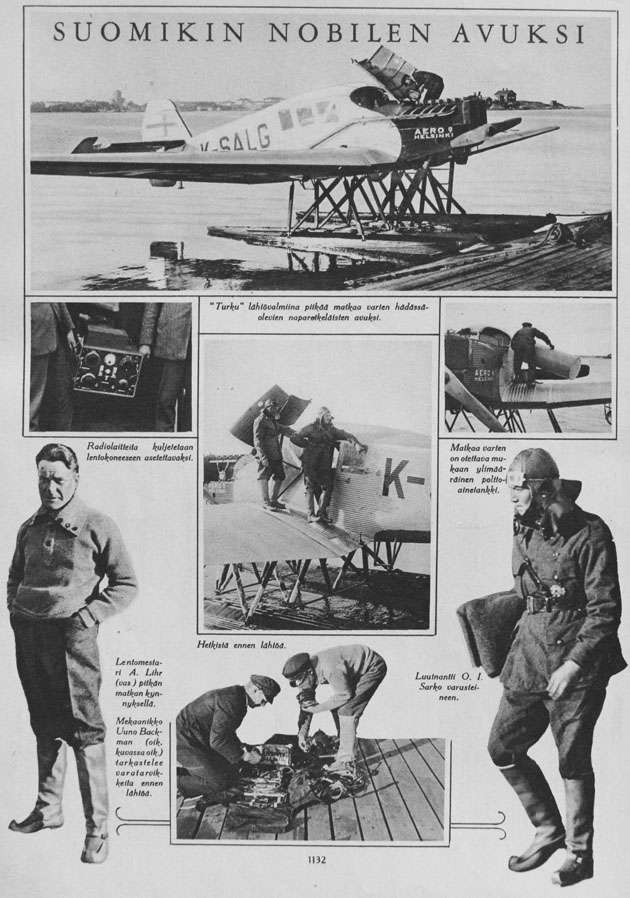
Page from 1928: note the aircraft radio being carried by two men.
In addition to radio importers and manufacturers, as with any new technology there were numerous “hobbyists” who were fascinated by the technology and who built their own radios using plans and descriptions from science magazines. Many of these would later find a niche where they could apply their hobby within the the military and in particular in the Suojeluskuntas. An example of what these amateurs could achieve was the establishment of Turku Radio (Radio Turun in Finnish): The factory was founded in 1926 in Turku and was in businessfrom 1920 to 1930. Turku Radio in the 1920’s was one of the most famous radio factories in Finland. It was highly publicized in newspapers and to a lesser extent in magazines, especially those aimed at radio amateurs and hobbyists. Turku Radio was owned by Niilo Hyrsky until 1927, in which year he was joined by an engineer, Leo Lindell. The engineer Lindell resigned from the company at the end of 1927 but continued to work with Turku Radio until the company went bankrupt in 1930. This company also produced flashlights, batteries and phones
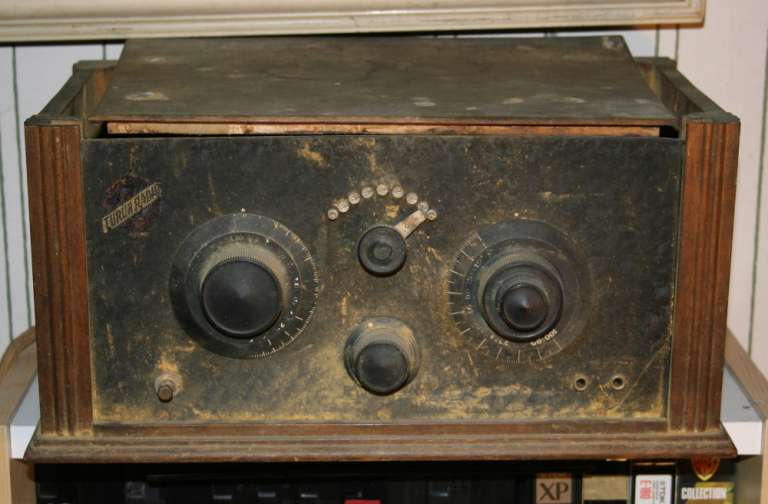
Turun radion vastaanotin T.R. 3 suunnittelijana on toiminut Leo Lindell. Radio on tekniikaltaan tyypillinen 1920-luvun lopun radio. T.R. 3 on varustettu kolmella putkella. Ensimmäisenä antennista lähtien on takaisinkytketty hilailmaisija. Kaksi muuta putkea toimivat muuntajakytkettynä äänitaajuusvahvistimena. 1Turun radio receiver T.R. 3 was the work of designer Leo Lindell. Radio technology is typical of the 1920s, at the end of the radio, the T.R. 3 is equipped with three-tubse. The first antenna is connected to the back tube and the other two tubes are connected to the transformer
As the new radio technology evolved, so to did radio broadcasting as a new medium of communications. Regular American radio broadcasts reached Finnish listeners in 1923. In 1922 in Tampere, a radio amateur, Arvi Hauvonen (1899-1973) began broadcasting with his station, Radio Tampereen, using a transmission power of 10-150 watts in the medium wave – broadcasts that he kept up from 1923 to 1930 (Arvi Hauvonen later became the director of the long-wave station in Lahti from 1929 to 1967. In his honor, as a pioneer of broadcasting in Finland, OH3R "Arvi Hauvonen Memorial Station" was inaugurated – this is an amateur radio station in the Museum of Radio and Television in Lahti, located in the old historical long-wave station of the Finnish Broadcasting Company on Radiomaki, Lahti's Radio Hill). In Helsinki on 23 March 1924, the Radiola medium wave (MW) station began with a power output of 500 W, but this Radio Station failed after six months.
The Amateur Radio Association in Lahti (Lahden Radioharrastajat ry) began transmissions in 1924. On 29 May 1926, the Finnish Broadcasting Company (Oy Suomen Yleisradio Ab in Finnish, Rundradion in Swedish) was founded in Helsinki, largely modeled on the British Broadcasting Corporation (BBC). Yleisradio’s first major transmitter was situated in Lahti because of the town's central location in Finland and it’s first radio programme was transmitted on 9 September 1926 – with the first transmissions being made from the Suojeluskuntas radio station and then the station "Army Signal Batallion, both located in Helsinki. This is the date generally considered to be the birthday of regular broadcasting activities in Finland. However, it was not until 1928 that YLE's broadcasts became available throughout the country. After this the broadcasting network was rapidly developed and by the beginning of the 1930s, 100,000 households were able to listen to YLE's programmes.
Pioneering Finnish Broadcasting Stations
Tampere - Tampere Radio Society 1923-1930
Helsinki - Army Signal Batallion 1923-1930
Helsinki - Radiola 1924
Helsinki - Finnish Home Guard 1925-1926 (transmitter of 500 W, purchased from the USA in 1923)
Hanko - Hanko Biscuit Factory Radio 1924-1925
Rauma - Rauma Radio Club 1924-1927
Jyväskylä - Radio Society of Central Finland 1925-1927
Pori - Pori Radio Society 1925-1927
Mikkeli - Mikkeli Radio Society 1925-1928
Lahti - Lahti Radio Hobbyists 1925-1927
Viipuri - Viipuri Radio Society 1926-1928
Turku - Radio Society of Turku 1926-1935 (500 W transmitter)
Pietarsaari - Radio Society of Central Bothnia 1926-1935
Kuopio – irregular transmissions over winter 1927-1927
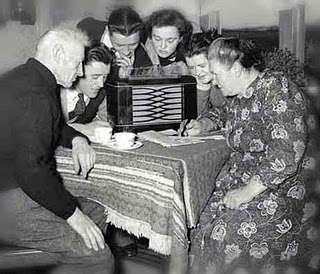
By the beginning of the 1930s, 100,000 households were able to listen to YLE's programmes. Listening to the Radio was a family, or (given the cost of radios) even a community, activity..

A family grouped around their Radio – 1936.
When established in 1926, Yleisradio as a national broadcasting company was not owned by the state but by a consortium of organizations. Neither was it granted a monopoly, even though it was awarded almost all radio-licence revenue (Radio owners had to purchase a License). Most of the shares of Yleisradio were owned by financial institutions and various businesses, over half of the company's stock was owned by the organizations of the cooperative movement, the banks and forestry and agricultural associations, and the largest single shareholder was the Finnish Radio Association. In this respect Finland differed for example from Sweden, where the corresponding programming company had been formed by the press and the radio industry and it also differed from the UK, where the originally private BBC was owned by the manufacturers of radio receivers. The role of the state in the functioning of Finnish Yleisradio was to pass broadcasting legislation permitting the collection of radio-licence fees for this company, to rule on its operating licence and to supervise its activities. The monopoly status of Yleisradio was in practice organized through a protectionist licensing policy applied by the government, not by law.
As far as principles of public service programming were concerned, Yleisradio's programming policy followed the European model. Concepts such as "dignified", "business-like", "proper", "popular education" and the "dissemination of useful education" were underlined. An important requirement was also that the programme should interest a considerable portion of audience. As a special feature, the principles were very much shaped by the agrarian conditions of Finland. A new era began in the relations between the state and Yleisradio in 1934, when Yleisradio was taken over by the state. The background to the take-over was that in the political circles of the day there was felt that there was a need to give the government a firmer grip on the only national mass medium that existed in the country. According to the act of 1934 the state exercised its powers in the shareholders' meeting, whose tasks included the appointment of the Administrative Council, Yleisradio's highest executive body.
The first central radio station in Lahti was inaugurated in 1928 (the station was designed by the German company, Telefunken) and Lahti became well-known as the “broadcasting town,” famous for its towering steel lattice aerial masts and for the radio station. The Lahti transmitter and radio masts were in use by 1928, the transmitter's initial capacity was 25 kW and rose to 40 kW in 1929 and its transmissions were augmented by Radio Societies and Clubs all over Finland retransmitting its programs At the time, Lahti was one of the most powerful radio stations in Europe. A new broadcasting station, with even more powerful transmitters, was designed by the renowned Finnish architect Kaarlo Könönen and completed in 1935. Regular broadcasting started in December 1935 with an increased capacity of 150 kW, which covered from the far south of the country as far as to Jyväskylä in Central Finland. The short wave transmitters Lahti II and Lahti III started broadcasting between 1938 and 1940 and were subsequently in operation until 1949.
It was only in 1928 that radio broadcasts could be received throughout the the entire country and by the early '30s a million Finns were able to listen to programs from YLE. Meanwhile, Yleisradio built a chain of transmitters in major cities: in 1930 in Helsinki with a power of 10 kW, in Viipuri in 1931 with a power of 10 kW, in 1931 in Oulu with a power of 1 kW, in 1933 in Tampere with a power of 1 kW, in 1933 in Pori with a power of 1 kW, in 1934 Sortavala with a power of 0.25 kW. There were lower-powered transmitters in Vaasa, Kuopio and Rovaniemi. By the year 1935 all the equipment of the surviving radio clubs was bought by the now state-owned Yleisradio.
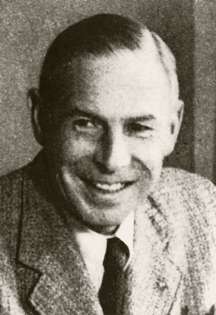
Kaarlo Könönen (1892-1965) graduated as an Architect from the Helsinki University of Technology in 1919. Between 1922-23 he was the Architect for the City of Kotka. He designed a number of classically-influenced apartment buildings in Kotka in the 1920’s. In 1924 he was employed as an Architect for the Department of Defence and between 1925-1929 he worked for a number of private architectural firms, such as Eliel Saarisen’s firm. From 1929-1955 he was the Architect for the City of Lahti, where is architectural style became closer to functionalism. His best-known designs include the Lahti Bus Terminal (1939) and the Lahti City Hall extension.

The old Lahti Radio Station – now a museum (http://www.lahdenmuseot.fi/main.php?id=295)
The growth of radio broadcasting and the rapid rise in the availability of radio receivers had a significant social impact. Right from the start, state control and the public-service ideology had consequences both for the content of the programmes on offer and the linguistic forms that were used. The language used on the radio was not just the public language but was the “official” language. There were strict requirements for grammatical correctness and clear articulation. Yet another reason for the formal quality of the language was that most of the people employed in radio broadcasting in the early days had some kind of academic education, and in their work as public broadcasters, they acted more as public officials than as journalists. Entertainment initially was mostly “high-brow” – concerts, theatre performances and literary recitations. This however changed over time as Radio proved far more effective in mass communication as compared to print media.
Radio increasingly brought unique entertainment opportunities to people, especially for those who could not afford the luxury of visiting places where entertainment was available only to the rich. With a radio set by their side, common people could enjoy music and stayed informed about events as ordinary as a street robbery to change of governments and tug of war among political rivals to availability of commodities in the market. But it was the entertainment which made the radio popular on first instance. Very soon the entertainment content expanded beyond music and comedy shows, gossip and answering letters from listeners – all of which served to expand the audience. Radio brought news to its audience far more rapidly than newspapers had and also began to be used for “political” broadcasting – including “fireside chats” which added an intimacy to political campaigning.
Radio broadcasts were used for educational purposes and also for advertising. The corporate sector almost immediately seized on the usefulness of radio as astrong medium to reach a very high number of consumers of their products and services and started buying “air-time” for this purpose. Within a decade of the first radio broadcast, an advertising sector – far more organized than the world had seen during growth of print media, became highly visible. Since the popularity of the commercial programs was largely dependent on the entertainmentor fact, new approaches to advertising were soon invented – catchy music jingles, script writing and presentation. Radio opened up a whole range of jobs never known before. To become a broadcaster with a radio station was considered to be a prestigious job in the early days of radio. The news-readers, copy writers, playwright for radio dramas, anchors for different discussion shows, musicians, recording engineers and a range of technical jobs came about so quickly that formal training was non-existent to start with.
And at the same time, the growth in Radio’s popularity and the rising audience numbers led to the appearance of a whole new sector of industry – the manufacturing, selling and repairing of Radio equipment. Finland was not unique in this – it was an experience that almost every country in Europe went through in the 1920’s and 1930’s as the new technology increasingly permeated society. In the case of Finland, a number of companies emerged in this sector. The expertise of these companies would be put to good use by the Finnish military through the decade of the 1930’s.
We’ll now go on to look at the most important of these Finnish companies, together with a short overview of the role each would play in the decade prior to the Winter War.
ASA Radio Oy
ASA Radio Oy was established by Arvo Sakrelius on 27 September, 1927 and would go on to become a major Finnish radio-equipment manufacturer. The founder of the company, Arvo Andrea Sakrelius, was born on 23rd December, 1898 to Johan Sakrelius, a small business owner and his wife, Amanda. As a schoolboy, Arvo was interested in chemistry, physics and electrical theory. A relative who lived in Viborg took the 15-year-old boy on as an assistant electrician in 1913. After returning to Turku at the age of 17 he had electrician's papers in his pocket and established himself as an electrician in Turku.
After building a number of radio-broadcast receivers, in 1927 he established a company he named after himself to manufacture radio receivers. Initially, he had one employee. Later that year he changed the name of the company and began working from a two room apartment. In 1930 he formed the company into a limited company and renamed it ASA Radio Oy. By late 1934 the company had 15 employees. In the spring of 1935 Asa Radio Ltd moved into a factory building, and in 1936, as the company expanded, he rented an old tennis club on the same property to allow for the expansion of his factory facilities. The number of employees had by 1936 grown to 120 and as the company expanded through 1937, sales branchs were established in Pori and Rauma, and the following year in Forssa. In 1938, the company manufactured approximately 12,000 radio receivers. The Radios at this time cost about 3,000 marks, which was equivalent to three months of a laborer's gross salary – they were not cheap items to buy by any means, and owning a radio was something of status symbol.
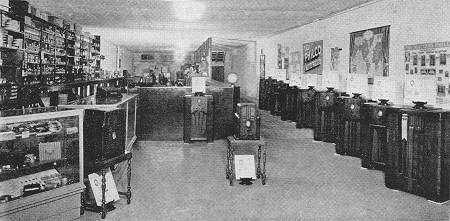
A typical ASA Radio Dealership of the 1930’s…..
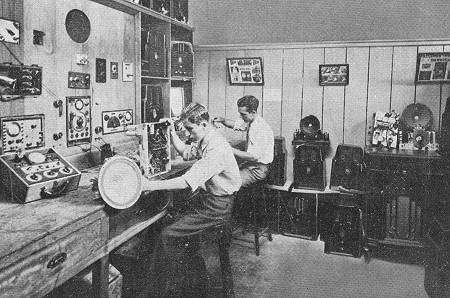
An ASA Radio Repair Workshop of the 1930’s
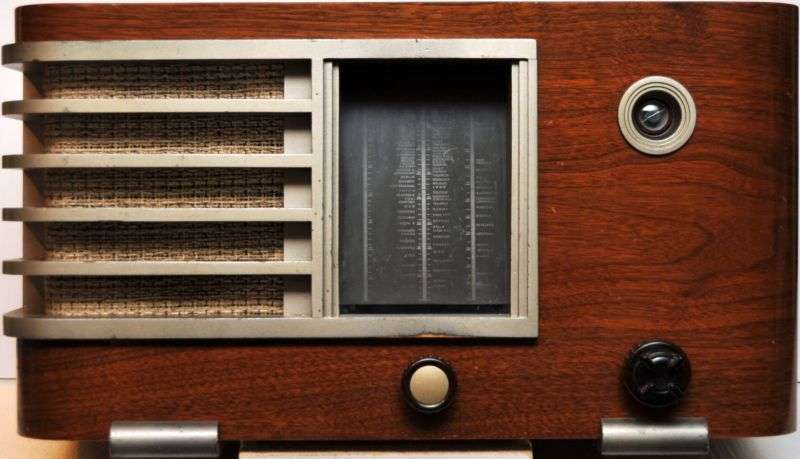
ASA Radio Receiver from the 1930’s: (Valmistusvuosi 1938. 5+1+1- putkinen, 7 -piirinen suursuper heterodyne vaihtovirtavastaanotin. Jännitealue : 110-125-225-240 V. Tehontarve n. 49 W. Aaltoalueet : 18-53 m, 198-587 m, 693-1880 m. Taikasilmä näköviritys. Putket, n.s. punaisen sarjan E- putket : EK 2, EF 5, EF 6, EL 3, EB 4, EM 1, Philips : 506, tai Triotron : G 470. PM : M2-27 / Year of manufacture 1938. 5 +1 +1 tube, 7-circuit high-super-heterodyne receiver to AC power. Voltage Range: 110-125-225-240 V Power consumption about 49 W. bands: 18-53 m, 198-587 m, 693-1880 m, Magic Eye tuning of vision. Tubes, the so-called Red E-series tubes: SS 2, EF 5 EF 6, EL 3, 4 EB, EM 1, Philips 506, or Triotron: G 470 PM: M2-2)
Initially, the radios manufactured by Asa through the mid-1920s were battery-powered radio receivers but by the beginning of the 1930s their multi-tube radios ran off mains power supply. In 1939, Asa Radio announced its first matkaradionsa (portable radio). As with other Finnish radio manufacturers, ASA manufactured radio equipment for the Finnish military, starting in ASA’s case in late 1938 as emergency funding was approved by the Government following the Munich Crisis. In ASA’s case, the size of the military order’s placed resulted in the building of a new factory assembly hall with ASA manufacturing Radios for both the Maavoimat and Ilmavoimat.
Unlike other Radio manufacturers, ASA did not design any new equipment specifically for the military. The focus of the company was on manufacturing, and this they did well, turning out radios from designs supplied by the Radio Workshop of the Armed Forces through 1939. With the outbreak of the Winter War, ASA moved to a wartime manufacturing regime, running two shifts and then three as Finnish industry attempted to meet the ongoing needs of the Suomen Maavoimat, Ilmavoimat and Merivoimat as they fought for Finland’s survival. ASA Radio had a tangible experience of the sorrows of war: the Soviet Air Force night bombing raids of January 1940, just a couple of weeks prior to the completion of a new ASA factory, destroyed the new factory’s assembly building as well as valuable raw materials and machinery. Valuable and difficult to replace measuring instruments and equipment were also destroyed in the subsequent fire.
However, ASA had retained their old facilities and were able to continue manufacturing, albeit with a reduced output. Following the Winter War, ASA Radio continued to manufacture radio and electronic equipment for the armed forces. They also manufactured components for other manufacturers, including vacuum tubes, storage batteries and other electronic equipment including items such as proximity fuses. In 1942, they began to manufacture quartz crystals and became the only Finnish supplier of these crystals, which were used in huge numbers in the next generation of Radios which the Maavoimat would go on to use in the fight against Germany. At the same time, even in the throes of the Winter War, as there was a pressing need for the equipment ASA was manufacturing manufacturing times were shaved wherever possible in a process of what we would now call continuous improvement. As an example, when ASA began to produce wave meters for the Signals Branch, it took two and a half hours to calibrate the instruments by hand – and then they required a 24 hour burn-in period before they were ready for use. ASA developed an automatic calibrator for their wave meters, which reduced the total time to prepare the meters for use to fifteen minutes.
Oy Fenno Radio Ab
The Philips Company was founded in 1891 in the Netherlands by Gerard Philips and his father Frederik as a family business. Frederik Philips, being a banker in Zaltbommel, financed the purchase and setup of a modest, empty factory building in Eindhoven, where Philips started the production of carbon-filament lamps and other electro-technical products in 1892. In 1895, after the first difficult years and going nearly bankrupt, Gerard and his father brought in Gerard’s younger brother Anton. Having earned an engineering degree, he started working as a sales representative, but soon began to contribute many important business ideas. After that, the family business began to expand rapidly, resulting in 1907 in the foundation of the N.V. Philips’ Metaalgloeilampfabriek (the Philips Lightwire-bulb Factory Inc) in Eindhoven, followed in 1912 by the foundation of the N.V. Philips' Gloeilampenfabrieken (the Philips Light-bulb Factory Inc). In 1918, Philips introduced a medical X-ray tube. This marked the beginning of the diversification of the company’s product range and the moment when it began to protect its innovations with patents in areas stretching from X-ray radiation to radio reception. In the 1920s, the company started to manufacture other products, such as vacuum tubes and in 1927 also began manufacturing Radios.
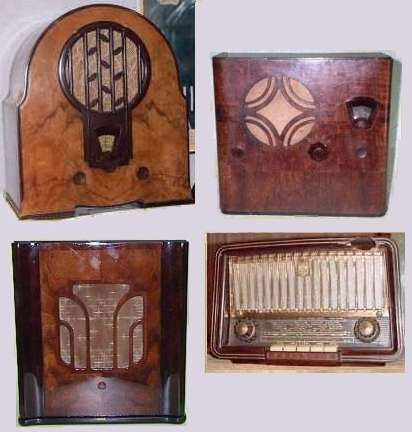
Early Philips Radios
In 1925, Philips became involved in the first experiments in television and, in 1927, began producing radios. By 1932, Philips had sold one million of them and had become the world’s largest radio producer. A year later, it produced its 100-millionth radio valve and started production of medical X-ray equipment in the United States. By 1939, when it launched the first Philips electric shaver, the company employed 45,000 people worldwide and had acquired or established subsidiary companies in many countries. Oy Fenno-Radio Ab of Helsinki was one of these subsidiaries. Originally founded by Alex Paltschik, Erik Linden and Guido Ruotzi in 1924, Philips was a minority shareholder in Fenno-Radio from the start, and as such imported or manufactured a range of Philips (and other manufacturers) products. Fenno-Radio was a major supplier for the military and was involved as well in a number of research projects. There was a security concern about the foreign shareholding and as a result, the really secretive R&D Projects were awarded to Nokia rather than Fenno. However, Fenno was always a major manufactuer and such was the demand that in 1943, the company built a new factory in Helsinki Vallila.
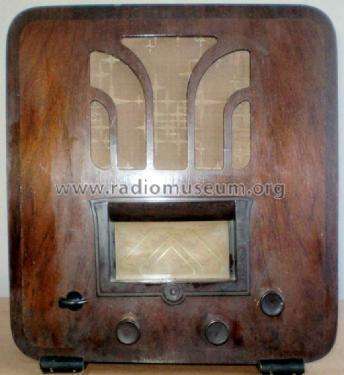
Fenno (Philips) Finland -: 947A-12 [Radio] from 1935
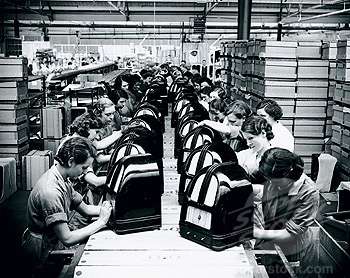
1936: Workers at the Fenno Radio manufacturing plant. Note that the workers are all women. They proved to be more suitable for fine detail, as well as being cheaper to employ.
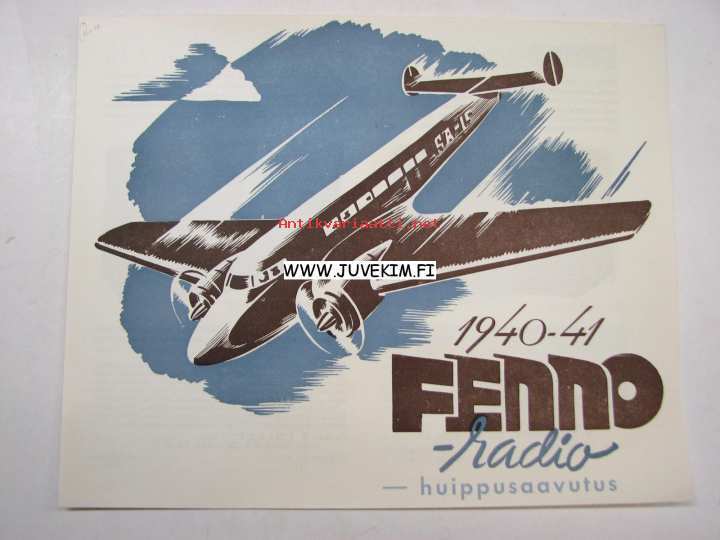
Fenno Radio advertisement from 1941
In the late 1930’s, the radio was evolving into a fairly sophisticated device and the top radio manufacturers were looking to boost sales, with marketing departments flooding newspapers and magazines with advertisement after advertisement touting various features of their radios. By now, many radio manufacturers were using some form of remote control on their deluxe and high-end models. Three types of remote control were prevalent in the 1938-39 season: wired (a tethered control box), wired radio control (similar to carrier current radio over the AC house wiring) and true wireless radio control, which is the method Philco employed (and which was distributed in Finland by Fenno Radio).
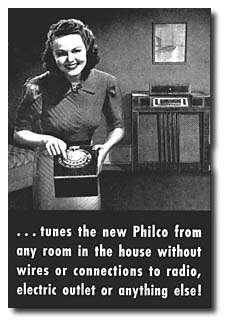
The “Mystery Control” – actually the first wireless remote in general use – in 1938-1939. The first radios Fenno manufaured for the Mystery Control (produced under license from Philco) were two top of the line sets for the 1939 model year. These models were large deluxe floor consoles. Both had hi-fidelity audio circuitry and impressive operational features as well as good looks.
Fenno dealers also held live demonstrations for the new radio line with in-store demo areas. One enterprising dealership in Vaasa had a demonstration in the front window of the store. Traffic was all but stopped. A salesman carried the control box out to the sidewalk and extension loudspeakers were placed on the sidewalk. These "wireless remote" demonstrations were very unique for their time. Many other manufacturers had radios with other forms of remote control (Fenno included) such as a wired or tethered control box or a remote box with a small built-in converter/receiver that fed the main set. No manufacturer up to this time had a completely wireless remote. Initially, the 1939 Fenno dealer catalog claimed the Mystery Control did not use a "radio beam," when it fact it was. The control box sent out RF pulses to a special receiver in the main radio cabinet.
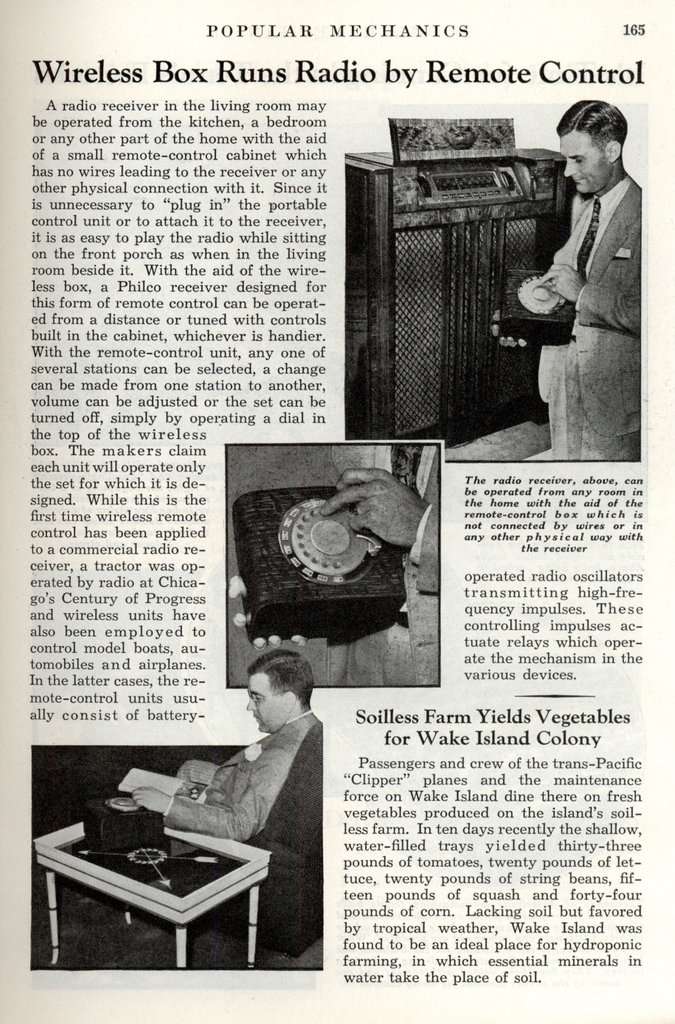
The Fenno Mystery Control --it worked just like a telephone dial. You could activate station presets, change the volume, and turn the set on and off.
With the expertise, such as it was, that Fenno acquired with manufacturing wireless remote controls, the company would go on to work closely with the Ilmavoimat through 1939 in the development of a wireless-controlled glider bomb – something that we will look at in detail a subsequent post on Finnish technical innovations over the period of 1938-1939.
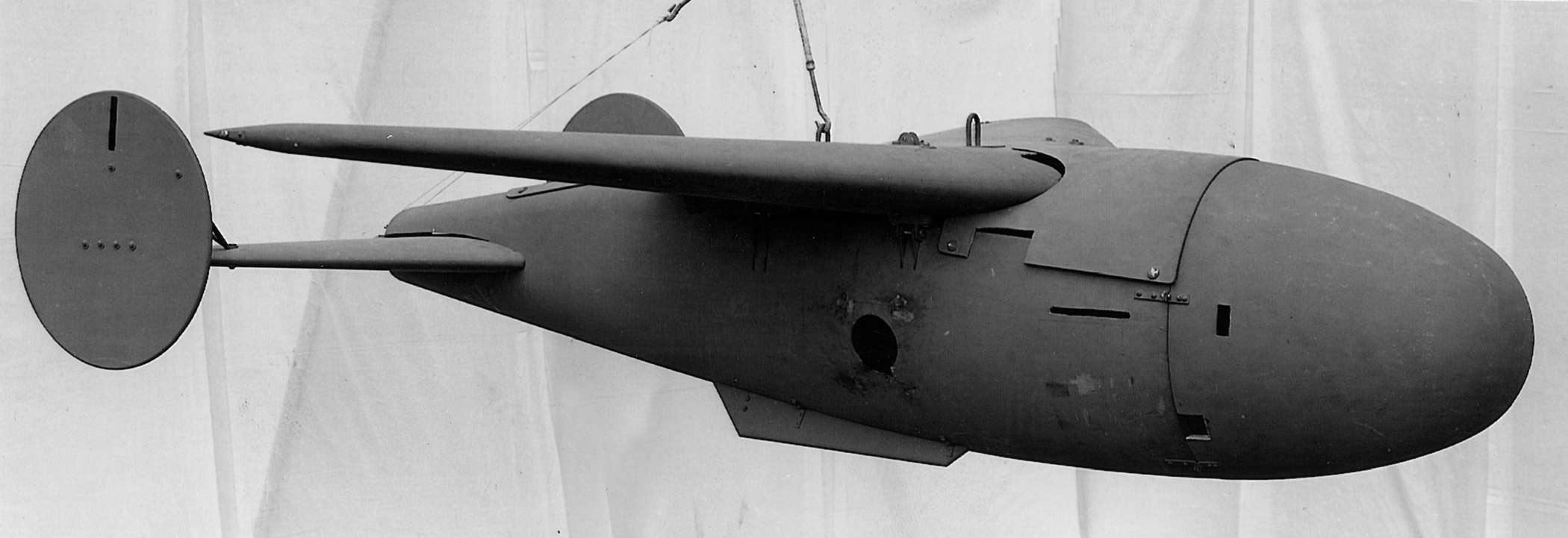
The Ilmavoimat’s Glider-Bomb: This was the world’s first true “fire and forget” bomb – and it was invented in Finland. Once dropped, the Glider Bomb went solo, guidimg itself to the target with an autonomous homing mechanism that was impervious to electronic countermeasures. The gliders were constructed primarily of plywood with a 12ft wingspan and built around a 1,000lb bomb. The guidance system was mounted in the nose. Fenno-Radio spent considerable time and effort working to devise a workable remote control guidance system for this bomb but were unsuccessful.
In actuality, a reliable wireless-controlled glider bomb was not successfully achieved, but the work that went into this project, when fortuitously combined with the research work of a junior psychologist at the University of Helsinki, Johannes Nahkuri, (who had studied at the University of Minnesota in 1937) whose older brother was an engineer on the glider-bomb project, resulted in the first “fire and forget” glider-bomb that could be dropped from well outside the range of enemy AA guns and left to guide itself onto the target. It was a weapon that the Ilmavoimat would use with devastating effectiveness in the Winter War.
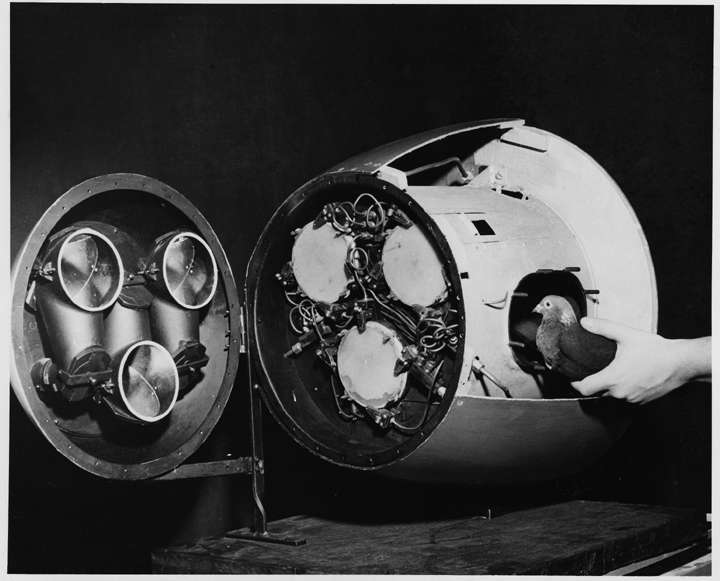
….and this is the “fire and forget autonomous homing mechanism….” Pigeons were trained to peck at an image of a target projected by a lens onto a screen in the bomb's nosecone – these signals then corrected the bomb's flight-path. In early testing, it was found that Pigeons produced excellent results & were reliable under stressful conditions including extremes in cold, vibration, acceleration, pressure, & noise.
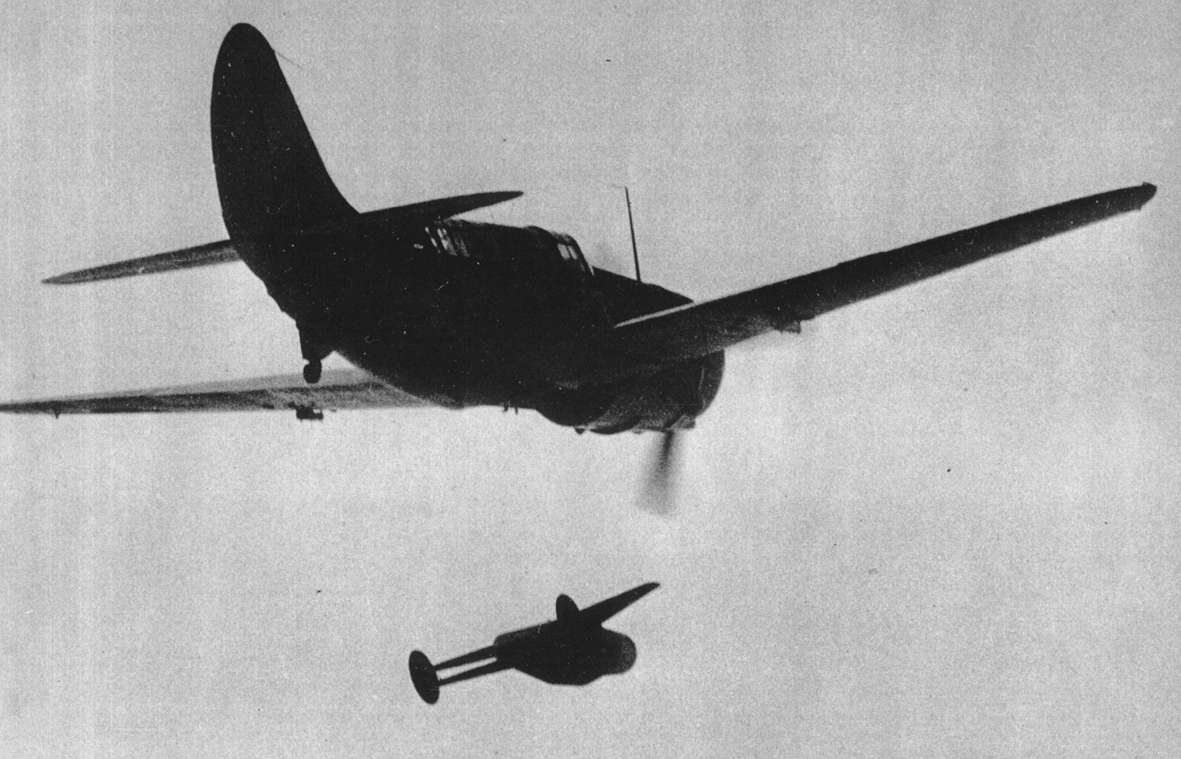
An Ilmavoimat Divebomber dropping a LintoPaska Liidokki-Pommi in trials in mid-1939. Such was the outstanding success of the trials that the Glider-Bomb (Liidokki-Pommi) was ordered into immediate production. The most challenging task was the mass-training of Pigeons and emsuring their ongoing care and training together with ensuring an adequate reserve was available, particularly in the cold of mid-winter.
The trials, tribulations and success of the LintoPaska Liidokki-Pommi Project will be covered in detail in a subsequent Post.
Helvar Oy Ab
Helvar was founded in 1921, initially to handle oil imports between Helsinki and Warsaw and expanding into the general import / export business. Later in the 1920’s, the Company’s attention turned to the radio industry. At that time, it was a pioneer in the radio industry in Finland. Beginning in 1926, the company imported radios, gramophones and records and in the 1930’s, the company started to manufacture and produce radios itself. With a growing market for radios, Helvar decided to move into manufacturing and in 1932, the company produced its first model, the Super 6/32, which was an immediate success and which immediately pushed Helvar to the forefront of radio manufacturing in Finland. A factory was opened at Pitäjänmäki in Helsinki in 1933 and in 1934 Helvar also became involved in the development of broadcasting technologies for the Radio Broadcasting industry. Also in 1934, the company was awarded the first of what would be a number of contracts from the Maavoimat for the design and manufacture of military radios.
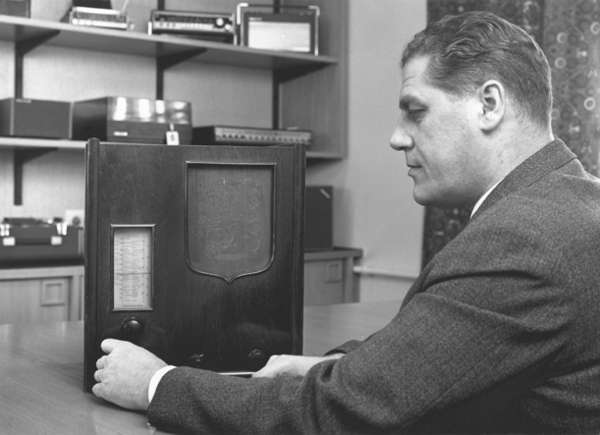
The first commercially available Helvar Radio, the 32-6. Made in the company’s factory at Pitajanmaki, Helsinki.

The Helsinki Radio Factory (Helsingin Radiotehdas) was built for Helvar between 1937 and 1941 with a 1920’s style façade. With three floors, each with an average height of three meters, the factory was well lit, with large windows and an open interior. The factory was an example of the good working conditions that many Finnish workers enjoyed by the time of the late 1930’s. (OTL, the building has been converted to a residential apartment building preserving much of the original building - http://www.ncc.fi/asunnot/paakaupunkiseutu/helsinki/radiotehdas/fi_FI/radiotehdas/)
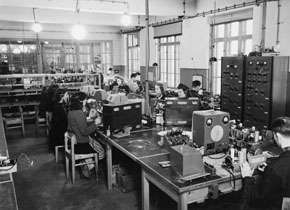
A photo of the orginal interior of the Helvar Radio Factory
Helvar was an important supplier of Radio Communications equipment to the Finnish military for the duration of the Winter War and the remainder of WW2.
In the next Post, we will look at Nokia Radio and its contributions to the effectiveness of the Finnish military.
Over the previous decade, the Maavoimat in particular, but also the Merivoimat and Ilmavoimat, had invested heavily in both the development and purchase of communications equipment and the setting up and field testing of both Radio and Field Telephone networks and their use in battle. The fact that official documents had not been updated to reflect this (these official prewar documents mention signaling flags, birds and dogs as suitable battlefield communication methods) led to Soviet Intelligence evaluating Finnish Signals capabilities completely incorrectly – yet another factor in the crushing defeat of the Soviet forces in the Winter War of 1939-1940.
Between 1931 and 1939, Finland had experienced a rapid growth in military strength, partly due to the increased financial budgets available to the Defence Forces, partly due to the rapid evolution of Finnish military doctrine and tactics and partly due to the commitment of the Finnish people to contribute their time and support to the Reserve units, in particular via the Suojeluskuntas and Lotta Svard organizations. One aspect of this growth was the ongoing commitment to the development of Finnish military-industrial capabilities – and one aspect of this was the development of Finnish communications technology capabilities. Again, this capability did not just emerge from nowhere. Finland already had, before WW2, one of the most advanced public telecommunication networks in the world. Perhaps due to the inherited characteristics of the individual citizens, in 1939 some 160,000 phones were in use for roughly 4 million people in 1939. The network was fairly dense, and many towns had automated exchanges, which is noteworthy, as Finland covers more than 300,000 square kilometers, and the vertical distances exceed 1,000 km. The Finnish broadcasting company had been operating for over a decade and a large number of radio amateurs were active.
Additionally, by the early 1930’s, there were half a dozen well-established telecommunications manufacturing companies in existence in Finland – among them Helvar, ASA, Salora, and Fenno Radio (a Philips’ subsidiary in Finland). Nokia would be a “late entry” in this field in the 1930’s but would rapidly catch up with its established competitors and become the second largest telecommunications company in Scandanavia (after Erikson) by 1939. Between them, these Finnish companies would make a substantial contribution to Finland’s military strength and military capabilities in the Winter War (and through the duration of WW2 for that matter). From post-war documents and the histories of Finnish companies in the telecommunications sector, a thread of connecting links can be found between key persons and organizations, which were once designing military electronics, but later adopted their know-how to the needs of public communications.
The Finnish military’s ongoing commitment to technical research and development through the decade of the 1930’s had kick-started expertise in specialized fields in a wide range of industries, not the least being the Finnish telecommunications industry. A long and close relationship existed between the Radio Workshop of the Armed Forces and the State Electrical Workshop (which was responsible for many Ilmavoimat radios) and the half dozen Finnish companies working in this sector. This led directly to a growth in the number of qualified communications engineers and technicians with practical skills (the growth in strength of the Signals Branch of the Maavoimat through the 1930’s in particular resulted in large numbers of Conscripts, Reservists and later, Lotta Svard members – who would in the Winter War make up the majority of rear-area Signals personnel, receiving technical training) and also, under the pressure of war-time circumstances, to radical development and innovation – which in turn led to the emergence of the present Nokia Telecommunications as an internationally known company, the well-known supplier of both microwave equipment, cellular radio systems and - not too astonishingly - modern military communications infrastructure. But in the mid to late 1930’s, this was all in the future.
Radio in Finland in the 1920’s
Funnily enough, Finland was one of the pioneering countries in the field of radio, with Russian scientist Alexander Popov carrying out broadcasting experiments with his equipment near the archipelago of Kotka in Finland, when it was a part of the Russian Empire, in 1900. Early in the 20th century, the development of radio technology saw the first radio broadcasts, with the first radio receivers (and radio broadcasting) becoming popular in the 1920s. In January 1922, the first Radio broadcast in Finland took place with the broadcasting of a public concert from Turku, a broadcast that was repeated in January 1923. Regular broadcasting began by the BBC and in the early 1920’s Radio Broadcasting came to Finland, as it did to other countries in the same period with the Finnish broadcasting corporation beginning transmissions in Finland after 1925. Taking advantage of this new technology, several small radio workshops of one or two workers sprang up in Salo at the same time.
Radio receivers in these early years were characterized by a separate speaker and adjustable wire antennae. Finland saw radios imported initially, but very quickly a number of Finnish companies began to manufacture Radio Receivers for sale to the public. Among these were a number of small local radio-manufacturing businesses such as Teknokemiallinen tehdas Vanamo, E & J Leino Oy, Järvinen & Valli, Salon Tukkukauppa, Polkupyöräliike Onni Hakala, Reilin and Kaarlo Paijola. And then there were also the companies previously listed that were destined to become larger - Helvar, ASA, Salora and Fenno Radio (a Philips’ subsidiary in Finland) and of course the late starter that was destined to become the biggest of all - Nokia. Some examples of the types of radio receivers these companies produced for sale to the public during the 1920’s are shown below, following which we will take a brief look at radio broadcasting in Finland and then at each of the larger radio manufacturing companies in turn before moving on to Military Radio and Telephone equipment and the Maavoimat’s Signals Branch history and structure.

20-luvulla valmistettu englantilainen vastaanotin / A 1920’s Radio Receiver imported from the UK (Photo from Kouvolan Putkiradiomuseosäätiö)

The very first radios manufactured in Finland were crystal receivers, such as this Nordell & Koskinen crystal receiver, manufactured in 1928. These were rapidly superceded by more advanced models.

1937 KVU Radio Receiver – Fenno Radio

1937 KVU Radio Receiver manufacturers plate – Fenno Radio

1937 KVU Radio Receiver – Fenno Radio – the inside view….


Page from 1928: note the aircraft radio being carried by two men.
In addition to radio importers and manufacturers, as with any new technology there were numerous “hobbyists” who were fascinated by the technology and who built their own radios using plans and descriptions from science magazines. Many of these would later find a niche where they could apply their hobby within the the military and in particular in the Suojeluskuntas. An example of what these amateurs could achieve was the establishment of Turku Radio (Radio Turun in Finnish): The factory was founded in 1926 in Turku and was in businessfrom 1920 to 1930. Turku Radio in the 1920’s was one of the most famous radio factories in Finland. It was highly publicized in newspapers and to a lesser extent in magazines, especially those aimed at radio amateurs and hobbyists. Turku Radio was owned by Niilo Hyrsky until 1927, in which year he was joined by an engineer, Leo Lindell. The engineer Lindell resigned from the company at the end of 1927 but continued to work with Turku Radio until the company went bankrupt in 1930. This company also produced flashlights, batteries and phones

Turun radion vastaanotin T.R. 3 suunnittelijana on toiminut Leo Lindell. Radio on tekniikaltaan tyypillinen 1920-luvun lopun radio. T.R. 3 on varustettu kolmella putkella. Ensimmäisenä antennista lähtien on takaisinkytketty hilailmaisija. Kaksi muuta putkea toimivat muuntajakytkettynä äänitaajuusvahvistimena. 1Turun radio receiver T.R. 3 was the work of designer Leo Lindell. Radio technology is typical of the 1920s, at the end of the radio, the T.R. 3 is equipped with three-tubse. The first antenna is connected to the back tube and the other two tubes are connected to the transformer
As the new radio technology evolved, so to did radio broadcasting as a new medium of communications. Regular American radio broadcasts reached Finnish listeners in 1923. In 1922 in Tampere, a radio amateur, Arvi Hauvonen (1899-1973) began broadcasting with his station, Radio Tampereen, using a transmission power of 10-150 watts in the medium wave – broadcasts that he kept up from 1923 to 1930 (Arvi Hauvonen later became the director of the long-wave station in Lahti from 1929 to 1967. In his honor, as a pioneer of broadcasting in Finland, OH3R "Arvi Hauvonen Memorial Station" was inaugurated – this is an amateur radio station in the Museum of Radio and Television in Lahti, located in the old historical long-wave station of the Finnish Broadcasting Company on Radiomaki, Lahti's Radio Hill). In Helsinki on 23 March 1924, the Radiola medium wave (MW) station began with a power output of 500 W, but this Radio Station failed after six months.
The Amateur Radio Association in Lahti (Lahden Radioharrastajat ry) began transmissions in 1924. On 29 May 1926, the Finnish Broadcasting Company (Oy Suomen Yleisradio Ab in Finnish, Rundradion in Swedish) was founded in Helsinki, largely modeled on the British Broadcasting Corporation (BBC). Yleisradio’s first major transmitter was situated in Lahti because of the town's central location in Finland and it’s first radio programme was transmitted on 9 September 1926 – with the first transmissions being made from the Suojeluskuntas radio station and then the station "Army Signal Batallion, both located in Helsinki. This is the date generally considered to be the birthday of regular broadcasting activities in Finland. However, it was not until 1928 that YLE's broadcasts became available throughout the country. After this the broadcasting network was rapidly developed and by the beginning of the 1930s, 100,000 households were able to listen to YLE's programmes.
Pioneering Finnish Broadcasting Stations
Tampere - Tampere Radio Society 1923-1930
Helsinki - Army Signal Batallion 1923-1930
Helsinki - Radiola 1924
Helsinki - Finnish Home Guard 1925-1926 (transmitter of 500 W, purchased from the USA in 1923)
Hanko - Hanko Biscuit Factory Radio 1924-1925
Rauma - Rauma Radio Club 1924-1927
Jyväskylä - Radio Society of Central Finland 1925-1927
Pori - Pori Radio Society 1925-1927
Mikkeli - Mikkeli Radio Society 1925-1928
Lahti - Lahti Radio Hobbyists 1925-1927
Viipuri - Viipuri Radio Society 1926-1928
Turku - Radio Society of Turku 1926-1935 (500 W transmitter)
Pietarsaari - Radio Society of Central Bothnia 1926-1935
Kuopio – irregular transmissions over winter 1927-1927

By the beginning of the 1930s, 100,000 households were able to listen to YLE's programmes. Listening to the Radio was a family, or (given the cost of radios) even a community, activity..

A family grouped around their Radio – 1936.
When established in 1926, Yleisradio as a national broadcasting company was not owned by the state but by a consortium of organizations. Neither was it granted a monopoly, even though it was awarded almost all radio-licence revenue (Radio owners had to purchase a License). Most of the shares of Yleisradio were owned by financial institutions and various businesses, over half of the company's stock was owned by the organizations of the cooperative movement, the banks and forestry and agricultural associations, and the largest single shareholder was the Finnish Radio Association. In this respect Finland differed for example from Sweden, where the corresponding programming company had been formed by the press and the radio industry and it also differed from the UK, where the originally private BBC was owned by the manufacturers of radio receivers. The role of the state in the functioning of Finnish Yleisradio was to pass broadcasting legislation permitting the collection of radio-licence fees for this company, to rule on its operating licence and to supervise its activities. The monopoly status of Yleisradio was in practice organized through a protectionist licensing policy applied by the government, not by law.
As far as principles of public service programming were concerned, Yleisradio's programming policy followed the European model. Concepts such as "dignified", "business-like", "proper", "popular education" and the "dissemination of useful education" were underlined. An important requirement was also that the programme should interest a considerable portion of audience. As a special feature, the principles were very much shaped by the agrarian conditions of Finland. A new era began in the relations between the state and Yleisradio in 1934, when Yleisradio was taken over by the state. The background to the take-over was that in the political circles of the day there was felt that there was a need to give the government a firmer grip on the only national mass medium that existed in the country. According to the act of 1934 the state exercised its powers in the shareholders' meeting, whose tasks included the appointment of the Administrative Council, Yleisradio's highest executive body.
The first central radio station in Lahti was inaugurated in 1928 (the station was designed by the German company, Telefunken) and Lahti became well-known as the “broadcasting town,” famous for its towering steel lattice aerial masts and for the radio station. The Lahti transmitter and radio masts were in use by 1928, the transmitter's initial capacity was 25 kW and rose to 40 kW in 1929 and its transmissions were augmented by Radio Societies and Clubs all over Finland retransmitting its programs At the time, Lahti was one of the most powerful radio stations in Europe. A new broadcasting station, with even more powerful transmitters, was designed by the renowned Finnish architect Kaarlo Könönen and completed in 1935. Regular broadcasting started in December 1935 with an increased capacity of 150 kW, which covered from the far south of the country as far as to Jyväskylä in Central Finland. The short wave transmitters Lahti II and Lahti III started broadcasting between 1938 and 1940 and were subsequently in operation until 1949.
It was only in 1928 that radio broadcasts could be received throughout the the entire country and by the early '30s a million Finns were able to listen to programs from YLE. Meanwhile, Yleisradio built a chain of transmitters in major cities: in 1930 in Helsinki with a power of 10 kW, in Viipuri in 1931 with a power of 10 kW, in 1931 in Oulu with a power of 1 kW, in 1933 in Tampere with a power of 1 kW, in 1933 in Pori with a power of 1 kW, in 1934 Sortavala with a power of 0.25 kW. There were lower-powered transmitters in Vaasa, Kuopio and Rovaniemi. By the year 1935 all the equipment of the surviving radio clubs was bought by the now state-owned Yleisradio.

Kaarlo Könönen (1892-1965) graduated as an Architect from the Helsinki University of Technology in 1919. Between 1922-23 he was the Architect for the City of Kotka. He designed a number of classically-influenced apartment buildings in Kotka in the 1920’s. In 1924 he was employed as an Architect for the Department of Defence and between 1925-1929 he worked for a number of private architectural firms, such as Eliel Saarisen’s firm. From 1929-1955 he was the Architect for the City of Lahti, where is architectural style became closer to functionalism. His best-known designs include the Lahti Bus Terminal (1939) and the Lahti City Hall extension.

The old Lahti Radio Station – now a museum (http://www.lahdenmuseot.fi/main.php?id=295)
The growth of radio broadcasting and the rapid rise in the availability of radio receivers had a significant social impact. Right from the start, state control and the public-service ideology had consequences both for the content of the programmes on offer and the linguistic forms that were used. The language used on the radio was not just the public language but was the “official” language. There were strict requirements for grammatical correctness and clear articulation. Yet another reason for the formal quality of the language was that most of the people employed in radio broadcasting in the early days had some kind of academic education, and in their work as public broadcasters, they acted more as public officials than as journalists. Entertainment initially was mostly “high-brow” – concerts, theatre performances and literary recitations. This however changed over time as Radio proved far more effective in mass communication as compared to print media.
Radio increasingly brought unique entertainment opportunities to people, especially for those who could not afford the luxury of visiting places where entertainment was available only to the rich. With a radio set by their side, common people could enjoy music and stayed informed about events as ordinary as a street robbery to change of governments and tug of war among political rivals to availability of commodities in the market. But it was the entertainment which made the radio popular on first instance. Very soon the entertainment content expanded beyond music and comedy shows, gossip and answering letters from listeners – all of which served to expand the audience. Radio brought news to its audience far more rapidly than newspapers had and also began to be used for “political” broadcasting – including “fireside chats” which added an intimacy to political campaigning.
Radio broadcasts were used for educational purposes and also for advertising. The corporate sector almost immediately seized on the usefulness of radio as astrong medium to reach a very high number of consumers of their products and services and started buying “air-time” for this purpose. Within a decade of the first radio broadcast, an advertising sector – far more organized than the world had seen during growth of print media, became highly visible. Since the popularity of the commercial programs was largely dependent on the entertainmentor fact, new approaches to advertising were soon invented – catchy music jingles, script writing and presentation. Radio opened up a whole range of jobs never known before. To become a broadcaster with a radio station was considered to be a prestigious job in the early days of radio. The news-readers, copy writers, playwright for radio dramas, anchors for different discussion shows, musicians, recording engineers and a range of technical jobs came about so quickly that formal training was non-existent to start with.
And at the same time, the growth in Radio’s popularity and the rising audience numbers led to the appearance of a whole new sector of industry – the manufacturing, selling and repairing of Radio equipment. Finland was not unique in this – it was an experience that almost every country in Europe went through in the 1920’s and 1930’s as the new technology increasingly permeated society. In the case of Finland, a number of companies emerged in this sector. The expertise of these companies would be put to good use by the Finnish military through the decade of the 1930’s.
We’ll now go on to look at the most important of these Finnish companies, together with a short overview of the role each would play in the decade prior to the Winter War.
ASA Radio Oy
ASA Radio Oy was established by Arvo Sakrelius on 27 September, 1927 and would go on to become a major Finnish radio-equipment manufacturer. The founder of the company, Arvo Andrea Sakrelius, was born on 23rd December, 1898 to Johan Sakrelius, a small business owner and his wife, Amanda. As a schoolboy, Arvo was interested in chemistry, physics and electrical theory. A relative who lived in Viborg took the 15-year-old boy on as an assistant electrician in 1913. After returning to Turku at the age of 17 he had electrician's papers in his pocket and established himself as an electrician in Turku.
After building a number of radio-broadcast receivers, in 1927 he established a company he named after himself to manufacture radio receivers. Initially, he had one employee. Later that year he changed the name of the company and began working from a two room apartment. In 1930 he formed the company into a limited company and renamed it ASA Radio Oy. By late 1934 the company had 15 employees. In the spring of 1935 Asa Radio Ltd moved into a factory building, and in 1936, as the company expanded, he rented an old tennis club on the same property to allow for the expansion of his factory facilities. The number of employees had by 1936 grown to 120 and as the company expanded through 1937, sales branchs were established in Pori and Rauma, and the following year in Forssa. In 1938, the company manufactured approximately 12,000 radio receivers. The Radios at this time cost about 3,000 marks, which was equivalent to three months of a laborer's gross salary – they were not cheap items to buy by any means, and owning a radio was something of status symbol.

A typical ASA Radio Dealership of the 1930’s…..

An ASA Radio Repair Workshop of the 1930’s

ASA Radio Receiver from the 1930’s: (Valmistusvuosi 1938. 5+1+1- putkinen, 7 -piirinen suursuper heterodyne vaihtovirtavastaanotin. Jännitealue : 110-125-225-240 V. Tehontarve n. 49 W. Aaltoalueet : 18-53 m, 198-587 m, 693-1880 m. Taikasilmä näköviritys. Putket, n.s. punaisen sarjan E- putket : EK 2, EF 5, EF 6, EL 3, EB 4, EM 1, Philips : 506, tai Triotron : G 470. PM : M2-27 / Year of manufacture 1938. 5 +1 +1 tube, 7-circuit high-super-heterodyne receiver to AC power. Voltage Range: 110-125-225-240 V Power consumption about 49 W. bands: 18-53 m, 198-587 m, 693-1880 m, Magic Eye tuning of vision. Tubes, the so-called Red E-series tubes: SS 2, EF 5 EF 6, EL 3, 4 EB, EM 1, Philips 506, or Triotron: G 470 PM: M2-2)
Initially, the radios manufactured by Asa through the mid-1920s were battery-powered radio receivers but by the beginning of the 1930s their multi-tube radios ran off mains power supply. In 1939, Asa Radio announced its first matkaradionsa (portable radio). As with other Finnish radio manufacturers, ASA manufactured radio equipment for the Finnish military, starting in ASA’s case in late 1938 as emergency funding was approved by the Government following the Munich Crisis. In ASA’s case, the size of the military order’s placed resulted in the building of a new factory assembly hall with ASA manufacturing Radios for both the Maavoimat and Ilmavoimat.
Unlike other Radio manufacturers, ASA did not design any new equipment specifically for the military. The focus of the company was on manufacturing, and this they did well, turning out radios from designs supplied by the Radio Workshop of the Armed Forces through 1939. With the outbreak of the Winter War, ASA moved to a wartime manufacturing regime, running two shifts and then three as Finnish industry attempted to meet the ongoing needs of the Suomen Maavoimat, Ilmavoimat and Merivoimat as they fought for Finland’s survival. ASA Radio had a tangible experience of the sorrows of war: the Soviet Air Force night bombing raids of January 1940, just a couple of weeks prior to the completion of a new ASA factory, destroyed the new factory’s assembly building as well as valuable raw materials and machinery. Valuable and difficult to replace measuring instruments and equipment were also destroyed in the subsequent fire.
However, ASA had retained their old facilities and were able to continue manufacturing, albeit with a reduced output. Following the Winter War, ASA Radio continued to manufacture radio and electronic equipment for the armed forces. They also manufactured components for other manufacturers, including vacuum tubes, storage batteries and other electronic equipment including items such as proximity fuses. In 1942, they began to manufacture quartz crystals and became the only Finnish supplier of these crystals, which were used in huge numbers in the next generation of Radios which the Maavoimat would go on to use in the fight against Germany. At the same time, even in the throes of the Winter War, as there was a pressing need for the equipment ASA was manufacturing manufacturing times were shaved wherever possible in a process of what we would now call continuous improvement. As an example, when ASA began to produce wave meters for the Signals Branch, it took two and a half hours to calibrate the instruments by hand – and then they required a 24 hour burn-in period before they were ready for use. ASA developed an automatic calibrator for their wave meters, which reduced the total time to prepare the meters for use to fifteen minutes.
Oy Fenno Radio Ab
The Philips Company was founded in 1891 in the Netherlands by Gerard Philips and his father Frederik as a family business. Frederik Philips, being a banker in Zaltbommel, financed the purchase and setup of a modest, empty factory building in Eindhoven, where Philips started the production of carbon-filament lamps and other electro-technical products in 1892. In 1895, after the first difficult years and going nearly bankrupt, Gerard and his father brought in Gerard’s younger brother Anton. Having earned an engineering degree, he started working as a sales representative, but soon began to contribute many important business ideas. After that, the family business began to expand rapidly, resulting in 1907 in the foundation of the N.V. Philips’ Metaalgloeilampfabriek (the Philips Lightwire-bulb Factory Inc) in Eindhoven, followed in 1912 by the foundation of the N.V. Philips' Gloeilampenfabrieken (the Philips Light-bulb Factory Inc). In 1918, Philips introduced a medical X-ray tube. This marked the beginning of the diversification of the company’s product range and the moment when it began to protect its innovations with patents in areas stretching from X-ray radiation to radio reception. In the 1920s, the company started to manufacture other products, such as vacuum tubes and in 1927 also began manufacturing Radios.

Early Philips Radios
In 1925, Philips became involved in the first experiments in television and, in 1927, began producing radios. By 1932, Philips had sold one million of them and had become the world’s largest radio producer. A year later, it produced its 100-millionth radio valve and started production of medical X-ray equipment in the United States. By 1939, when it launched the first Philips electric shaver, the company employed 45,000 people worldwide and had acquired or established subsidiary companies in many countries. Oy Fenno-Radio Ab of Helsinki was one of these subsidiaries. Originally founded by Alex Paltschik, Erik Linden and Guido Ruotzi in 1924, Philips was a minority shareholder in Fenno-Radio from the start, and as such imported or manufactured a range of Philips (and other manufacturers) products. Fenno-Radio was a major supplier for the military and was involved as well in a number of research projects. There was a security concern about the foreign shareholding and as a result, the really secretive R&D Projects were awarded to Nokia rather than Fenno. However, Fenno was always a major manufactuer and such was the demand that in 1943, the company built a new factory in Helsinki Vallila.

Fenno (Philips) Finland -: 947A-12 [Radio] from 1935

1936: Workers at the Fenno Radio manufacturing plant. Note that the workers are all women. They proved to be more suitable for fine detail, as well as being cheaper to employ.

Fenno Radio advertisement from 1941
In the late 1930’s, the radio was evolving into a fairly sophisticated device and the top radio manufacturers were looking to boost sales, with marketing departments flooding newspapers and magazines with advertisement after advertisement touting various features of their radios. By now, many radio manufacturers were using some form of remote control on their deluxe and high-end models. Three types of remote control were prevalent in the 1938-39 season: wired (a tethered control box), wired radio control (similar to carrier current radio over the AC house wiring) and true wireless radio control, which is the method Philco employed (and which was distributed in Finland by Fenno Radio).

The “Mystery Control” – actually the first wireless remote in general use – in 1938-1939. The first radios Fenno manufaured for the Mystery Control (produced under license from Philco) were two top of the line sets for the 1939 model year. These models were large deluxe floor consoles. Both had hi-fidelity audio circuitry and impressive operational features as well as good looks.
Fenno dealers also held live demonstrations for the new radio line with in-store demo areas. One enterprising dealership in Vaasa had a demonstration in the front window of the store. Traffic was all but stopped. A salesman carried the control box out to the sidewalk and extension loudspeakers were placed on the sidewalk. These "wireless remote" demonstrations were very unique for their time. Many other manufacturers had radios with other forms of remote control (Fenno included) such as a wired or tethered control box or a remote box with a small built-in converter/receiver that fed the main set. No manufacturer up to this time had a completely wireless remote. Initially, the 1939 Fenno dealer catalog claimed the Mystery Control did not use a "radio beam," when it fact it was. The control box sent out RF pulses to a special receiver in the main radio cabinet.

The Fenno Mystery Control --it worked just like a telephone dial. You could activate station presets, change the volume, and turn the set on and off.
With the expertise, such as it was, that Fenno acquired with manufacturing wireless remote controls, the company would go on to work closely with the Ilmavoimat through 1939 in the development of a wireless-controlled glider bomb – something that we will look at in detail a subsequent post on Finnish technical innovations over the period of 1938-1939.

The Ilmavoimat’s Glider-Bomb: This was the world’s first true “fire and forget” bomb – and it was invented in Finland. Once dropped, the Glider Bomb went solo, guidimg itself to the target with an autonomous homing mechanism that was impervious to electronic countermeasures. The gliders were constructed primarily of plywood with a 12ft wingspan and built around a 1,000lb bomb. The guidance system was mounted in the nose. Fenno-Radio spent considerable time and effort working to devise a workable remote control guidance system for this bomb but were unsuccessful.
In actuality, a reliable wireless-controlled glider bomb was not successfully achieved, but the work that went into this project, when fortuitously combined with the research work of a junior psychologist at the University of Helsinki, Johannes Nahkuri, (who had studied at the University of Minnesota in 1937) whose older brother was an engineer on the glider-bomb project, resulted in the first “fire and forget” glider-bomb that could be dropped from well outside the range of enemy AA guns and left to guide itself onto the target. It was a weapon that the Ilmavoimat would use with devastating effectiveness in the Winter War.

….and this is the “fire and forget autonomous homing mechanism….” Pigeons were trained to peck at an image of a target projected by a lens onto a screen in the bomb's nosecone – these signals then corrected the bomb's flight-path. In early testing, it was found that Pigeons produced excellent results & were reliable under stressful conditions including extremes in cold, vibration, acceleration, pressure, & noise.

An Ilmavoimat Divebomber dropping a LintoPaska Liidokki-Pommi in trials in mid-1939. Such was the outstanding success of the trials that the Glider-Bomb (Liidokki-Pommi) was ordered into immediate production. The most challenging task was the mass-training of Pigeons and emsuring their ongoing care and training together with ensuring an adequate reserve was available, particularly in the cold of mid-winter.
The trials, tribulations and success of the LintoPaska Liidokki-Pommi Project will be covered in detail in a subsequent Post.
Helvar Oy Ab
Helvar was founded in 1921, initially to handle oil imports between Helsinki and Warsaw and expanding into the general import / export business. Later in the 1920’s, the Company’s attention turned to the radio industry. At that time, it was a pioneer in the radio industry in Finland. Beginning in 1926, the company imported radios, gramophones and records and in the 1930’s, the company started to manufacture and produce radios itself. With a growing market for radios, Helvar decided to move into manufacturing and in 1932, the company produced its first model, the Super 6/32, which was an immediate success and which immediately pushed Helvar to the forefront of radio manufacturing in Finland. A factory was opened at Pitäjänmäki in Helsinki in 1933 and in 1934 Helvar also became involved in the development of broadcasting technologies for the Radio Broadcasting industry. Also in 1934, the company was awarded the first of what would be a number of contracts from the Maavoimat for the design and manufacture of military radios.

The first commercially available Helvar Radio, the 32-6. Made in the company’s factory at Pitajanmaki, Helsinki.

The Helsinki Radio Factory (Helsingin Radiotehdas) was built for Helvar between 1937 and 1941 with a 1920’s style façade. With three floors, each with an average height of three meters, the factory was well lit, with large windows and an open interior. The factory was an example of the good working conditions that many Finnish workers enjoyed by the time of the late 1930’s. (OTL, the building has been converted to a residential apartment building preserving much of the original building - http://www.ncc.fi/asunnot/paakaupunkiseutu/helsinki/radiotehdas/fi_FI/radiotehdas/)

A photo of the orginal interior of the Helvar Radio Factory
Helvar was an important supplier of Radio Communications equipment to the Finnish military for the duration of the Winter War and the remainder of WW2.
In the next Post, we will look at Nokia Radio and its contributions to the effectiveness of the Finnish military.
I´m loving this
But I have a question: What do you mean by LintoPaska? I got the idea that you meant bird s***, which would translate as Linnunpaska.
Kiitos Veoe, Linnunpaska it is. I was doing a dictionary translation. The grammatical correctness of my translations into Finnish is highly questionable - I'm finding it hard to teach myself the rules for that. Finnish to English I can kindof extrapolate from the context. As for the Project name, it was kind of based on the Pigeons. As in, "Goddamn linnunpaska" as you load the pigeons in and they crap all over your hands. As Pigeons do
Kiitos Veoe, Linnunpaska it is. I was doing a dictionary translation. The grammatical correctness of my translations into Finnish is highly questionable - I'm finding it hard to teach myself the rules for that. Finnish to English I can kindof extrapolate from the context. As for the Project name, it was kind of based on the Pigeons. As in, "Goddamn linnunpaska" as you load the pigeons in and they crap all over your hands. As Pigeons do.
There´s also another another thing pigeons do: they take a crap while in flight and because you can´t see it, so it´ll most likely hit you in the head
Oy Nokia Radio Ab
Oy Nokia Radio Ab
In 1927, three companies, which had been jointly owned since 1922 (Finnish Rubber Works-Suomen Gummitehdas Oy, Finnish Cable Works-Suomen Kaapelitehdas Oy and Nokia Company- Nokia Aktiebolag) were merged to form a new industrial conglomerate named Nokia Oy. Through the late 1920’s and 1930’s, Nokia Oy was involved in many industries, producing paper products, car and bicycle tires, footwear (including rubber boots and boots for the Finnish Army), communications cables, electricity generation machinery, gas masks for the Finnish Army), aluminium and chemicals. Each business unit had its own director who reported to the Nokia Corporation President.
Nokia's history starts in 1865 when mining engineer Fredrik Idestam established a groundwood pulp mill on the banks of the Tammerkoski rapids in the town of Tampere, in southwestern Finland, and started manufacturing paper. In 1868, Idestam built a second mill near the town of Nokia, fifteen kilometers (nine miles) west of Tampere by the Nokianvirta river, which had better resources for hydropower production. In 1902, Nokia added electricity generation to its business activities. In 1898, Eduard Polón founded Finnish Rubber Works, manufacturer of galoshes and other rubber products, which later became Nokia's rubber business.[29] At the beginning of the 20th century, Finnish Rubber Works established its factories near the town of Nokia and began using Nokia as its product brand. At the end of the 1910s, shortly after World War I, the Nokia Company was nearing bankruptcy. To ensure the continuation of electricity supply from Nokia's generators, Finnish Rubber Works acquired the business of the insolvent company. In 1912, Arvid Wickström founded Finnish Cable Works as a producer of telephone, telegraph and electrical cables and in 1922, Finnish Rubber Works acquired Finnish Cable Works.
Despite their reputation of being reticent, the Finns were among the forerunners in the world in the use of the telephone. The first telephone line was erected in Helsinki towards the end of 1877; only 18 months after the telephone had been patented in the United States. The first telephone company was founded in Helsinki in 1882, and 1930 a total of 815 local telephone companies had been set up in Finland. In most other countries telephony was regarded as a successor to telegraphy and hence became a state monopoly. Telephones first arrived in the largest towns, then gradually spread to smaller towns and the surrounding countryside. In urban areas telephones grew common quite rapidly. At the turn of the century Helsinki had 3.3 phones per 100 population, which was considerably more than in other towns. By 1930 there was approximately one phone for every six people.
Measured with any indicators, private telephony activity was many times more extensive than that of the State. For example, in 1932 State telephone companies had 227 exchanges whereas private telephone companies had as many as 1,998. Likewise, in the same year the State had 1,763 "subscriber apparatuses" but private telephone companies had 133,456. At the time, Telephone Services in Finland were an open market, with the state-owned telecom company having a monopoly only on trunk network calls, while most (c. 75%) of local telecommunications was provided by telephone cooperatives, with most of the actual telephones and switches being purchased from the Swedish Ericsson Company. In 1930, the newly appointed President (and former Technical Director) of Finnish Cable Works, Verner Weckman, made a case for Nokia to move into the design and maufacture of telephony equipment for the Finnish market. With the support of the Finnish Government (by way of placing orders and placing tariff barriers on imports), Nokia quickly established itself in the limited Finnish market for such equipment, at the same time gaining experience in the design and manufacturing of telephones and the new automatic switches that were slowly penetrating the telephony market.
In the 1920s and 1930s, the world telephone markets were being organized and stabilized by many governments. The fragmented town-by-town systems which had grown up over the years, serviced by many small private companies, were being integrated and offered for lease to a single company. Finland was no exception and in 1932, Nokia was awarded the contract for Finnish Telephone Services nationwide. Within two years, Nokia had expanded into Estonia and had begun selling telephones and switches to the other Baltic States and to Poland. As part of the trade deals with the USSR, in 1935 the Government secured a contract for the delivery of automated switches to the USSR, a minor order for the established European and American manufacturers but a significant sale for Nokia. By 1935, Finnish Cable was securely established as a small (by world standards) telephone equipment designer and manufacturer.
Stepping back a couple of years, the successful penetration of the telephone market by Finnish Cable Works led Nokia to consider further diversification into the field of telecommunications. The end result was that in 1933, Nokia set up Oy Nokia Radio Ab as a subsidiary company focusing on the manufacturing of Radios for the Finnish and scandanavian markets – and in this, they capitalised on their successes in the field of Telephones and Switches. Nokia Radio’s capture of market share was rapid, aided perhaps by the company’s ability to secure capital for expansion from the parent company and to manufacture German radios under license, and within two years they had become one of the largest radio manufacturers in Scandanavia.

Nokia’s Tampere Radio Factory
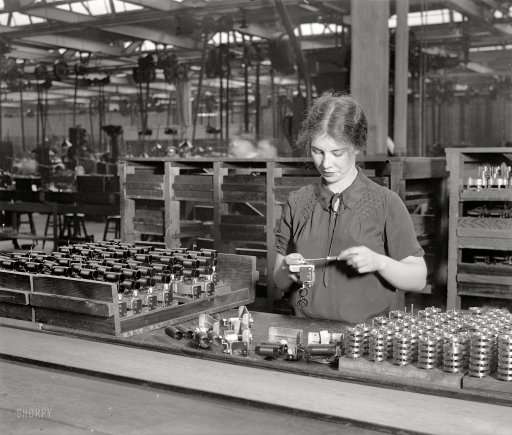
Nokia’s Tampere Radio Factory
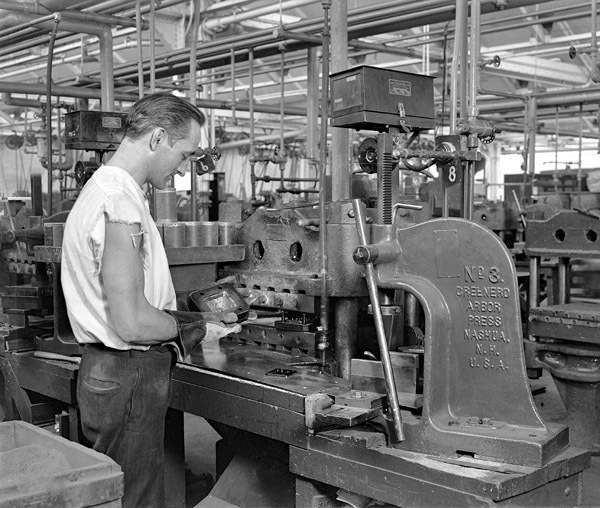
Nokia’s Tampere Radio Factory
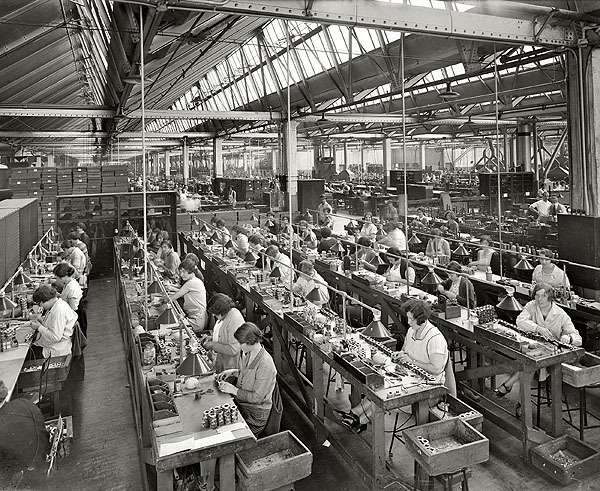
Nokia Radio factory – Tampere. Despite being a late-starter in Radio Manufacturing, Nokia soon became the largest Radio manufacturer in Finland, as well as the beneficiary of substantial R&D funding from the military. Nokia’s early interest in Radar, and the availability of corporate funding prior to R&D funding being made available from the military, led to the first Finnish Radar Stations being rushed into use by the middle of the Winter War. By the end of WW2, Nokia Radar would be a world leader in this aspect of military technology and would be exporting Radar equipment to Britain and the US.
However, Nokia would also branch out into some rather more innovative uses of Radio, although not without some initial effort on Nokia’s part. The military shrugged off Nokia's initial efforts at acquiring government R&D contracts, since in terms of telecommunications equipment the company was best known for manufacturing telephones and switchboards and for assembling radios from parts that came largely from outside sources. However, what the military wasn’t initially aware of was that the Manager of Nokia Radio, a long-standing member of the Suojeluskuntas, had on his own initiative as early as January 1935 had formed a small group of engineers to look into military-related applications for Radio. One of those engineers was Eric Tigerstedt, one of the most significant inventors in Finland in the first half of the 20th century, and a man who would later be called the "Edison of Finland". And finally, in 1937, after discussions at the highest levels of Government and the military, Oy Nokia Radio Ab was awarded an R&D Project by the military for the development of a one-man portable radio for the military.
While this was welcome, it was not the Nokia Radio engineering team’s two primary interests. At the time, the team, led by Tigerstedt, was researching the use of radio wave reflections on the one hand, and applications for the use of light waves on the other hand. We’ll look at Eric Tigerstdet, and Nokia Radar in detail in a subsequent post on Finnish technical innovations over the period of 1938-1939 and at the same time also look at one of Tigerstedt’s more innovative inventions - one that the Maavoimat made good use of in both the Winter War and the Continuation War, “Verenimijä.”
In the meantime, after a brief biogtaphy of Tigerstedt, we will go on to look at the Nokia R&D Program that led to the introduction of the one-man portable Backpack Radio into use by the Maavoimat mid-way through the Winter War.
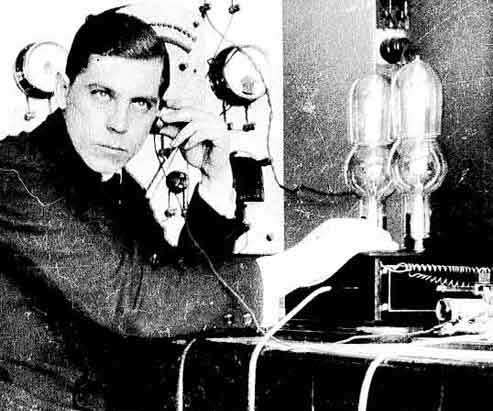
Eric Magnus Campbell Tigerstedt (August 4, 1887 – April 20, 1925) in 1935: Tigerstedt was one of the most significant inventors in Finland at the beginning of the 20th century, and has been called the "Thomas Edison of Finland". He was the first person to implement a working sound-on-film technology, and in the process, he made significant improvements to the amplification properties of the vacuum valve. Apart from improving on the design of the triode vacuum valve, he also developed directional loudspeakers. Tigerstedt also predicted such future inventions as the television and the mobile phone, and in 1917, he filed a patent for what he described as a "pocket-size, folding telephone with a very thin carbon microphone". Tigerstedt was awarded a total of 71 patents in several countries between the years 1912 and 1924.
Tigerstedt was born in Helsinki in 1887 and started to show a particular interest in all things technical already at an early age. He studied his father’s scientific books with great interest, and at age 11, built a simple photographic device. At age 13, he began experimenting with other technical devices and machines, and he built his own version of an electric motor and electrical batteries. After a fall-out with his father, he left home at the age of 15, and supported himself by working as a handyman and technician in mechanical workshops and shipyards in Helsinki. He later worked as a technician in the telephone industry, which was rapidly becoming a major business in Helsinki at this time. In 1908 Tigerstedt moved to Germany to continue his studies. He completed his high school education, and began studies in electrical engineering at the Friedrichs Polytechnikum in Köthen. After completing his studies there in 1911, he moved back to Finland with his fiancée Marjatta Nybom, whom he had met and fallen in love with while in Köthen. She had been studying the violin in Switzerland and had met Tigersted through her brother Albert Nybom, who was also studying in Köthen and who was a class mate of Tigerstedt. However, the engagement between Tigerstedt and Marjatta Nybom was broken off in 1912.
After having returned to Finland, he continued his experiments, and succeeded in building a prototype of sound-on-film technology ("talking movies"). Tigerstedt then returned to Germany in 1913, and founded a company with the Swedish merchant Axel Wahlstedt and the Swedish engineer Hugo Swartling. This was the first in a series of unsuccessful business ventures. Although Tigerstedt was able to complete his work with the sound-on-film technology, their laboratory was ultimately confiscated due to unpaid rent. They later managed to recover their laboratory, but it was then destroyed in a fire. The cooperation between Wahlstedt and Tigerstedt also become strained, and in January 1914 they dissolved their company. After breaking off their commercial partnership, Wahlstedt returned to Sweden, while Tigerstedt stayed behind in Berlin, more or less broke. Tigerstedt continued working on his sound-on-film technology, and during the process, he managed to solve a major technical problem, that of how to amplify film audio in a large theatre hall. He did this by making major improvements to the vacuum tube design of Lee De Forest, increasing the amplification properties several times. In February/March 1914, Tigerstedt demonstrated his sound-on-film technology to a small group of scientists, using his own film "Word and Picture”.
After having been expelled from Germany in July 1914, Tigerstedt returned to Finland, but moved to Sweden a few months later, and then finally to Denmark in 1915. After another unsuccessful business venture, Tigerstedt once more returned to Finland. In 1917, he moved back to Denmark, founded yet another company, which was then sold. After this, he participated in the founding of the Norwegian company A/S Anod, in which he held a 45% stake. As a Finnish citizen, Tigerstedt was called back to take part in the Finnish civil war of 1918, and on 14 February 1918 he was on his way back to Finland. After the cessation of the hostilities, he participated in the victory parade on 16 May 1918, but then returned to Denmark, where he married Ingrid Lignell in 1919. Their son Carl Axel Waldemar was born in 1921. However, their marriage soon began to deteriorate, and they separated not long after the birth of their son.
During World War I, Germany had invalidated all of Tigerstedts patents. After the war, he received compensation from the German Government, but this amount quickly became worthless due to the hyperinflation in Germany during 1921 to 1923. In 1922, Tigerstedt moved his laboratory to Finland, and he founded a new company called “Tigerstedts patenter”, which however also failed. In 1923 Tigerstedt moved to America where he founded his last company, "The Tiger Manufacturing Co", to produce small radio receivers and cryptographic devices. The Mexican government purchased 2 of the cryptographic devices, and the radio receivers also sold relatively well. Tigerstedt also had the opportunity to meet with the great American inventor Thomas Alva Edison, who wrote a letter of recommendation for Tigerstedt to the director of the Department of Commerce. On the verge of commercial success, a competitor offered to buy his company and after the offer was substantially increased, Tigerstedt accepted.
Now financially secure, Tigerstedt returned to Finland in 1925 and once more setup a new Helsinki-based company, “Oy Tigerstedt Research Ab.” We will go on to look at Tigerstedt’s work over the next ten years, as well as the development of the one-man portable Backpack Radio, in the next Post.
Oy Nokia Radio Ab
In 1927, three companies, which had been jointly owned since 1922 (Finnish Rubber Works-Suomen Gummitehdas Oy, Finnish Cable Works-Suomen Kaapelitehdas Oy and Nokia Company- Nokia Aktiebolag) were merged to form a new industrial conglomerate named Nokia Oy. Through the late 1920’s and 1930’s, Nokia Oy was involved in many industries, producing paper products, car and bicycle tires, footwear (including rubber boots and boots for the Finnish Army), communications cables, electricity generation machinery, gas masks for the Finnish Army), aluminium and chemicals. Each business unit had its own director who reported to the Nokia Corporation President.
Nokia's history starts in 1865 when mining engineer Fredrik Idestam established a groundwood pulp mill on the banks of the Tammerkoski rapids in the town of Tampere, in southwestern Finland, and started manufacturing paper. In 1868, Idestam built a second mill near the town of Nokia, fifteen kilometers (nine miles) west of Tampere by the Nokianvirta river, which had better resources for hydropower production. In 1902, Nokia added electricity generation to its business activities. In 1898, Eduard Polón founded Finnish Rubber Works, manufacturer of galoshes and other rubber products, which later became Nokia's rubber business.[29] At the beginning of the 20th century, Finnish Rubber Works established its factories near the town of Nokia and began using Nokia as its product brand. At the end of the 1910s, shortly after World War I, the Nokia Company was nearing bankruptcy. To ensure the continuation of electricity supply from Nokia's generators, Finnish Rubber Works acquired the business of the insolvent company. In 1912, Arvid Wickström founded Finnish Cable Works as a producer of telephone, telegraph and electrical cables and in 1922, Finnish Rubber Works acquired Finnish Cable Works.
Despite their reputation of being reticent, the Finns were among the forerunners in the world in the use of the telephone. The first telephone line was erected in Helsinki towards the end of 1877; only 18 months after the telephone had been patented in the United States. The first telephone company was founded in Helsinki in 1882, and 1930 a total of 815 local telephone companies had been set up in Finland. In most other countries telephony was regarded as a successor to telegraphy and hence became a state monopoly. Telephones first arrived in the largest towns, then gradually spread to smaller towns and the surrounding countryside. In urban areas telephones grew common quite rapidly. At the turn of the century Helsinki had 3.3 phones per 100 population, which was considerably more than in other towns. By 1930 there was approximately one phone for every six people.
Measured with any indicators, private telephony activity was many times more extensive than that of the State. For example, in 1932 State telephone companies had 227 exchanges whereas private telephone companies had as many as 1,998. Likewise, in the same year the State had 1,763 "subscriber apparatuses" but private telephone companies had 133,456. At the time, Telephone Services in Finland were an open market, with the state-owned telecom company having a monopoly only on trunk network calls, while most (c. 75%) of local telecommunications was provided by telephone cooperatives, with most of the actual telephones and switches being purchased from the Swedish Ericsson Company. In 1930, the newly appointed President (and former Technical Director) of Finnish Cable Works, Verner Weckman, made a case for Nokia to move into the design and maufacture of telephony equipment for the Finnish market. With the support of the Finnish Government (by way of placing orders and placing tariff barriers on imports), Nokia quickly established itself in the limited Finnish market for such equipment, at the same time gaining experience in the design and manufacturing of telephones and the new automatic switches that were slowly penetrating the telephony market.
In the 1920s and 1930s, the world telephone markets were being organized and stabilized by many governments. The fragmented town-by-town systems which had grown up over the years, serviced by many small private companies, were being integrated and offered for lease to a single company. Finland was no exception and in 1932, Nokia was awarded the contract for Finnish Telephone Services nationwide. Within two years, Nokia had expanded into Estonia and had begun selling telephones and switches to the other Baltic States and to Poland. As part of the trade deals with the USSR, in 1935 the Government secured a contract for the delivery of automated switches to the USSR, a minor order for the established European and American manufacturers but a significant sale for Nokia. By 1935, Finnish Cable was securely established as a small (by world standards) telephone equipment designer and manufacturer.
Stepping back a couple of years, the successful penetration of the telephone market by Finnish Cable Works led Nokia to consider further diversification into the field of telecommunications. The end result was that in 1933, Nokia set up Oy Nokia Radio Ab as a subsidiary company focusing on the manufacturing of Radios for the Finnish and scandanavian markets – and in this, they capitalised on their successes in the field of Telephones and Switches. Nokia Radio’s capture of market share was rapid, aided perhaps by the company’s ability to secure capital for expansion from the parent company and to manufacture German radios under license, and within two years they had become one of the largest radio manufacturers in Scandanavia.

Nokia’s Tampere Radio Factory

Nokia’s Tampere Radio Factory

Nokia’s Tampere Radio Factory

Nokia Radio factory – Tampere. Despite being a late-starter in Radio Manufacturing, Nokia soon became the largest Radio manufacturer in Finland, as well as the beneficiary of substantial R&D funding from the military. Nokia’s early interest in Radar, and the availability of corporate funding prior to R&D funding being made available from the military, led to the first Finnish Radar Stations being rushed into use by the middle of the Winter War. By the end of WW2, Nokia Radar would be a world leader in this aspect of military technology and would be exporting Radar equipment to Britain and the US.
However, Nokia would also branch out into some rather more innovative uses of Radio, although not without some initial effort on Nokia’s part. The military shrugged off Nokia's initial efforts at acquiring government R&D contracts, since in terms of telecommunications equipment the company was best known for manufacturing telephones and switchboards and for assembling radios from parts that came largely from outside sources. However, what the military wasn’t initially aware of was that the Manager of Nokia Radio, a long-standing member of the Suojeluskuntas, had on his own initiative as early as January 1935 had formed a small group of engineers to look into military-related applications for Radio. One of those engineers was Eric Tigerstedt, one of the most significant inventors in Finland in the first half of the 20th century, and a man who would later be called the "Edison of Finland". And finally, in 1937, after discussions at the highest levels of Government and the military, Oy Nokia Radio Ab was awarded an R&D Project by the military for the development of a one-man portable radio for the military.
While this was welcome, it was not the Nokia Radio engineering team’s two primary interests. At the time, the team, led by Tigerstedt, was researching the use of radio wave reflections on the one hand, and applications for the use of light waves on the other hand. We’ll look at Eric Tigerstdet, and Nokia Radar in detail in a subsequent post on Finnish technical innovations over the period of 1938-1939 and at the same time also look at one of Tigerstedt’s more innovative inventions - one that the Maavoimat made good use of in both the Winter War and the Continuation War, “Verenimijä.”
In the meantime, after a brief biogtaphy of Tigerstedt, we will go on to look at the Nokia R&D Program that led to the introduction of the one-man portable Backpack Radio into use by the Maavoimat mid-way through the Winter War.

Eric Magnus Campbell Tigerstedt (August 4, 1887 – April 20, 1925) in 1935: Tigerstedt was one of the most significant inventors in Finland at the beginning of the 20th century, and has been called the "Thomas Edison of Finland". He was the first person to implement a working sound-on-film technology, and in the process, he made significant improvements to the amplification properties of the vacuum valve. Apart from improving on the design of the triode vacuum valve, he also developed directional loudspeakers. Tigerstedt also predicted such future inventions as the television and the mobile phone, and in 1917, he filed a patent for what he described as a "pocket-size, folding telephone with a very thin carbon microphone". Tigerstedt was awarded a total of 71 patents in several countries between the years 1912 and 1924.
Tigerstedt was born in Helsinki in 1887 and started to show a particular interest in all things technical already at an early age. He studied his father’s scientific books with great interest, and at age 11, built a simple photographic device. At age 13, he began experimenting with other technical devices and machines, and he built his own version of an electric motor and electrical batteries. After a fall-out with his father, he left home at the age of 15, and supported himself by working as a handyman and technician in mechanical workshops and shipyards in Helsinki. He later worked as a technician in the telephone industry, which was rapidly becoming a major business in Helsinki at this time. In 1908 Tigerstedt moved to Germany to continue his studies. He completed his high school education, and began studies in electrical engineering at the Friedrichs Polytechnikum in Köthen. After completing his studies there in 1911, he moved back to Finland with his fiancée Marjatta Nybom, whom he had met and fallen in love with while in Köthen. She had been studying the violin in Switzerland and had met Tigersted through her brother Albert Nybom, who was also studying in Köthen and who was a class mate of Tigerstedt. However, the engagement between Tigerstedt and Marjatta Nybom was broken off in 1912.
After having returned to Finland, he continued his experiments, and succeeded in building a prototype of sound-on-film technology ("talking movies"). Tigerstedt then returned to Germany in 1913, and founded a company with the Swedish merchant Axel Wahlstedt and the Swedish engineer Hugo Swartling. This was the first in a series of unsuccessful business ventures. Although Tigerstedt was able to complete his work with the sound-on-film technology, their laboratory was ultimately confiscated due to unpaid rent. They later managed to recover their laboratory, but it was then destroyed in a fire. The cooperation between Wahlstedt and Tigerstedt also become strained, and in January 1914 they dissolved their company. After breaking off their commercial partnership, Wahlstedt returned to Sweden, while Tigerstedt stayed behind in Berlin, more or less broke. Tigerstedt continued working on his sound-on-film technology, and during the process, he managed to solve a major technical problem, that of how to amplify film audio in a large theatre hall. He did this by making major improvements to the vacuum tube design of Lee De Forest, increasing the amplification properties several times. In February/March 1914, Tigerstedt demonstrated his sound-on-film technology to a small group of scientists, using his own film "Word and Picture”.
After having been expelled from Germany in July 1914, Tigerstedt returned to Finland, but moved to Sweden a few months later, and then finally to Denmark in 1915. After another unsuccessful business venture, Tigerstedt once more returned to Finland. In 1917, he moved back to Denmark, founded yet another company, which was then sold. After this, he participated in the founding of the Norwegian company A/S Anod, in which he held a 45% stake. As a Finnish citizen, Tigerstedt was called back to take part in the Finnish civil war of 1918, and on 14 February 1918 he was on his way back to Finland. After the cessation of the hostilities, he participated in the victory parade on 16 May 1918, but then returned to Denmark, where he married Ingrid Lignell in 1919. Their son Carl Axel Waldemar was born in 1921. However, their marriage soon began to deteriorate, and they separated not long after the birth of their son.
During World War I, Germany had invalidated all of Tigerstedts patents. After the war, he received compensation from the German Government, but this amount quickly became worthless due to the hyperinflation in Germany during 1921 to 1923. In 1922, Tigerstedt moved his laboratory to Finland, and he founded a new company called “Tigerstedts patenter”, which however also failed. In 1923 Tigerstedt moved to America where he founded his last company, "The Tiger Manufacturing Co", to produce small radio receivers and cryptographic devices. The Mexican government purchased 2 of the cryptographic devices, and the radio receivers also sold relatively well. Tigerstedt also had the opportunity to meet with the great American inventor Thomas Alva Edison, who wrote a letter of recommendation for Tigerstedt to the director of the Department of Commerce. On the verge of commercial success, a competitor offered to buy his company and after the offer was substantially increased, Tigerstedt accepted.
Now financially secure, Tigerstedt returned to Finland in 1925 and once more setup a new Helsinki-based company, “Oy Tigerstedt Research Ab.” We will go on to look at Tigerstedt’s work over the next ten years, as well as the development of the one-man portable Backpack Radio, in the next Post.
But before we go on to the development by Nokia of the one-man portable Backpack Radio and of the equally unique long-range man-portable Kyynel Radio (which was developed and manufactured on a small-scale by the Finnish Army Radio Depot), we will take a final look at the last couple of Finnish Radio manufacturers.
Salora Radio Oy
In April 1928, leather salesman Fjalar Nordell and taxi driver Sulo Koskinen established Nordell & Koskinen in Salo, for the purpose of selling cars and machines. From the beginning of their business they also sold radios and radio equipment. The company produced its first commercial radio under the name Radioshop Nordell & Koskinen and began manufacturing these in Salo. In the early days Fjalar Nordell himself drove around Salo and the surrounding provinces in his Chevrolet convertible, selling radios. By the autumn of 1928 they had decided to abandon selling cars and to concentrate on manufacturing and selling their own receivers, crystal receivers and battery powered tube radios. They went on in the same year to build crystal receivers for the new Finnish broadcasting station.

Nordell & Koskinen’s crystal receiver, 1928: The crystal receiver, manufactured in 1928, was the Salo-based Nordell & Koskinen’s first own product. It was only manufactured for a short period of time in the summer and autumn of 1928. According to one of the owners, Fjalar Nordell, crystal receivers were already old news at the end of the 1920’s. They assembled crystal receivers and sold cars as well. On the front mask of the crystal receiver there was a glass tube -covered crystal that needed to be tuned to be able to listen to transmissions. Headphones were needed to listen to the crystal receiver.
As more and more of the Finnish countryside became linked in to the electrical distribution system, radio buyers moved away from the early battery-powered radios and wanted mains-powered radio receivers. Despite the depression, Nordell & Koskinen started to design and build their own mains-powered radio receivers from 1930. Koskinen was replaced by the company's second owner, Olavi Laakso, in 1936. In the same year the company introduced the Salora brand (This name was a combination of the town SALO and the product Radio).
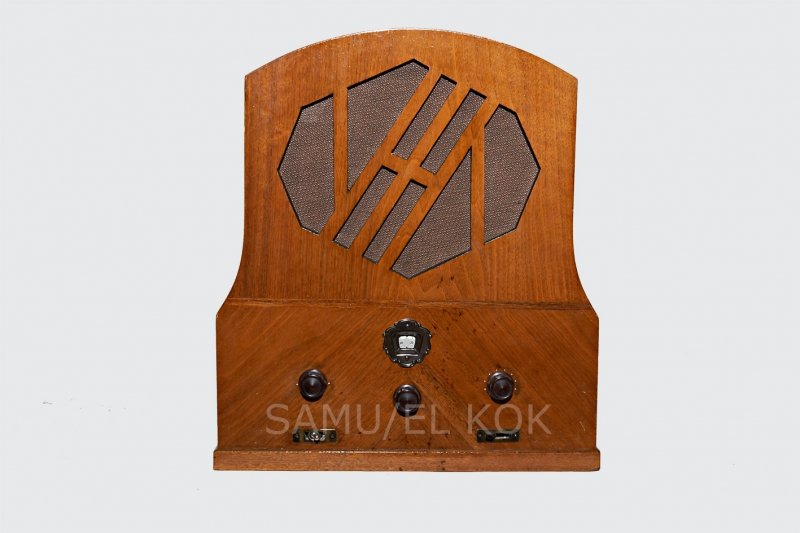
Pekka 300 VK, 1931-34: Their first mains powered receiver was completed in the autumn of 1931. It was available both with an external loudspeaker (N&K 10 and Pekka 300 V) and with a built-in loudspeaker (N&K 20 and Pekka 300 VK). The vertical Pekka 300 VK cost 2400 Fmk. An advertisement claimed that “the radio has a pleasant appearance and great volume and you can listen to dozens of foreign stations with full loudspeaker volume”.
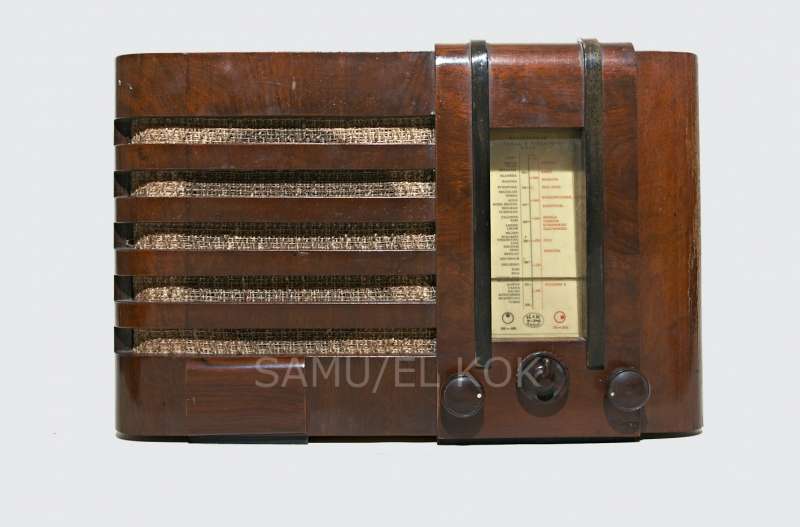
The Salora PK, 1937-38: Nordell & Koskinen (owned by Nordell & Laakso from 1936 on) manufactured the first Salora radio in 1937. The Salora PK was a battery-powered receiver with three tubes. They also manufactured a mains powered model, the Salora VK. Salora PK’s source of power was a 2-volt accumulator and a 120-volt anode battery. The catalogue states, that “the receiver had accomplished an excellent tuning precision and great sensitivity. The radio was truly fine with a beautiful sound and it was the actual ruler in its price range”.
With a workforce of some 300 employees manufacturing 15,000 radios annually, by the late 1930’s Salora was the largest radio manufacturer in Finland after Nokia. Salora was in existence from 1928 and 1995 and was the largest producer of radios and televisions in Finland. After WW2, Salora specialized in manufacturing shortwave radios, television sets and radio-telephones. In the last half of the 1930’s and through WW2, Salora was an important manufacturer of Radios for the Finnish military, as well as manufacturing crystals for military radios.
And lastly, the Estonian manufacturer Tartu Telefonivabrik AS (owned by Nokia)
Tartu Telefonivabrik was established in 1907 for the manufacturing of telephones. In 1924 the company began manufacturing radio receivers, primarily Telefunken radios produced under license. In 1929 the Finnish Nokia Oy become the largest shareholder, at which time the main product was still telephones, even though TTV was the biggest exporter of radio receivers in Estonia. TTV was an interesting hub on Nokia’s rapidly growing multinational telephone business. Nokia had a strong interest in the growing markets of the Baltic peripheral and invested heavily in the factory. TTV produced Nokia telephone equipment and switches under license. A large percentage o the factory’s production was exported to Latvia and Lithuania, as well as to the USSR. Although Tartu was not an R&D center for Nokia, the Estonian factory’s products were well-known both domestically and abroad for their surprisingly good quality and construction, which in combination with their low prices led to the factory continuously winning tenders not only in the Baltic Sea region but also in China, Turkey, Persia and other countries.
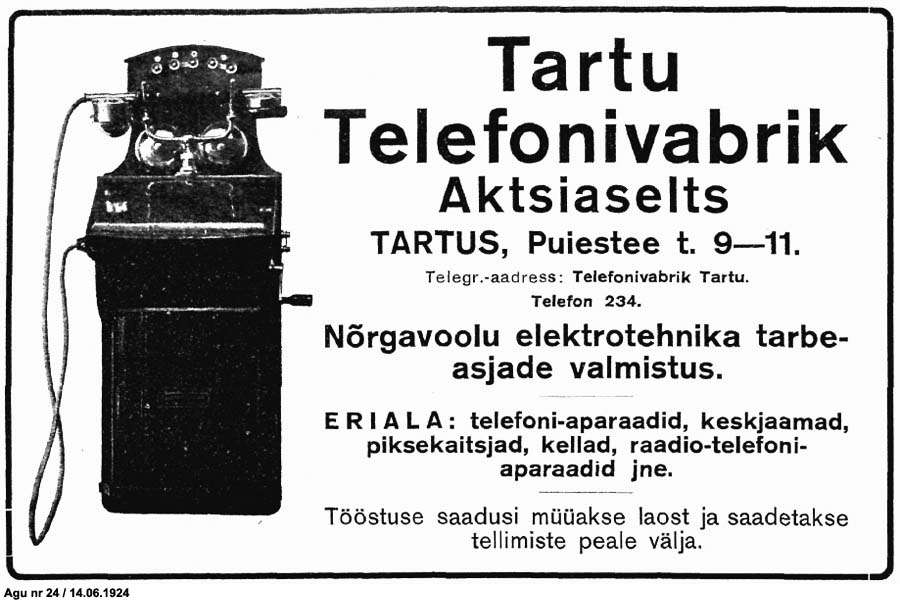
1924 Advertisement for Tartu Telefonivabrik
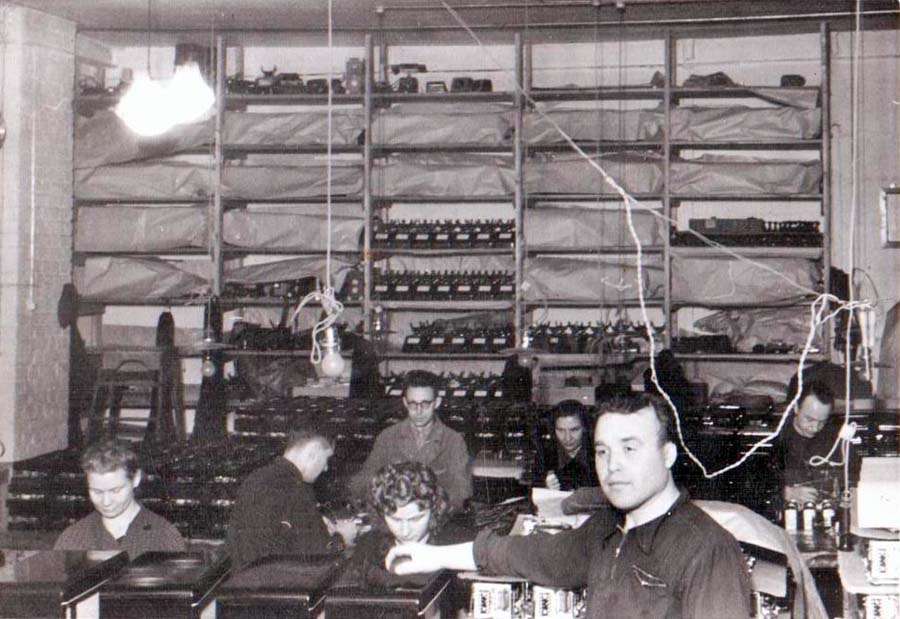
The Nokia-owned Tartu Telefonivabrik factory
While the Finnish military used Tartu Telefonivabrik manufactured equipment, the TTV factory did not supply the Finnish military with any equipment during the Winter War. The Red Army units based in Finland from late 1939 saw to this. The subsequent overrunning of Estonia in early 1940 by the USSR, despite the gallant fight put up by the outnumber Estonian armed forces resulted in the almost complete destruction of the Tartu factory by the Estonians as they carried out a fighting retreat to the Tallinn redoubt.
Next: An overview of Finnish military radios, followed by an overview of the development by Nokia of the one-man portable Backpack Radio and the equally unique long-range man-portable Kyynel Radio (developed and manufactured on a small-scale by the Finnish Army Radio Depot). After this, we'll cover Signals Unit organisation within a typical Field Infantry Division circa 1939. And then... we'll return to Forest Service Aircraft and take a look at Forest Service Waterbombers and some of the unintended spinoffs from waterbombing....
Salora Radio Oy
In April 1928, leather salesman Fjalar Nordell and taxi driver Sulo Koskinen established Nordell & Koskinen in Salo, for the purpose of selling cars and machines. From the beginning of their business they also sold radios and radio equipment. The company produced its first commercial radio under the name Radioshop Nordell & Koskinen and began manufacturing these in Salo. In the early days Fjalar Nordell himself drove around Salo and the surrounding provinces in his Chevrolet convertible, selling radios. By the autumn of 1928 they had decided to abandon selling cars and to concentrate on manufacturing and selling their own receivers, crystal receivers and battery powered tube radios. They went on in the same year to build crystal receivers for the new Finnish broadcasting station.

Nordell & Koskinen’s crystal receiver, 1928: The crystal receiver, manufactured in 1928, was the Salo-based Nordell & Koskinen’s first own product. It was only manufactured for a short period of time in the summer and autumn of 1928. According to one of the owners, Fjalar Nordell, crystal receivers were already old news at the end of the 1920’s. They assembled crystal receivers and sold cars as well. On the front mask of the crystal receiver there was a glass tube -covered crystal that needed to be tuned to be able to listen to transmissions. Headphones were needed to listen to the crystal receiver.
As more and more of the Finnish countryside became linked in to the electrical distribution system, radio buyers moved away from the early battery-powered radios and wanted mains-powered radio receivers. Despite the depression, Nordell & Koskinen started to design and build their own mains-powered radio receivers from 1930. Koskinen was replaced by the company's second owner, Olavi Laakso, in 1936. In the same year the company introduced the Salora brand (This name was a combination of the town SALO and the product Radio).

Pekka 300 VK, 1931-34: Their first mains powered receiver was completed in the autumn of 1931. It was available both with an external loudspeaker (N&K 10 and Pekka 300 V) and with a built-in loudspeaker (N&K 20 and Pekka 300 VK). The vertical Pekka 300 VK cost 2400 Fmk. An advertisement claimed that “the radio has a pleasant appearance and great volume and you can listen to dozens of foreign stations with full loudspeaker volume”.

The Salora PK, 1937-38: Nordell & Koskinen (owned by Nordell & Laakso from 1936 on) manufactured the first Salora radio in 1937. The Salora PK was a battery-powered receiver with three tubes. They also manufactured a mains powered model, the Salora VK. Salora PK’s source of power was a 2-volt accumulator and a 120-volt anode battery. The catalogue states, that “the receiver had accomplished an excellent tuning precision and great sensitivity. The radio was truly fine with a beautiful sound and it was the actual ruler in its price range”.
With a workforce of some 300 employees manufacturing 15,000 radios annually, by the late 1930’s Salora was the largest radio manufacturer in Finland after Nokia. Salora was in existence from 1928 and 1995 and was the largest producer of radios and televisions in Finland. After WW2, Salora specialized in manufacturing shortwave radios, television sets and radio-telephones. In the last half of the 1930’s and through WW2, Salora was an important manufacturer of Radios for the Finnish military, as well as manufacturing crystals for military radios.
And lastly, the Estonian manufacturer Tartu Telefonivabrik AS (owned by Nokia)
Tartu Telefonivabrik was established in 1907 for the manufacturing of telephones. In 1924 the company began manufacturing radio receivers, primarily Telefunken radios produced under license. In 1929 the Finnish Nokia Oy become the largest shareholder, at which time the main product was still telephones, even though TTV was the biggest exporter of radio receivers in Estonia. TTV was an interesting hub on Nokia’s rapidly growing multinational telephone business. Nokia had a strong interest in the growing markets of the Baltic peripheral and invested heavily in the factory. TTV produced Nokia telephone equipment and switches under license. A large percentage o the factory’s production was exported to Latvia and Lithuania, as well as to the USSR. Although Tartu was not an R&D center for Nokia, the Estonian factory’s products were well-known both domestically and abroad for their surprisingly good quality and construction, which in combination with their low prices led to the factory continuously winning tenders not only in the Baltic Sea region but also in China, Turkey, Persia and other countries.

1924 Advertisement for Tartu Telefonivabrik

The Nokia-owned Tartu Telefonivabrik factory
While the Finnish military used Tartu Telefonivabrik manufactured equipment, the TTV factory did not supply the Finnish military with any equipment during the Winter War. The Red Army units based in Finland from late 1939 saw to this. The subsequent overrunning of Estonia in early 1940 by the USSR, despite the gallant fight put up by the outnumber Estonian armed forces resulted in the almost complete destruction of the Tartu factory by the Estonians as they carried out a fighting retreat to the Tallinn redoubt.
Next: An overview of Finnish military radios, followed by an overview of the development by Nokia of the one-man portable Backpack Radio and the equally unique long-range man-portable Kyynel Radio (developed and manufactured on a small-scale by the Finnish Army Radio Depot). After this, we'll cover Signals Unit organisation within a typical Field Infantry Division circa 1939. And then... we'll return to Forest Service Aircraft and take a look at Forest Service Waterbombers and some of the unintended spinoffs from waterbombing....
Share:
